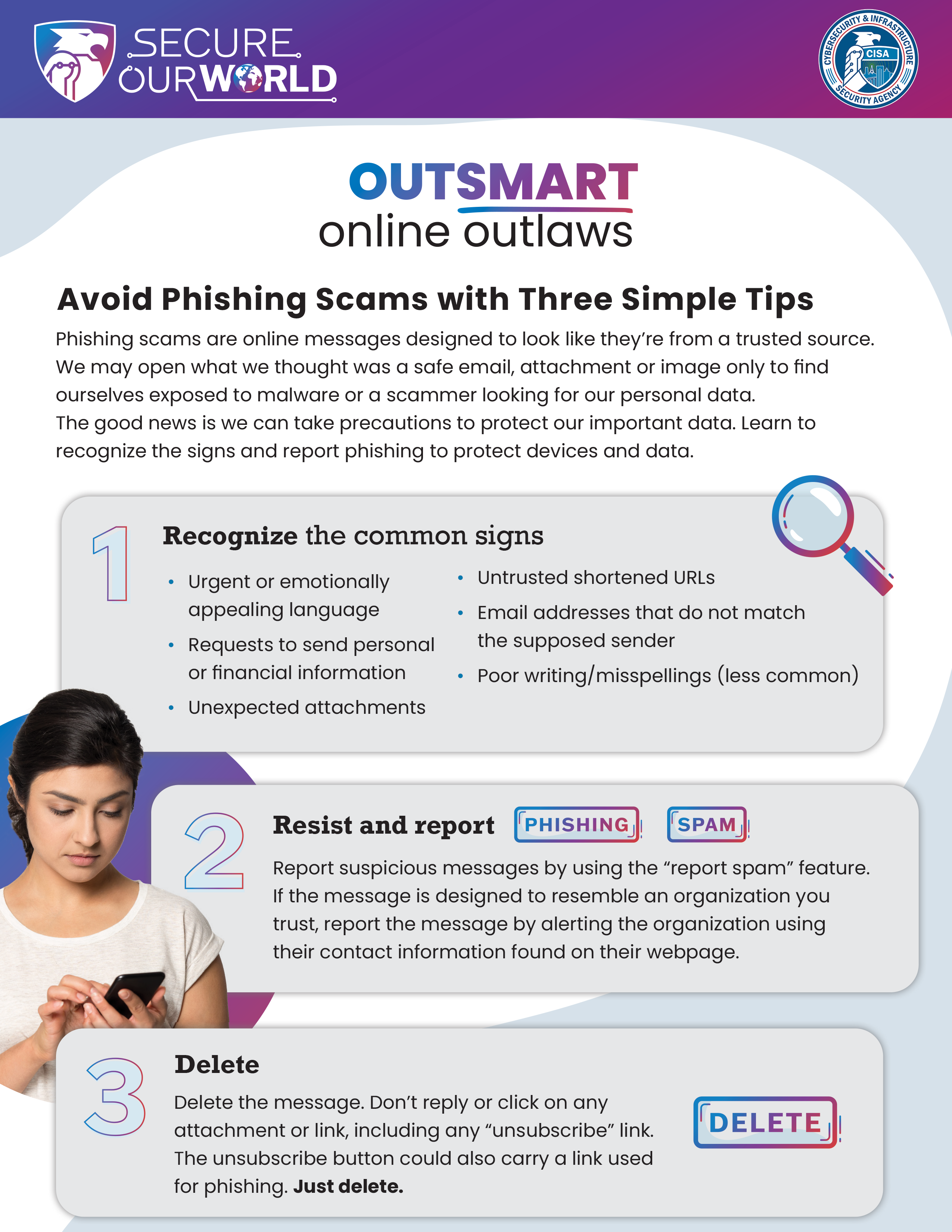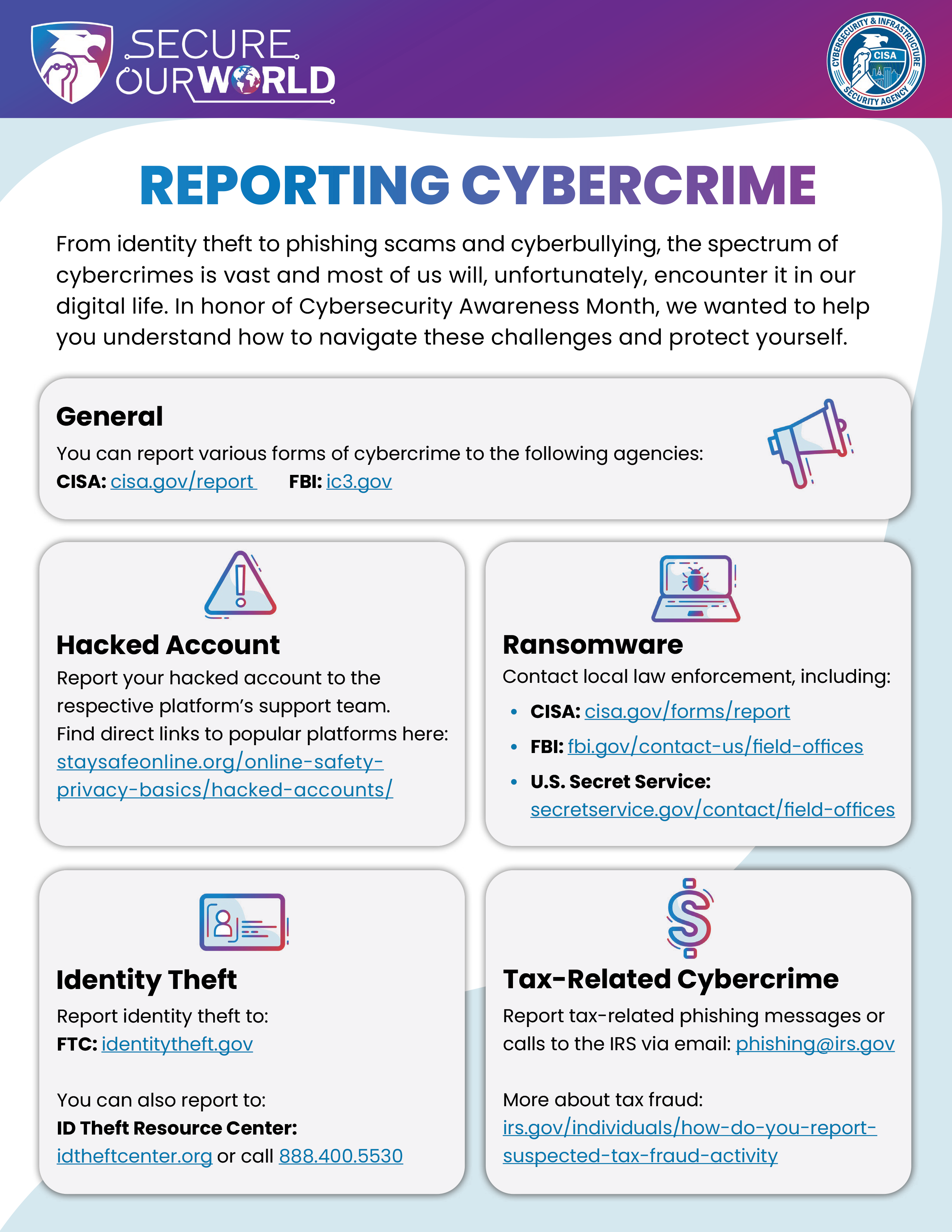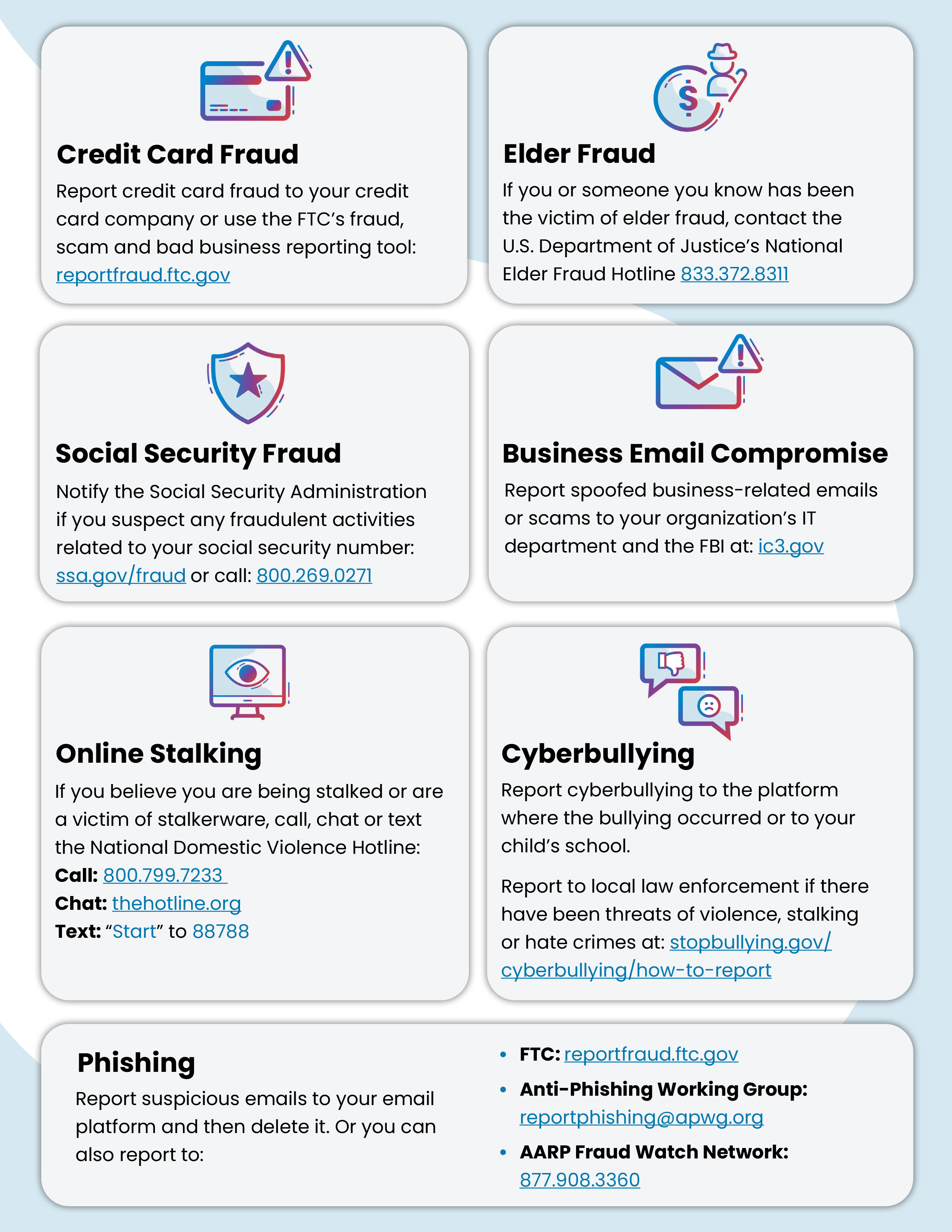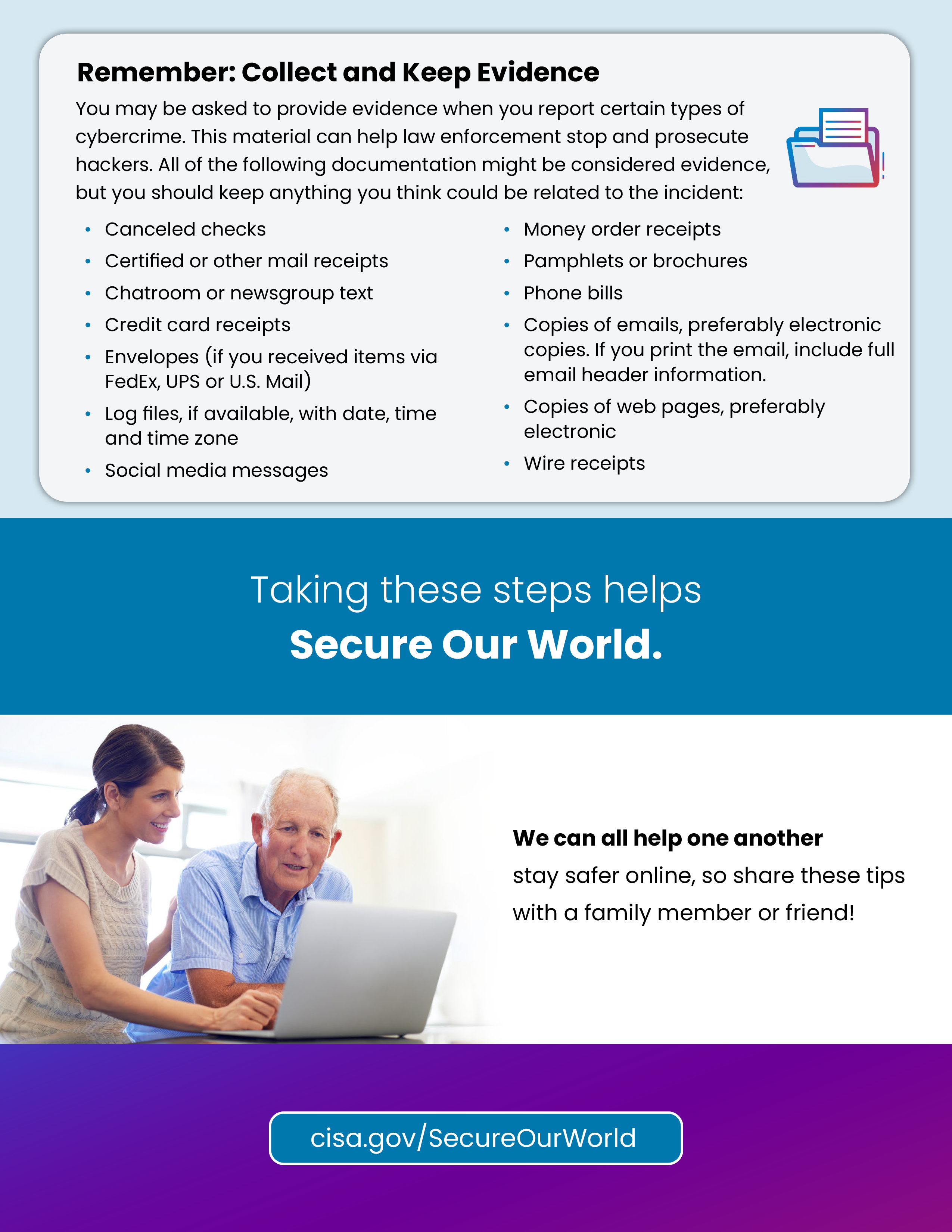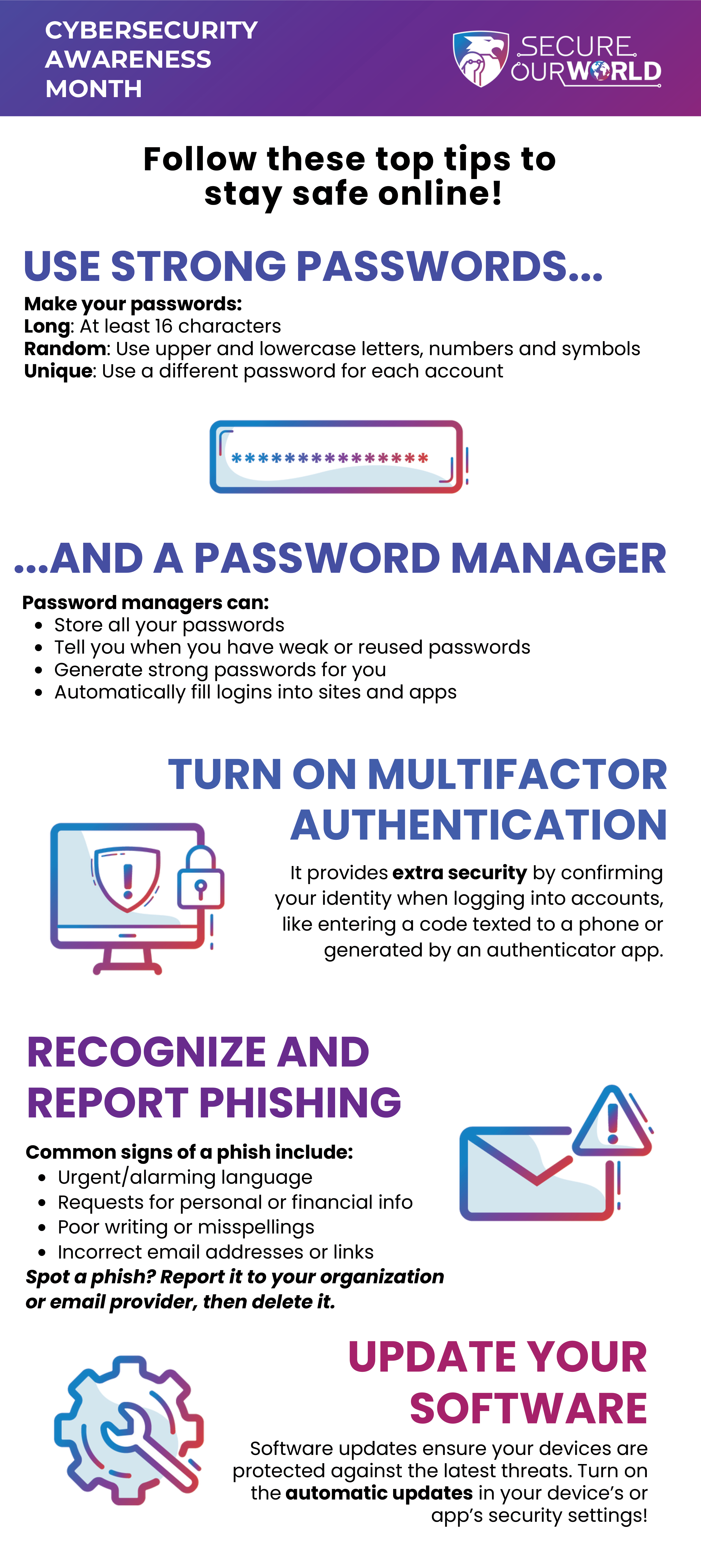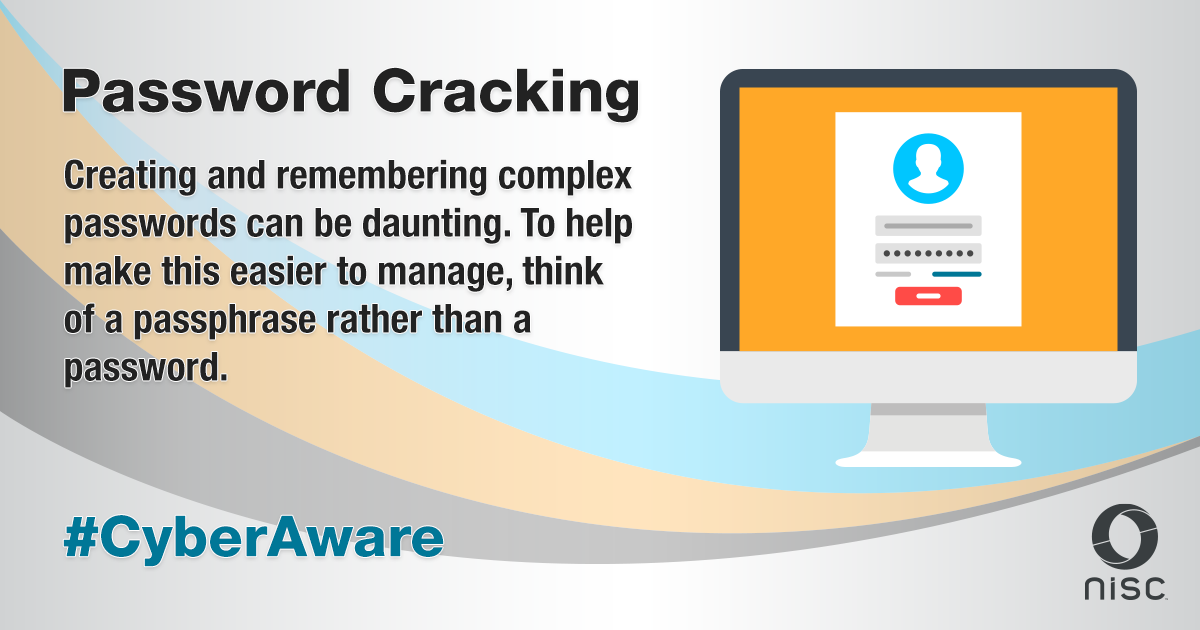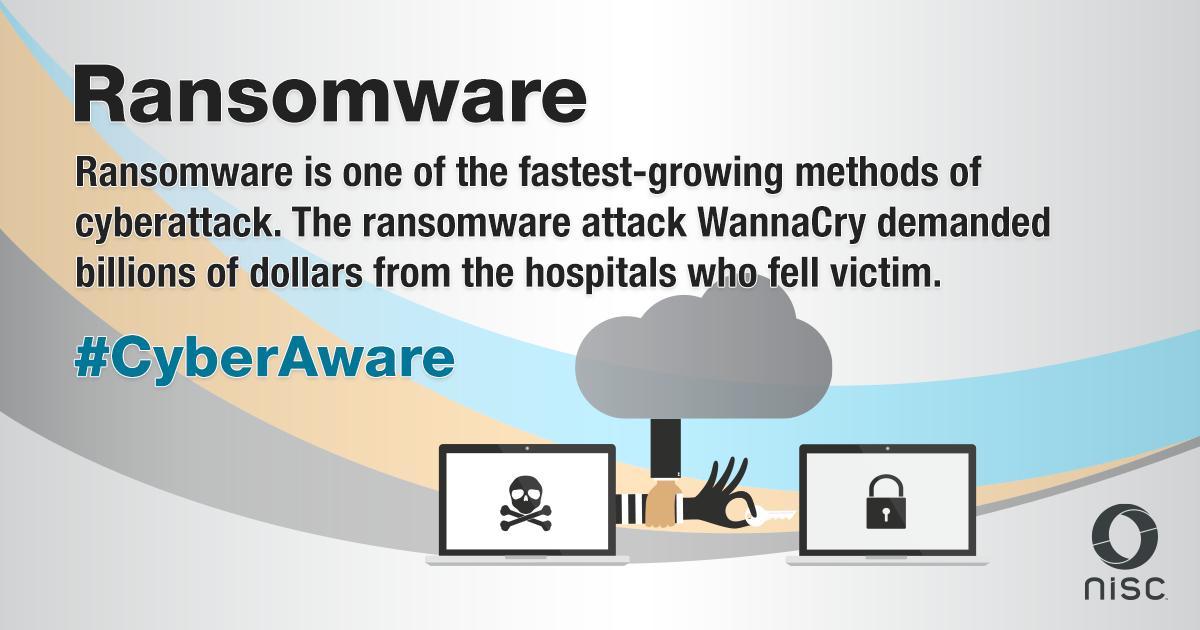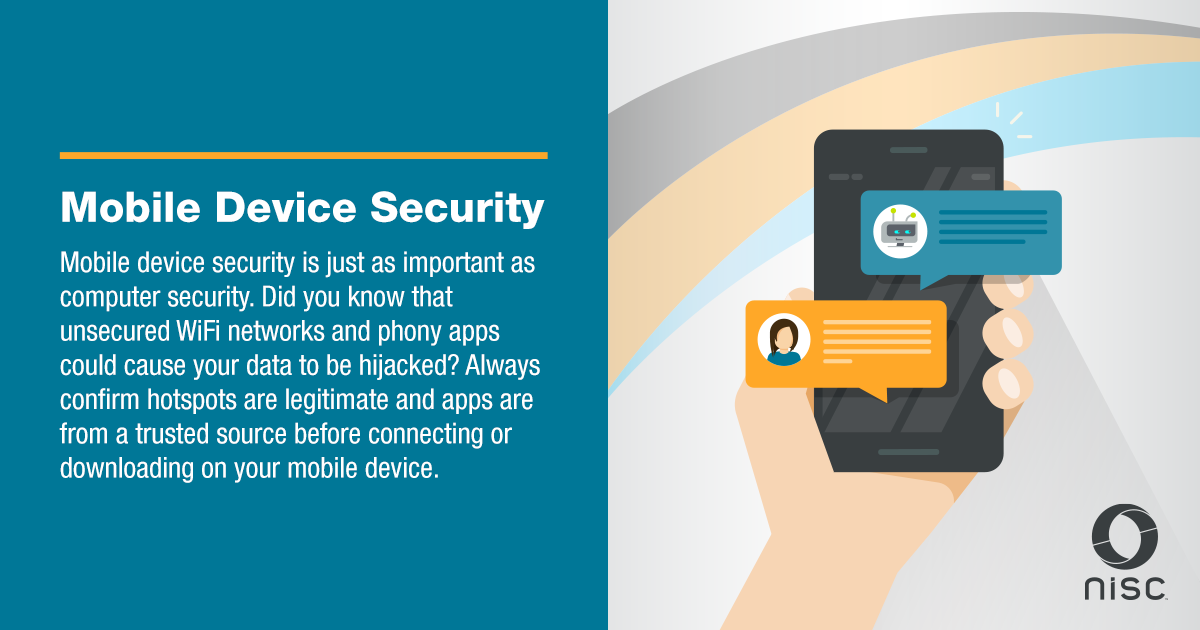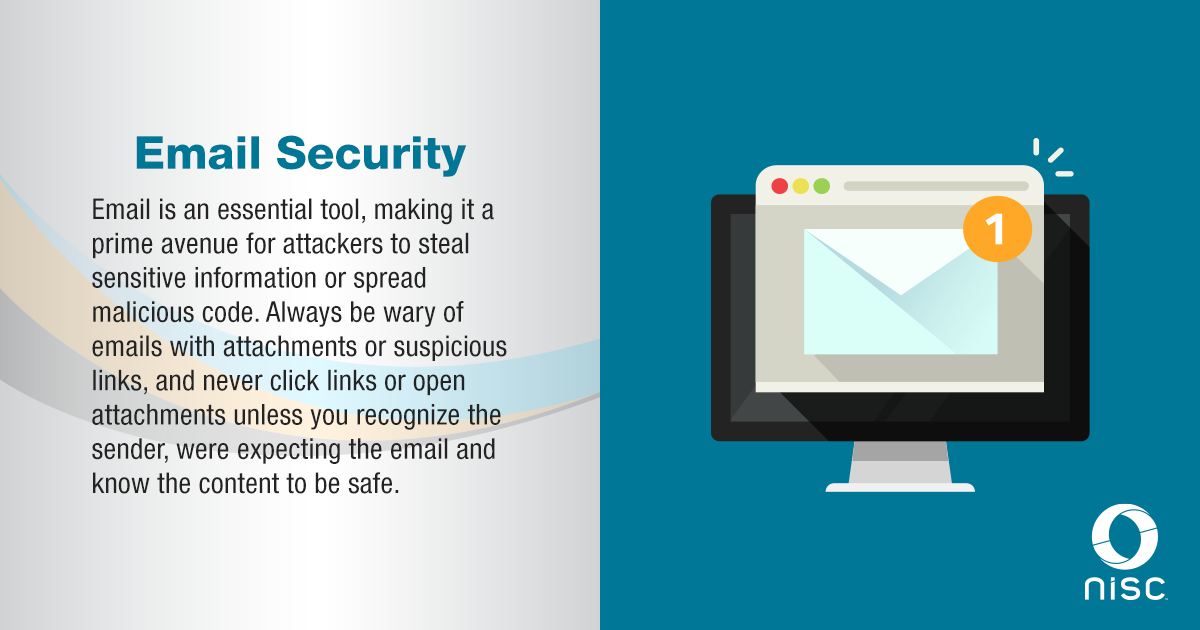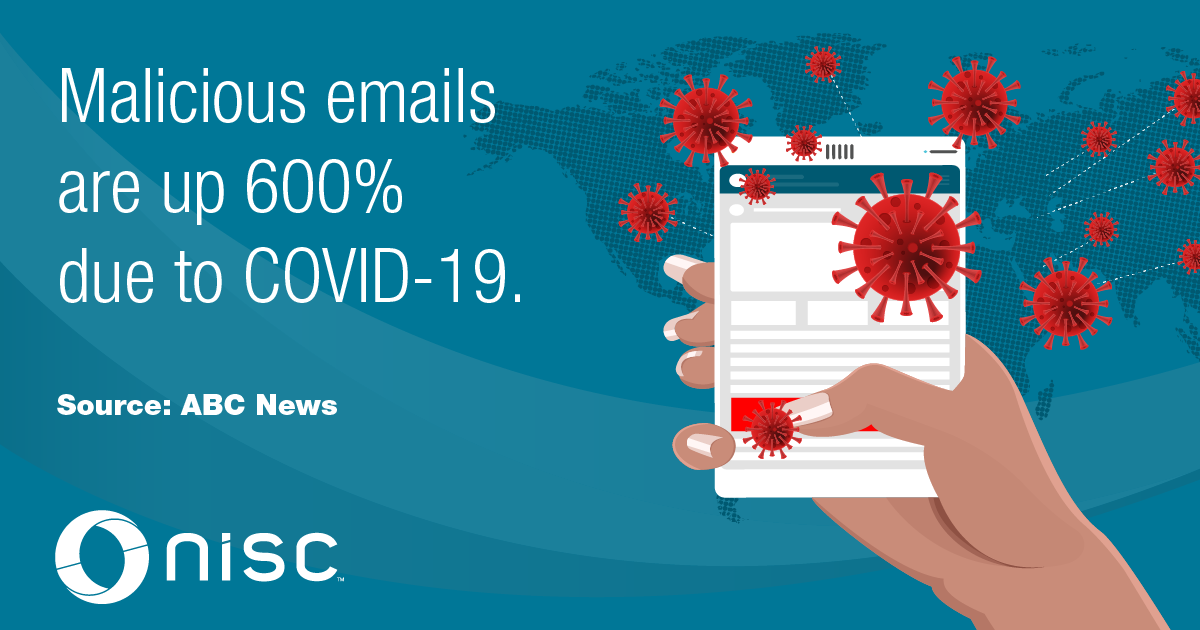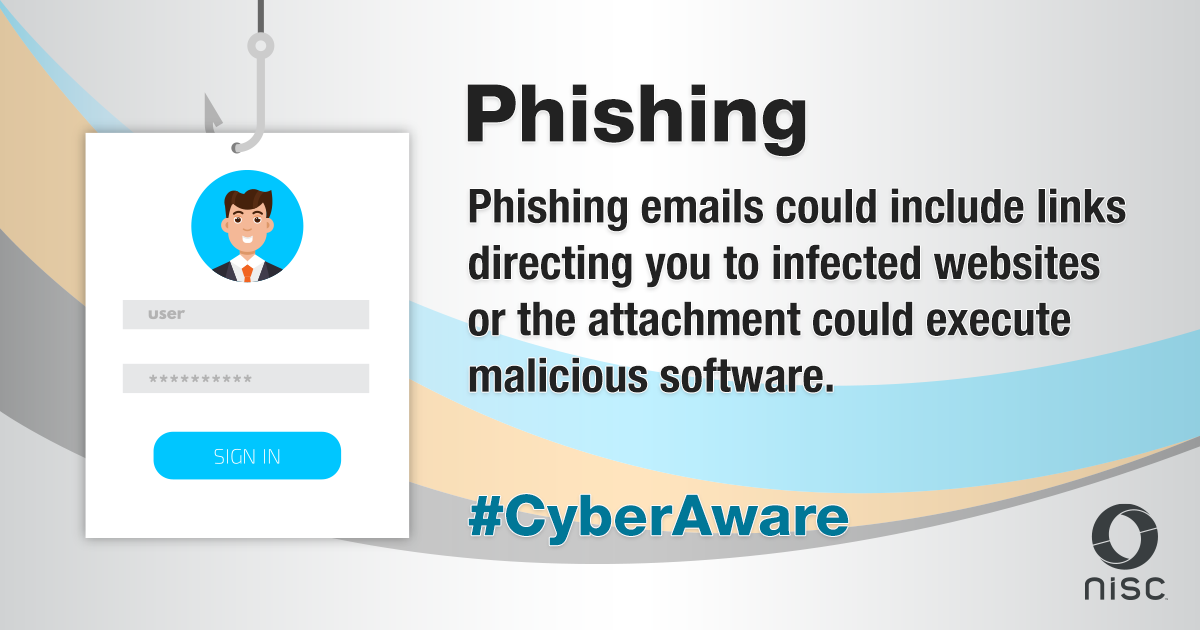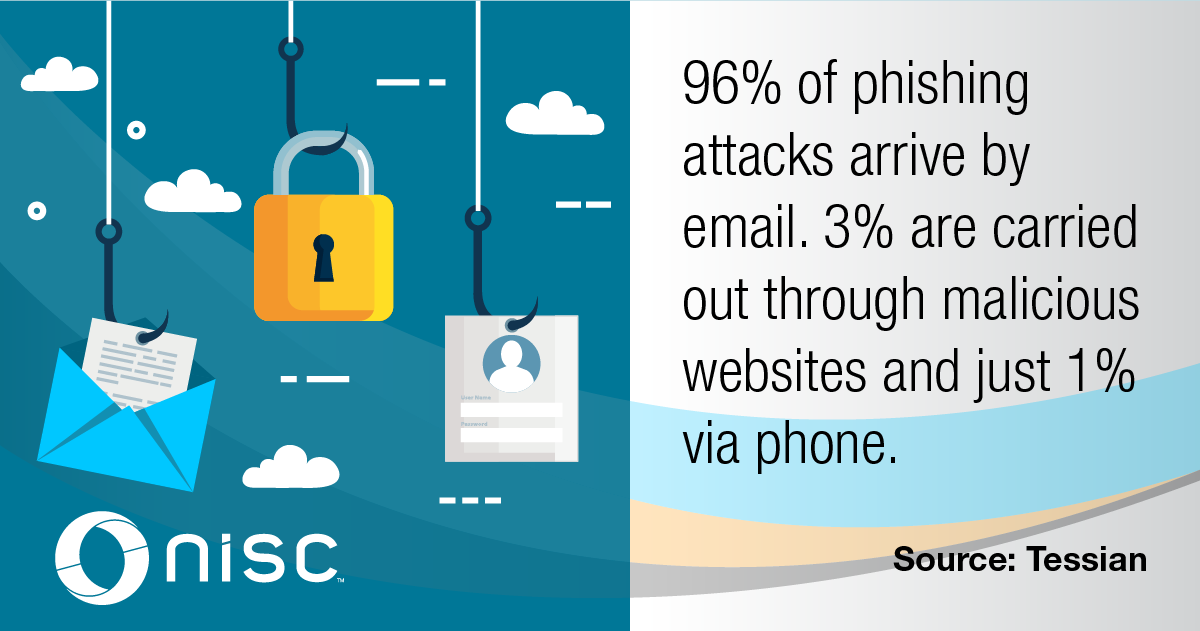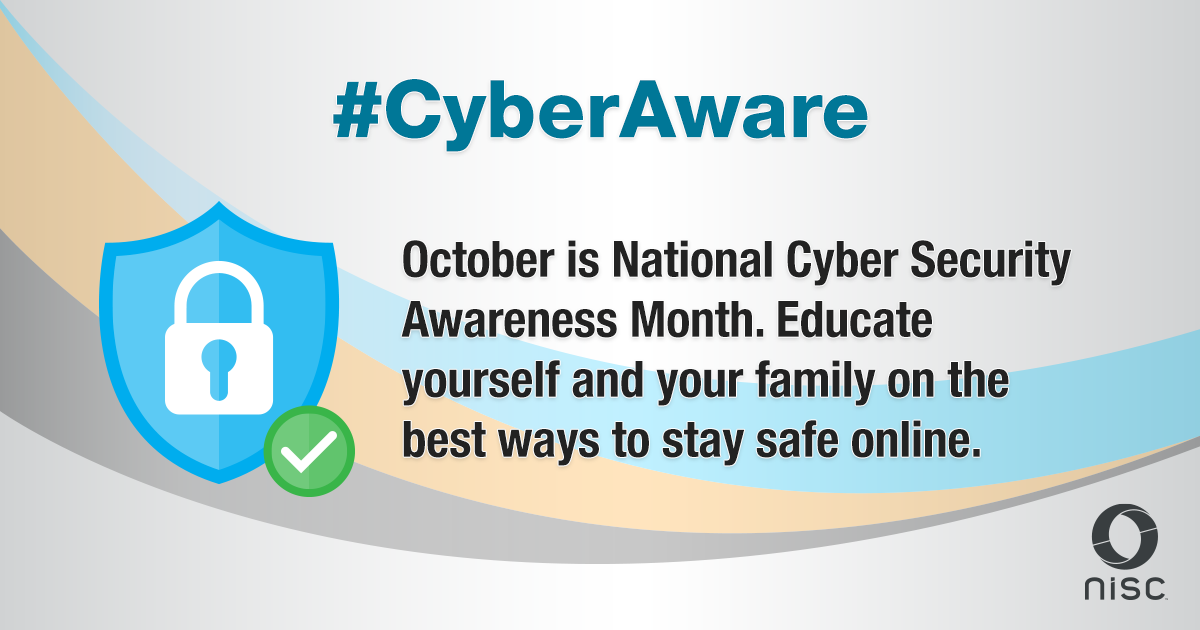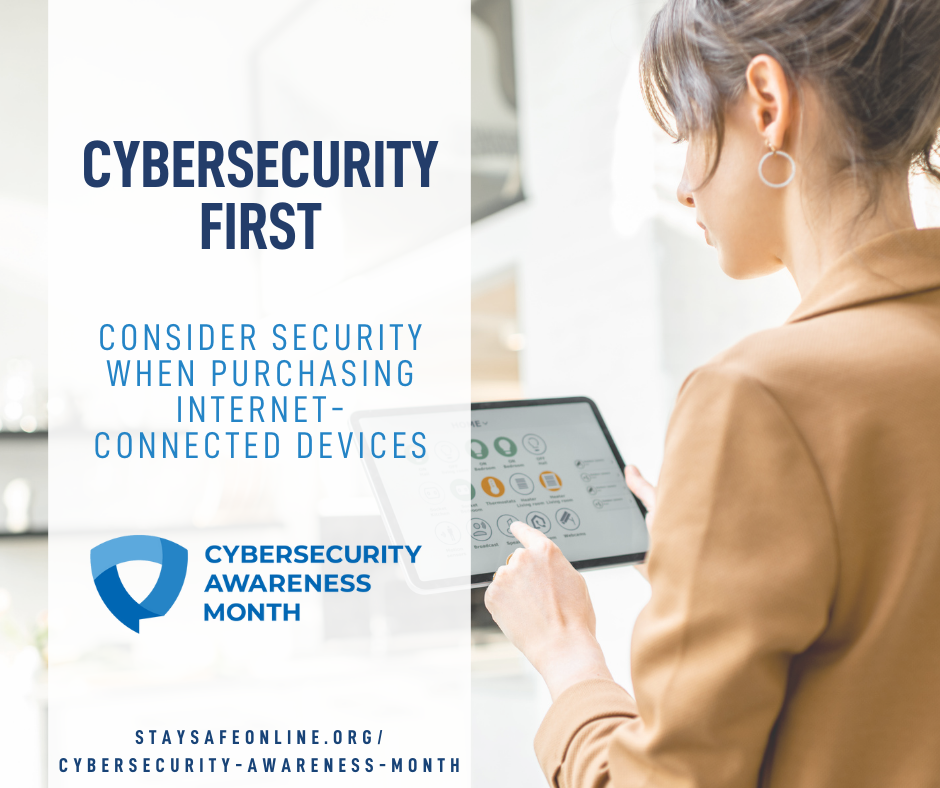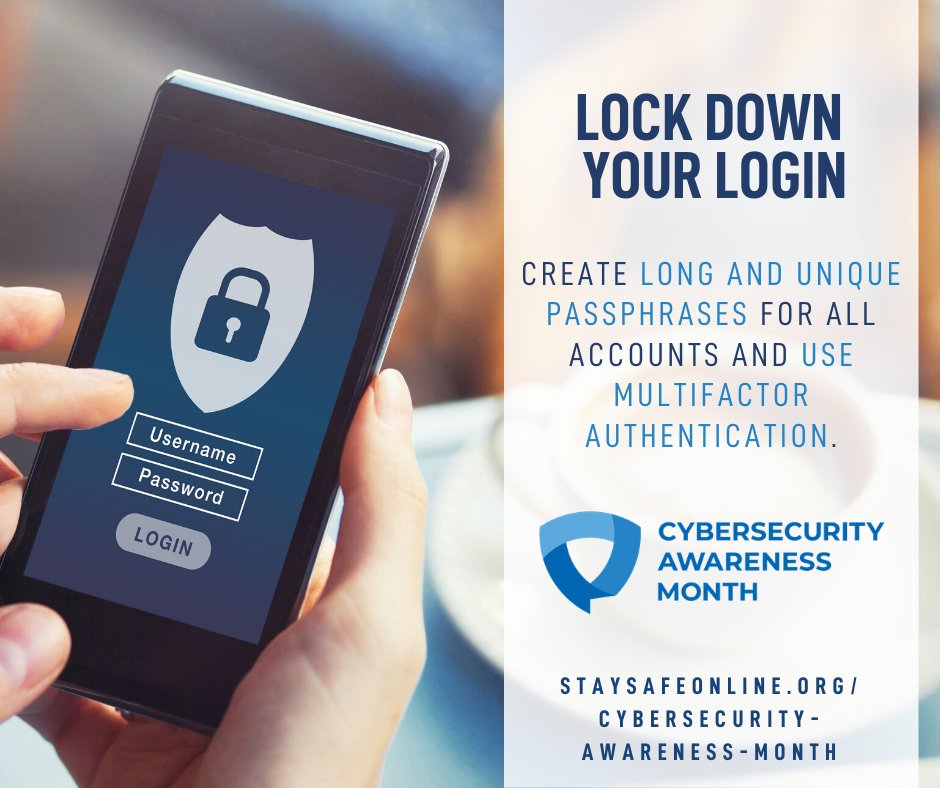March 27, 2025
 In June 2021, a new ransomware reared its ugly head and has since spread around the globe. By last month, Medusa had impacted more than 300 victims across a wide swath of industries from medical to legal, technology to manufacturing.
In June 2021, a new ransomware reared its ugly head and has since spread around the globe. By last month, Medusa had impacted more than 300 victims across a wide swath of industries from medical to legal, technology to manufacturing.
This “ransomware-as-a-service provider” demon started being controlled by a single group of threat actors but has expanded into an affiliate model, meaning a whole network of attackers spread out and use a double extortion model that experts say “encrypts victim data and threatens to publicly release exfiltrated data if the ransom is not paid.” Victims are given 48 hours to respond by chat or instant messaging followed by email or phone. They are also provided with a link to the affiliate’s crypto wallet where they can see a countdown of their time remaining and alerts advertising their data that parties can bid on or buy. Pretty terrible.
The FBI and other cybersecurity agencies are tracking Medusa and developing a plan to counter their attacks, but in the meantime, they recommend implementing a number of actions to protect businesses (as well as individuals) from this type of attack:
- Update all operating systems, software, and firmware.
- Implement multi-factor authentication for all systems and virtual private networks.
- Segment networks to minimize the spread of ransomware.
- Install software that monitors and logs unusual network traffic.
- Back up critical data or proprietary material and save it somewhere physically separate from your network (like a hard drive or in the cloud).
As always set a good example and encourage employees, colleagues, and family members who share a network to be good stewards of data – even if doing so take a little extra time and effort.
March 27, 2025
Clean your email inbox to avoid collecting potentially dangerous messages. Regular housekeeping reduces clutter and minimizes the risk of forgotten phishing attempts.
March 20, 2025
Senior VP and Global Head of Research at Gartner Peter Sondergaard said, “Information is the oil of the 21st Century, and analytics is the combustion engine.” Data, then, is the most valuable resources across nearly all industries – but the person who is able to cull, sort, analyze, and act upon that data really is king!
Enter the Digital Marketer, whose gift is asking the right questions about consumer behaviors and analyzing their responses to craft new (and everchanging) strategies to build brand loyalty and welcome new customers into the fold. (Maybe you’re reading this today because a very clever digital marketer designed a strategy just for that purpose. See? It really works!)
How they can help
Digital marketers typically have the unique combination of talents, allowing them to collect and analyze data AND to develop unique ways to reach customers based on their analysis. The best digital marketers can strategize based on data from previous campaigns, as well as predicting future behaviors based on how they have engaged in the past or based on how they interact with other, similar products or services.
Because they are agile and intuitive, they make informed, educated guesses but they can also pivot on a dime if there is a change in the market, a new trend emerges, or data collected suggests a shift in what customers need and want.
What tools they can use
Digital marketers really are jacks of all trades, bringing together expertise in a number of disciplines, with different technologies supporting each. They will use tools that drive project management (Trello and Slack), SEO (SEMrush and Moz), content creation (Canva, YouTube, and Photoshop), email marketing (MailChimp and HubSpot), and of course social media management (Hootsuite, Buffer, and analytics for each social media outlet).
The sheer volume and depth of knowledge required to be a leading digital marketer may be daunting, but the number and quality of helpful tools on the market grows every day!
How they got there
The great news is that data-driven marketing can be employed in a variety of fields from communications to advertising, promotions to social media. Most people in this field start with a BA in business, marketing, or communications, but other fields that rely heavily on data collection, storage, and analysis will also provide a leg up.
Where you can start
As always, interning with a digital marketing firm (or ad, PR, or communications firm) will help, but you can also bolster your credential by taking some courses. You could start with the Digital Marketing Revolution course, which will clarify the differences between analog and digital marketing, help you develop critical thinking skills, and learn some real-world applications for digital marketing.
March 20, 2025
Don’t send passwords, social security numbers, and sensitive information via email. Use secure file-sharing utilities or deliver sensitive information in person or by mail.
March 13, 2025
Being skeptical can prevent you from falling prey to a phishing attempt. If something seems too good to be true, it probably is. To avoid phishing traps, be suspicious of offers.
March 6, 2025
 If you feel like you are CONSTANTLY online – and not in a good way – you’re like a full 1/3 of Americans. The U.S. Surgeon General has released an advisory that finds that this fully wired lifestyle has driven an epidemic of loneliness, isolation, and nosedive in overall well-being. To combat these negative effects, visit https://www.globaldayofunplugging.org/ to commit to fully unplugging from sundown to sundown, March 7-8, to give your body, mind, and soul a reboot. This site also serves as a terrific resource for how to establish connections (with real, actual humans!) and use your offline time in meaningful ways.
If you feel like you are CONSTANTLY online – and not in a good way – you’re like a full 1/3 of Americans. The U.S. Surgeon General has released an advisory that finds that this fully wired lifestyle has driven an epidemic of loneliness, isolation, and nosedive in overall well-being. To combat these negative effects, visit https://www.globaldayofunplugging.org/ to commit to fully unplugging from sundown to sundown, March 7-8, to give your body, mind, and soul a reboot. This site also serves as a terrific resource for how to establish connections (with real, actual humans!) and use your offline time in meaningful ways.
March 3, 2025
 We’ve talked a lot about very niche technical jobs that required highly specialized, focused skills. But one tech expert is extremely well-rounded, contributing to the development of both back-end (coding) and front-end (design) pieces of websites. Meet the full-stack developer. Is this the person who develops huge piles of pancakes? No, but their work can be very, very tasty.
We’ve talked a lot about very niche technical jobs that required highly specialized, focused skills. But one tech expert is extremely well-rounded, contributing to the development of both back-end (coding) and front-end (design) pieces of websites. Meet the full-stack developer. Is this the person who develops huge piles of pancakes? No, but their work can be very, very tasty.
What they do
Full-stack developers do it all. They build out websites and apps from scratch, creating the framework on which the site sits, determining the navigation paths, and choosing the mechanisms for how data is processed. They focus on how data is collected and stored as well as instituting and maintaining solid security.
Contrary to the black-and-white skills involved in the back-end, full-stack developers also use their creative know-how to make the front end (the side the customer sees) pleasing to look at, and intuitive enough for new users to grasp. They also troubleshoot issues and fix bugs, all in an effort to keep improving their product.
How they can help
They help you every day without you even knowing they exist! An easy navigable website that you enjoy visiting, is easy to search, and holds your data securely was probably created by a very skilled full-stack developer – who also happens to make the updates that improve your experience release after release!
What tools they can use
As you can imagine with such a spectrum of necessary skills, full-stack developers rely on a lot of different tools:
- Back-end tools: These are mostly server-side programming languages like Python, PHP, Ruby on Rails, and CakePHP. Math and engineering nerds rejoice: If you’re with algorithms and cloud computing, you’re halfway there!
- Front-end tools: Think creative design here. Coding that drives dropdown menus, colors, and layouts as well as HTML, CSS, and scripting languages like JAVA, and graphic tools like Photoshop are in the front-end development toolbox.
- Database Management: Because every site has some data collection and storage elements, knowing how to create, manage, and manipulate data is critical.
How they got there
While most full-stack developers have a bachelor’s degree (most in computer science or computer engineering), if you have the right type of mind, this could be a great fit. If you have some computer savvy, are creative, and have a real attention to detail, that’s a great start. Solidifying your foundation interning or taking an entry-level position with a software development firm will give you a taste for the job as you pick up some certificates that will make you more employable.
Where you can start
Start building a portfolio. Employers will want to see that you can code, but also that you have a designer’s eye (not every coder does!). You can take some classes in Photoshop and Canva, beef up your coding skills, or put all the pieces together by getting your Microsoft Full-Stack Developer Professional Certificate.
February 27, 2025
A sense of urgency or an authoritative tone often indicates a phishing email. Be cautious of correspondence with demanding undertones. Phishing attempts will try to rush you into making mistakes.
February 20, 2025
 Deep sigh. It seems we’re getting to the point that EVERYTHING is a deep fake. As many Google users have unfortunately learned, you can’t even trust your own eyes and ears when it comes to facing down today’s hackers.
Deep sigh. It seems we’re getting to the point that EVERYTHING is a deep fake. As many Google users have unfortunately learned, you can’t even trust your own eyes and ears when it comes to facing down today’s hackers.
Last fall, Gmail users received phone calls from Google (confirmed by caller ID) indicating their account had been compromised. The caller was professional, the line was clear, and the “engineer” had an American accent. The user was directed to check their email (for a code to reset their email. It came from a Gmail address and was not loaded with typos. Everything about the interaction seemed legitimate so they entered the code, clicked reset, and…
The hacker now had control of their account.
Cybersecurity experts are warning all users (not just Google) that these attacks are getting more sophisticated every day, and when one doesn’t work, they just pivot and try a new tactic. The good news is, even as the attacks are changing, many of our old strategies to stay safe still work:
- Stay calm. Don’t be rushed into giving away more than you should.
- Just hang up. Google (or even your bank) won’t call you asking for passwords. If there is a legitimate breach, you can always call the main number or message the helpdesk for details and confirmation.
- Check your history. Scroll to the Details link at the bottom right of your Gmail inbox to check the most recent activity. If you can see someone else accessed your account, you may have been hacked. Change your password immediately, log out, and log back in.
- Use Google’s resources. Click the ? button at the top of the Gmail inbox. Here you can find articles and ask questions. Sadly, most incident types have happened before and someone else probably has a solution.
Unfortunately, Google can’t help with account recovery if someone steals your credentials and locks you out. (Once you click that “reset” button or provide the hacker with the information they need, the cause may be lost.) Make sure, therefore, to change your password often, log off your computer after use, and never ever give your password to anyone over the phone.
February 20, 2025
Hang up if someone calls requesting sensitive information. Call back using a trusted number to confirm they’re legitimate and ensure you’re speaking to an authorized person.
February 14, 2025
 The annual Consumer Electronics Show is THE place to be for tech companies ready to launch their coolest new gadgets and for consumers to start developing next year’s Christmas list early. Of course, there were all manner of spins on old favorites (TVs, computers, and a selection of robots basically capable of replacing most of us!) but here are some of the most outside-the-box toys unveiled this year:
The annual Consumer Electronics Show is THE place to be for tech companies ready to launch their coolest new gadgets and for consumers to start developing next year’s Christmas list early. Of course, there were all manner of spins on old favorites (TVs, computers, and a selection of robots basically capable of replacing most of us!) but here are some of the most outside-the-box toys unveiled this year:
- Tongue tricking spoon. This spoon uses tiny electrodes to trick your tongue into thinking your food is saltier than it is. It was created to address the “social issue of excessive salt intake” and may even bring down blood pressure with continued use!
- Needle-free injections. Created to address needle phobia, the Flowbeams device uses a laser to heat the medicine and then propels high-velocity “liquid microjets” into the skin. (We assume this would not market well to those with “high velocity microjet-phobia…” but everyone else should love this unit.)
- Smart Lipstick. Developed by the Brazilian company Boticário, this is an AI-powered lipstick that uses sensors to identify the user’s lip outline, ask the user to choose a color, and then a robot arm applies the lipstick. Initially developed to help women with visual impairment, it would also likely be cheered by women who have not yet put in their contacts OR who apply their lipstick while driving (the no-look look!)
- The Kara Pod. The world’s first self-refilling coffee pot uses an “air-to-water” concept, employing a high-tech dehumidifier that captures the atmospheric water from the air in your house, and purifies it using heat treatment, UV light, and replaceable filters. The result? Enough captured water to make 13 cups of clean drinking water or freshly brewed coffee every 24 hours. If they can follow up with a device that transforms leftovers into nice, warm donuts, we’ll never have to leave the house again.
- Beyond 01 trainer. This ultra tiny optical-based training data collector clips on to athletes’ shoes while they work out. It can deliver standard “how fast, how far, how many calories”-type data but also lab-quality insights on muscle and joint health. Results can be used, for instance, to capture knee contact forces to help runners modify their strides for maximum efficiency and lower risk of injury.
Whatever your tech needs – entertainment, communication, physical fitness, or even a stretchable TV screen you MUST HAVE to make your 3D experience actually three-dimensional – CES is the place to find it. See you next year!
February 13, 2025
Don’t click unexpected links or open unsolicited email attachments. First, verify the sender’s authenticity. Phishing attacks are common and can be disguised as familiar contacts.
January 30, 2025
January 28, 2025
January 27 – 31 is #DataPrivacyWeek! Learn how to manage your online #privacy and control who receives your data: Click HERE.
January 16, 2025
Saving passwords on your browser might be convenient, but it’s not the safest option since browsers can be vulnerable to attacks.
December 19, 2024
 Unlike more niche technical positions, software engineers really do touch almost every step of the software development lifecycle. From the creative spark that sets the development in motion to the testing of the finished product, software engineers are the brains behind just about every piece of software, firmware, and application we use every day. They are in high demand and most candidates (with basic qualifications) are able to find a job within six months of starting their search.
Unlike more niche technical positions, software engineers really do touch almost every step of the software development lifecycle. From the creative spark that sets the development in motion to the testing of the finished product, software engineers are the brains behind just about every piece of software, firmware, and application we use every day. They are in high demand and most candidates (with basic qualifications) are able to find a job within six months of starting their search.
What they do
They design, develop, and test software applications and computer systems. While many of them have a creative bent (most applicable at the beginning stages of design), part of what makes them successful is their embrace of engineering principles to keep them on track. They use a variety of programming languages and platforms to develop games, engineer business solutions, and even create apps for our phones.
How they can help
While software engineers aren’t likely to interact with consumers in the marketplace, they are extremely helpful for those in their industry. They are analytical by nature, so they have the skills and know-how to troubleshoot their colleagues’ work, testing, maintaining, and fixing complex problems. They are always seeking ways for software and software systems to perform better – making the applications all of us use function more efficiently and with fewer bugs.
What tools they can use
Software engineers rely heavily on programming languages such as C++, Java, Python, and SQL to manage code and identify bugs. Likewise, as their skills evolve from strictly technical to include project management efforts, they will also use version control systems like Git and PM software like Jira.
How they got there
Software engineers usually choose one of two paths: systems engineers (who build computer systems and networks that support software/apps) or application developers (who design the applications, modifying as requested, and releasing updates as new features are developed). System engineers tend to be more analytical and have a background in computer science while developers may have more creative experience such as cloud computing, web development, or machine learning. Most have undergraduate degrees in computer-related fields, but (as with most technology positions) certifications are becoming an acceptable alternative to a four-year degree.
Where you can start
Internships and externships provide a great way to gain experience in the field if you haven’t had formal training. You may even be able to talk your mentor’s company into paying for a certificate program. You can also use this time (during internships or an entry-level position) to start building a portfolio to demonstrate your expertise and experience.
Software engineering is a career field with endless possibilities and is not likely to go out of vogue anytime soon. Engineers can expect to make great money, have the flexibility to work from home, and be able to use their unique talents across any number of industries.
December 19, 2024
As we enter the holiday season, remember that cyber-attackers frequently use this season to their advantage. They often create pretexts mimicking special holiday deals to entice users to click a malicious link that actually installs malware on the victim’s computer or leads to a site that steals login credentials. This holiday season, use extra diligence in watching out for phishing emails. Don’t click links or open attachments in emails you were not expecting! Also, make sure you only enter payment card information into sites that have HTTPS in the URL bar of your Internet browser.
December 12, 2024
 Just hear those sleigh bells jingling, pocketbook ring-ting-tingling… Yes, it’s that time of year when we take to the malls and online shopping venues with reckless abandon, swiping, tapping, and entering our payment methods without a second thought. At the same time, hackers and thieves are rubbing their mittens together with holiday cheer at the prospect of stealing your most sensitive information.
Just hear those sleigh bells jingling, pocketbook ring-ting-tingling… Yes, it’s that time of year when we take to the malls and online shopping venues with reckless abandon, swiping, tapping, and entering our payment methods without a second thought. At the same time, hackers and thieves are rubbing their mittens together with holiday cheer at the prospect of stealing your most sensitive information.
According to a new CNET survey, 71% of American adults engaged in risky online activities this past year while another 47% said they were victims of cyberattacks. While some of these attacks were breaches – over which consumers have little control – many were the result of successful phishing campaigns or other human error, putting both financial data and identities at risk.
CNET identified three of the biggest no-nos that could result in compromises:
- Using the same password on multiple accounts. (71% of surveyed adults admitted to this.)
- Saving passwords on their phone or computer (rather than through a password manager).
- Opting out of two-factor authentication. (1 in 5 of us did this last year.)
While many people take positive steps after they learn their information has been compromised, why not take these steps NOW and avoid the hassle and damage? Get on Santa’s Nice List with these simple steps (we know them, but they are especially important during this shopping season).
- Change your password often and choose a unique password for every site you visit or app you use.
- Monitor your credit report regularly and if you even suspect fraud or an attack, freeze your credit immediately.
- Never opt out of two-factor authentication.
- Use digital wallets like ApplePay or GoogleWallet so even if a retailer is hacked, your credit card information is safe.
- When shopping online, confirm the website has “https” in the address to ensure your financial data and purchasing information is encrypted.
Now you can enjoy your holiday shopping and celebrating safely!
November 26, 2024
 Gone are the days when a successful business just needed a solid product and someone to make it and sell it. Today, almost every company – large and small – relies on robust and secure information technology (IT) to ensure their business thrives in a global marketplace. Of course, with that reliance comes the threats that could derail everything from cyber threats to software vulnerabilities to outdated hardware and even to employees who deliberately or inadvertently put the company at risk. Who can save the day?
Gone are the days when a successful business just needed a solid product and someone to make it and sell it. Today, almost every company – large and small – relies on robust and secure information technology (IT) to ensure their business thrives in a global marketplace. Of course, with that reliance comes the threats that could derail everything from cyber threats to software vulnerabilities to outdated hardware and even to employees who deliberately or inadvertently put the company at risk. Who can save the day?
IT Auditors!
What they do
IT Auditors essentially seek out pain points and potential vulnerabilities in their company’s IT systems and infrastructure. They make sure systems are compliant with regulations and company protocols. Global professional services group Deloitte describes IT auditors’ daily tasks as the review and evaluation of “automated information pros, their relation to automated processes, and the interfaces among them.”
How they can help
Unlike other IT specialists who may identify and fix issues, auditors don’t make fixes themselves. This seems like a strange division of labor, but this allows the auditors some degree of autonomy, sticking to the letter of each regulation or protocol, and stating the issue dispassionately without leaning toward one solution or another. This dynamic also necessitates that IT auditors collaborate heavily with other teams, translating techspeak into easy-to-understand guidance and evaluating the compliance of every team to ensure their audits are well-informed and comprehensive. They are also likely to be in regular contact with management, serving as a conduit between colleagues seeking a change in policy and management who must evaluate that change.
What tools they can use
Not surprisingly, IT auditors use a lot of IT to accomplish their work, mostly targeted software that helps them streamline (and even automate) their audits. Most rely on audit management tools like TeamMate and Galvanize, risk analysis software like LogicGate, and data analysis/reporting software like Power BI which helps present the results of their audit in ways lay people will understand and be able to act upon.
How they got there
Because the general process of auditing is similar across many disciplines, those with experience in finance or law may find the leap to IT auditing not such a large one. They already have many of the investigative and compliance skills necessary. However, at the crux of IT auditing is, well, IT, so candidates will need either/both hands-on experience in roles like database admin, systems admin, or systems analyst or a Bachelor’s degree in a related field like cybersecurity.
Where you can start
In addition to a BS from an online university like Maryville University, a number of certifications will help fill out your resume. Check out the Certified Information Systems Auditor (CISA) and Certified in Risk and Information Systems Control (CRISC) certifications, both from the Information Systems Audit and Control Association (ISACA) as a great place to start.
November 21, 2024
 Among our most sensitive information is our health data and among that, our genetic information may be the most sensitive still. This data not only ties us to family – both known and unknown – it can be predictive of future health concerns and even be grounds for a decision to forgo having children. So, when 23andMe loses the genetic data of 7 million people, tremendous damage can be done.
Among our most sensitive information is our health data and among that, our genetic information may be the most sensitive still. This data not only ties us to family – both known and unknown – it can be predictive of future health concerns and even be grounds for a decision to forgo having children. So, when 23andMe loses the genetic data of 7 million people, tremendous damage can be done.
The ancestry research firm, 23andMe, announced in October 2023 that, beginning several months earlier, hackers had begun downloading customer data. Before the breach was discovered, over half their customers’ data had been stolen. Now a class action suit has been filed resulting in settlements of between $100 and $10,000 per affected customer. Those who can prove they suffered hardship (such as identity fraud) due to the breach are likely to receive higher compensation.
In addition to the cash settlements, 23andMe is offering impacted customers three years of security monitoring including web and dark web monitoring. As always, in addition to relying on monitoring, customers should check their credit regularly but also contact family members whose data might have been compromised as a result of their genetic connections to them. Just as the branches of a family tree spread and split, the total reach of this breach is likely to continue to grow for a long time to come.
November 14, 2024
 Black Friday is just around the corner and the REAL holidays not long after that. And we know what that means: shopping, shopping, travel, shopping, over-the-top meals, and more shopping. Wouldn’t it be nice to have a few extra bucks to work with this year? It’s possible, and without even leaving your house.
Black Friday is just around the corner and the REAL holidays not long after that. And we know what that means: shopping, shopping, travel, shopping, over-the-top meals, and more shopping. Wouldn’t it be nice to have a few extra bucks to work with this year? It’s possible, and without even leaving your house.
Here are a few terrific ways to turn a quick profit as a side hustle or, if things go well, to supplant your 9-to-5er:
1. Start a blog. If you find yourself writing long emails or social media posts, why not organize them into an official blog? Find a niche that can be supported by advertising or affiliate marketing, and one post can turn into plenty of residual income. It may take some time to ramp up, but off-shoot profits are almost unlimited.
2. Sell stuff on eBay. We all have STUFF. Check the garage, the attic, your parents’ basement for antiques, collectibles, or memorabilia and sell it on eBay. Your trash is someone else’s treasure!
3. Share your space. If you have a spare room or room in your car, you may be sitting on a goldmine. Consider Airbnb – especially during the holidays – or even Uber – if you have time in your schedule for some quick drop-offs and pick-ups. If you don’t mind sharing your space with a pup or a cat, check out www.rover.com to do some petsitting over the holidays.
4. Tutor. As we come up on SAT and college application season, consider sharing your education and experience with a youngster. Sites like www.tutor.com already have clients lined up and it’s just up to you to pick a subject and set a schedule.
5. Make something nice and sell it. ‘Tis the season to bake, make, crochet, paint, and design, so while you certainly can give these homemade gifts away, sites like www.etsy.com provide a ready-made storefront that allows you to sell to strangers around the world, as well as neighbors around the corner.
As with anything on the web, be careful and make sure to research your opportunity thoroughly before going all in. Most importantly, find a reliable payment processor (check https://top-merchantservices.com/online-payments-processing/ for recommendations) and check your accounts often to make sure you’re raking it in in time for your holiday shopping!
October 31, 2024
Hackers use convincing bait to try to get you hooked. Don’t fall for it! Learn how to recognize a phish and what to do with it. #CybersecurityAwarenessMonth #SecureOurWorld
Download the graphic below as a PDF by clicking HERE.
October 30, 2024
 To help children stay safe online this Cybersecurity Awareness Month, Hardy Telecommunications presents “Gizmo: The Internet Guard Dog!” This fun and engaging coloring book, from NTCA – The Rural Broadband Association, helps kids learn the basics of staying safe online. Join Gizmo, the lovable cyber-savvy pooch, as he shares helpful tips and important lessons to make the Internet a safer place. With easy-to-understand guidance, this coloring book is perfect for young explorers who want to have fun while learning about cybersecurity. Items covered include:
To help children stay safe online this Cybersecurity Awareness Month, Hardy Telecommunications presents “Gizmo: The Internet Guard Dog!” This fun and engaging coloring book, from NTCA – The Rural Broadband Association, helps kids learn the basics of staying safe online. Join Gizmo, the lovable cyber-savvy pooch, as he shares helpful tips and important lessons to make the Internet a safer place. With easy-to-understand guidance, this coloring book is perfect for young explorers who want to have fun while learning about cybersecurity. Items covered include:- Guard Your Personal Info
- Strong Passwords are Superpowers
- Ask Before You Click
- Be Kind Online
- Keep Your Location Private
- Beware of Strangers Online
- Report When Something Feels Wrong
- Not Everything Online is True
October 24, 2024
October 22, 2024
 Remember all those bespeckled forensics men and women on shows like BONES, COLD CASE FILES, and literally everything on Brit Box? The ones who solve complex crimes by piecing together bits and pieces of physical evidence? Well, while those geniuses are still out there, a new position is evolving that values the same puzzle-solving abilities but applies them in cyberspace. Introducing the Digital Forensics Examiner.
Remember all those bespeckled forensics men and women on shows like BONES, COLD CASE FILES, and literally everything on Brit Box? The ones who solve complex crimes by piecing together bits and pieces of physical evidence? Well, while those geniuses are still out there, a new position is evolving that values the same puzzle-solving abilities but applies them in cyberspace. Introducing the Digital Forensics Examiner.
What they do
Unlike their Holmesian counterparts, digital forensics (DF) examiners find most of their clues in computers, digital devices, and the cloud. They uncover who had access to data, how they accessed it, and what they did with it – even when it seems that everything has been erased. And, like “real world” investigators, they must adhere closely to legal guidelines like maintaining chain of custody to ensure that whatever evidence they discover can be used without objection in court.
How they can help
With more than $12 billion being lost to cybercrime in 2023, it’s clear that we need the skills and expertise DF examiners bring to the table more than ever. Not only can they help companies discover vulnerabilities when a cybercrime has been committed, but also they can provide law enforcement with unimpeachable data they can use in court; many even serve as expert witnesses, providing testimony on the stand in a way that juries and judges can understand and make sound judgments about.
What tools they can use
DF examiners use an array of eDiscovery software and hardware designed to extract, analyze, and present digital evidence in ways lay people (and law enforcement) can understand. “Autopsy” is a DF platform that allows an examiner to plot a timeline of use for phones or computers, recovering deleted files, flagging phone numbers, and conducting keyword searches. “DumpZilla” allows the examiner to perform in-depth browser analysis from extracting cookies to recalling bookmarks and deleted caches.
How they got there
While 144 colleges in the U.S. offer a Bachelor’s degree in Digital Forensics (and another 78 offer Masters degrees), you can become such an examiner with on-the-job training as well. Those in this role often start in IT support or as a risk analyst. Likewise, those who study computer science, engineering, or applied mathematics tend to be uniquely suited (and equipped) for this line of work. In addition to standard education, the following certifications will help build your resume in this field: GIAC Certified Forensic Analyst, EnCase Certified Examiner (EnCE), and AccessData Certified Examiner (ACE).
Where you can start
Think this career field might be for you? Dip your toe into Digital Forensics Essentials to see if this is right for you. You’ll learn the foundations of this career field and get to work on hands-on projects to help you gain the skills necessary to land a job.
October 10, 2024
October 3, 2024
September 26, 2024
September 24, 2024
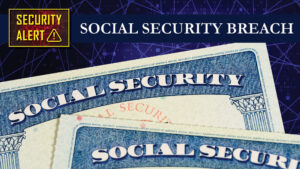 Of all our most closely held data – birthday, mother’s maiden name, bank details – the one we desire to keep most secure is our social security numbers. With it, other personal information, including tax data and other personally identifiable information (PII) is easier to extract. And now, even THAT has come under attack.
Of all our most closely held data – birthday, mother’s maiden name, bank details – the one we desire to keep most secure is our social security numbers. With it, other personal information, including tax data and other personally identifiable information (PII) is easier to extract. And now, even THAT has come under attack.
National Public Data, a company that performs background checks, confirmed nearly 3 billion records (including names, addresses, contact information, AND SSNs) were stolen. This data breach affects millions of Americans, all of whom were notified by NPD that their data was likely stolen during a December 2023 hack by the cybercriminal group USDoD.
A class action suit has been filed by Schubert, Jonckheer & Kobe for those who have been affected, and another security firm, Pentester, has developed a tool to determine if you are one of the unlucky victims of this crime. According to USA Today, you can visit https://npd.pentester.com and enter non-sensitive information to see if you’ve been targeted. Please note that Pentester requires a paid subscription for more comprehensive services. Hardy Telecommunications does not recommend any particular service and simply is passing on this information.
If you are on this list, security experts recommend freezing credit reports since SSNs are used to secure loans or to apply for credit cards. If you’ve suffered financial loss from this breach, you may want to reach out to an attorney or join the class action suit.
If you are not on the list, it’s still good practice to regularly monitor your credit and to use the opportunity to delete cookies on your computer and reset all your passwords.
September 19, 2024
 If you read this column often enough, you know that whenever we talk about hackers and the safety of your data, we always end up talking about “cybersecurity specialists” and what they do behind the scenes to keep companies’ and individuals’ data safe. But who ARE these faceless heroes? And how did they ever get from “computer nerd” to the unsung geniuses they are today?
If you read this column often enough, you know that whenever we talk about hackers and the safety of your data, we always end up talking about “cybersecurity specialists” and what they do behind the scenes to keep companies’ and individuals’ data safe. But who ARE these faceless heroes? And how did they ever get from “computer nerd” to the unsung geniuses they are today?
What they do
In a nutshell, cybersecurity specialists assess security risks and develop strategies to mitigate that risk. Their daily tasks can vary depending on their specialties; some will focus on hardware and software solutions while others focus more on network security than on data protection.
How they can help
Cybersecurity specialists essentially have two sets of clients: their own company and its employees AND the customers their company serves. They ensure the cyberspace their colleagues work in is secure and impervious to hacks which could slow (or halt) their business, but they also ensure the data with which their customers entrust them is locked down.
What tools they can use
Of course a big brain helps in this career field. Creative problem-solving and collaboration are critical “soft skills,” but most cyber specialists also excel at testing, endpoint management, and navigating network data, logs, etc. Specialists will have (and gain) knowledge of cybersecurity systems and infrastructure, antivirus and malware software, security controls, and firewalls.
How they got there
Most cybersecurity specialists have at least a Bachelor’s degree in a field like computer science or other STEM field, but on-the-job experience or a professional certificate could get you in the door. A recent LinkedIn discussion asked experts how online learning can accelerate cybersecurity careers and talent, and their input should encourage anyone seeking to enter this field.
Where you can start
Udemy and Coursera and other online educators are replete with certification courses that will set you on the path to a career in cybersecurity. Highly coveted certifications include Security +, Certified Information Systems Security Professional (CISSP), Certified Ethical Hacker (CEH), and Systems Security Certified Practitioner.
In most cases, a certification costs between $250 and $1,000 but can lead a candidate into a job making well over $100,000. A sound investment to prepare you for a life of doing good!
August 30, 2024
 Ahhh, the dog days of summer. Cool drinks on the back patio, sun and fun on the beach, and not a care in the world. No early races to the school bus, no homework, no cardboard pizza in the lunchroom. Well, friend, those days are over.
Ahhh, the dog days of summer. Cool drinks on the back patio, sun and fun on the beach, and not a care in the world. No early races to the school bus, no homework, no cardboard pizza in the lunchroom. Well, friend, those days are over.
But the back-to-school blitz doesn’t have to be all bad. Stocking up on the right supplies, tools, and gadgets will make all the difference. We give these an A+!
- Hydro Flask ($27)– This 24-ounce bottle keeps water cold all day and (unlike the Stanley) is leak-proof so perfect to toss into a backpack.
- HP Chromebook 11 G9 Celeron– Ideal for parents (or college students) on a budget, this laptop boasts 8GB of RAM, USB-C compatibility, and durability (surviving drops up to 48 inches!) all for under $350.
- All the Apple Stuff– Right now at Apple.com, there are amazing deals on MacBook Airs for under $900, iPads for $550, and 3rd generation AirPods (perfect for study hall) for under $175. They’re offering financing on everything, 20% off AppleCare, and live chat to help you pick out and set up the perfect tech for you.
- Tile Mate– Buy one! Buy 1,000! These little Bluetooth chip trackers will be worth your weight in phones/laptops/backpacks/keys when you clip them on to anything you never want to lose.
- Lexar External Hard Drive– For $100, the Lexar SL600 solid state drive gives you 1TB of storage and reads/writes with speeds of up to 2000 MB/seconds. This much storage is perfect for creative professionals like photographers and content creators but is also a terrific option for college students who don’t want the cost or hassle of paying a monthly cloud storage fee.
- Sunrise Alarm Clock– Nothing is worse than being blasted awake by an overzealous alarm clock. Instead, ease your toddlers and teens out of bed with the Sunrise Alarm Clock. This clock uses seven natural sounds (including crickets) in combination with a progressively brighter “sunrise” to coax kids out of bed. Better still, you can use the unit as a nightlight, reading light, and even a radio. Old school, baby, old school.
This is our year, parents! The year we start and end the school year with the same backpack (zippers intact), where we breeze on by the Lost and Found without looking back, and when a little bit of tech goes a long way toward straight A’s and happy days!
August 23, 2024
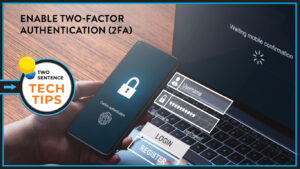 Enable Two-Factor Authentication (2FA): It feels like an extra step to slow you down, but this additional verification may be what stands between you and a hacker. Take a moment to enable 2FA on bank accounts, credit cards, and even email to amp up your online security.
Enable Two-Factor Authentication (2FA): It feels like an extra step to slow you down, but this additional verification may be what stands between you and a hacker. Take a moment to enable 2FA on bank accounts, credit cards, and even email to amp up your online security.
August 16, 2024
 It’s back to school, and teachers are breaking the ice with the age-old question to new students: “What do you want to be when you grow up?” Doctor? Lawyer? Chef? Astronaut? These jobs are soooooo 2023.
It’s back to school, and teachers are breaking the ice with the age-old question to new students: “What do you want to be when you grow up?” Doctor? Lawyer? Chef? Astronaut? These jobs are soooooo 2023.
Let’s shine the spotlight on a new and exciting career: The Data Scientist.
What they do
Helps organizations and businesses make sense of the growing amount of data they collect. They analyze and organize all this information and present it in clever, easily understood ways. They and their team can also use this data to find patterns and predict future behaviors – including purchasing.
How they can help
Advises their team what they should be asking customers/clients/employees and how to format questions and develops algorithms that will tease out critical data and preferences.
What tools they can use
More senior than a data analyst, teams will rely on them to be the subject matter expert, staying on top of innovations and tools to make the job easier and their results more robust. This may include machine learning, programming, and modeling as well as data visualization tools like PoweBI and Tableau.
How they got there
Courses of study that prepared them for a job include data science, computer science, programming, and statistics, but many online learning resources are also offering certificates.
Where you can start
Professional development sites like Udemy and Coursera host courses that will help you get certified in data science. Google is offering a data analyst professional certificate, while IBM is offering a certificate for data scientists, each of which can be completed in 6 months (budgeting 10 hours a week, to be completed at your own pace).
Next time someone asks what you want to be when you grow up, you’ll have your answer!
August 9, 2024
 They say you can get almost anything from Neiman Marcus. Unfortunately, that long list now includes getting hacked!
They say you can get almost anything from Neiman Marcus. Unfortunately, that long list now includes getting hacked!
Last month, the luxury retailer began informing customers that during the months of April and May this year, a database containing customer information was breached. Hackers managed to obtain names, dates of birth, and gift card numbers of some 64,000 customers of both Neiman Marcus and Bergdorf Goodman.
The hacker in question, Sp1d3r, reportedly demanded a ransom which the store refused to pay. Sp1d3r then sold the database for $150,000. It’s unclear what additional information might have been included in the database, but Sp1d3r claims it includes millions of transactions, customer emails, shopping records, and some employee data.
Neiman Marcus has assured its customers it has launched an investigation into vulnerabilities and shut down the database in question. As always, following a breach, if you are a current or former Neiman Marcus customer, make sure to cancel all credit cards and request new gift cards, and stay on top of both bank transactions and credit reports.
July 18, 2024
 With summer at its peak, we’re using our phones for EVERYTHING. GPS for finding our way to the beach, camera for snapping family photos, and apps for everything from checking the weather to finding apple pie recipes. With so much riding on our phones, it’s extra important to keep our batteries up and at ‘em (even as the heat tries to suck them dry).
With summer at its peak, we’re using our phones for EVERYTHING. GPS for finding our way to the beach, camera for snapping family photos, and apps for everything from checking the weather to finding apple pie recipes. With so much riding on our phones, it’s extra important to keep our batteries up and at ‘em (even as the heat tries to suck them dry).
A few simple ways to extend your battery life:
- Close unused apps.Apps running in the background can deplete your battery quickly (especially those that constantly seek WiFi connection) so turn off anything you aren’t using.
- Reduce animations.Animation makes apps more fun and dynamic, but it also uses a ton of battery.
- Swap live wallpaper for a photo.Again, animation = fun = dead battery.
- Turn off data roaming and location services. Unless you’re actively using GPS apps to get somewhere, turn off geolocators. (Double-check sneaky settings like those used in Facebook.)
- Optimize your Settings. Go to Settings and make a few tweaks that will save your battery:
- Reduce your screen brightness.
- Update your theme and wallpaper to a darker theme/image.
- Cut the time before your screen goes to sleep.
- Turn on power-saving mode.
- Turn off keyboard sounds and vibrations.
- Restrict apps that require a lot of power.
And as always, stay cool! Try to keep your phone out of direct sunlight (or even in a parked car) as it doesn’t take long for your phone to be unusable in the heat. If you’re at the beach or ballfield, try putting your phone in a waterproof bag or even Tupperware container and keep it in your cooler. That way it will be fresh, cool, and ready when you are!
July 11, 2024
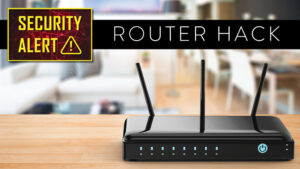 Now they’ve done it. Hackers are not content to just steal our personal information. They’ve now gone after our… internet! Last October, an as-yet-unidentified hacking group launched a cyberattack on a U.S. telecommunications company, disabling the internet services for hundreds of thousands of customers.
Now they’ve done it. Hackers are not content to just steal our personal information. They’ve now gone after our… internet! Last October, an as-yet-unidentified hacking group launched a cyberattack on a U.S. telecommunications company, disabling the internet services for hundreds of thousands of customers.
The telecom company (likely Arkansas-based Windstream) never alerted the public, and the hack was only made public this spring by security experts at Lumen Technologies’ Black Lotus Lab, who discovered the massive attack. Though a full accounting has not been assessed, the experts estimate some 600,000 internet routers throughout the Midwest were offline during the event, which lasted at least two days. The majority of customers had their service restored within a few days – however, security experts say the malware the hackers introduced was still circulating around the internet months later (potentially doing further damage).
Of course, two days without the internet seems like an eternity (especially for the home shopper and the Netflix binger), but because this event mostly affected rural and underserved users, it’s also possible that emergency services were compromised, people lost access to telehealth, and even farmers may have lost critical data about their crops captured with remote monitoring.
The best we can do in the face of these new and unpredictable hacks is to make sure to maintain strong passwords and keep all equipment updated with the latest security patches. Try to be the squeaky wheel that hackers will just pass by.
June 20, 2024
 Ticketmaster’s parent company, Live Nation, confirmed that last month there was an attack on their database exposing personal details for more than 560 million customers.
Ticketmaster’s parent company, Live Nation, confirmed that last month there was an attack on their database exposing personal details for more than 560 million customers.
According to Live Nation, the hacking group ShineyHunters claimed responsibility and demanded a half-million dollar ransom be paid or they would release data to other (nefarious) parties. A spokesperson for Live Nation says they don’t anticipate any “material impact on their overall business operations or financial condition” but had less to say about how this breach will affect its hundreds of millions of customers. Optimistic researchers suggest that data stolen may not be overly sensitive (that is, no health records or complete financial records were released); however, others note that this hack is part of a larger, ongoing hack involving a cloud service provider called Snowflake, which provides services to Ticketmaster as well as other large global firms. That is to say, the ultimate impact of this breach might not be known for months.
As the company conducts its risk assessments and remediations – and law enforcement worldwide continues its investigations – customers should continue to do their own mitigation. If you’ve used Ticketmaster in the past, continue to monitor your credit report and bank statements. Going forward, consider using one credit card for online purchases, use multi-factor authentication when placing orders, and log out of sites as soon as your purchase is complete.
May 14, 2024
 Another massive data breach has occurred in the U.S., this time impacting the nation’s largest health insurance provider and their millions of customers. UnitedHealth Group, which serves 52 million people worldwide (90% of whom reside in the U.S.) was the victim of a cyberattack by hacker group Black Cat putting millions of patients’ private data at risk.
Another massive data breach has occurred in the U.S., this time impacting the nation’s largest health insurance provider and their millions of customers. UnitedHealth Group, which serves 52 million people worldwide (90% of whom reside in the U.S.) was the victim of a cyberattack by hacker group Black Cat putting millions of patients’ private data at risk.
According to UnitedHealth Chief Executive Andrew Witty, the company paid the requested ransom to mitigate the risk to their customers as well as to get payments to doctors and healthcare facilities—halted by the hack—back on track. About half of all claims processed in the U.S. filter through the company’s Change Healthcare unit so this hack has a major impact on how bills are paid and patients reimbursed.
More critical, however, is the likelihood that customers’ personal data has been stolen and released to the dark web. Unlike the breach of a phone company or even bank, this type of hack can have devastating consequences as the data released may include personal, financial, medical, and even genetic information.
As UnitedHealth estimates that up to 1/3 of all Americans may be affected by this breach, your data may be at risk. Just as with a financial breach, it’s important to keep an eye on your credit report (to ensure you aren’t being billed fraudulently), but consider the following mitigation efforts as well:
Contact the insurer directly. HIPAA requires that any medical agency that has been attacked contact patients’ whose records have been compromised, but this can often take time. Reach out yourself if you’re concerned.
Review Explanation of Benefits letters. We often just toss these notices, but go over them with a fine-toothed comb and call your insurer if unexplained charges or services appear.
Verify personal data at every doctor visit. If the personal information (address, coverage, date of birth, etc.) is incorrect, let your doctor know you may be a victim of medical identity theft, and call your insurer immediately. If your billing is auto-debited from a card or bank, sever that tie immediately.
Double–check diagnoses, prescriptions, and potential surgeries. Medical data theft could result in changes being made to your medical records and history. It’s crucial that your prescriptions and treatments remain consistent, so check in with your doctor regularly and make sure they are aware that your records may have been compromised.
As always, the best thing you can do in this connected world is to stay vigilant. Check your credit, review statements, and contact your financial and healthcare institutions if you think you may have been hacked. Stay safe and healthy!
May 2, 2024
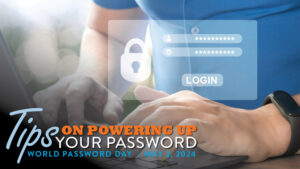 Happy World Password Day. On this day, across the country, people change Password to Pa$$word and think their job is done. They upgrade from MapleStreet1 to MapleStreet2 and think the hackers have been appeased. But no! There’s so much more to be done!
Happy World Password Day. On this day, across the country, people change Password to Pa$$word and think their job is done. They upgrade from MapleStreet1 to MapleStreet2 and think the hackers have been appeased. But no! There’s so much more to be done!
As always, keep the following in mind when you update your passwords (plural, since you should never use the same password for every site/app):
- Use a combination of 12-14 upper and lowercase letters, numbers, and symbols.
- Avoid words that can be found in dictionaries or that are fictional places and people.
- Choose a password very different from your last (not a small variation).
- Never use names or birthdates of yourself or your family members.
Another great (and fun) tip is to create passwords by combining things that are personal to you but impossible for a stranger to guess. Think:
Something from your bedroom + something from your car = 3NewPillowsBrokenAC!
OR
A summer activity + a favorite place = #WaterSkeez_BahstonHahbuh*
The key is keeping it random. Hackers (and their robot friends) have lots of tools and tricks at their disposal to crack your passwords. Choosing clever, complex, and ever-changing passwords is the key to stopping hackers in their tracks.
If you need help creating random passwords or just plain remembering them, you can also download a password manager program like Password Genie. These programs are invaluable for frequent internet users and even keep your passwords secure with high level encryption!
April 3, 2024
 Another big tech firm falls to hackers. This time, telecommunications giant, AT&T, just reported that data from more than 73 million of its customers (current and former) were stolen and sold on the dark web. Most of those affected (65.4 million) were customers from 2019 or earlier, but all those impacted were notified that personal data including Social Security Numbers had been stolen.
Another big tech firm falls to hackers. This time, telecommunications giant, AT&T, just reported that data from more than 73 million of its customers (current and former) were stolen and sold on the dark web. Most of those affected (65.4 million) were customers from 2019 or earlier, but all those impacted were notified that personal data including Social Security Numbers had been stolen.
In addition to the personal information, AT&T has let customers know that passcodes may also have been compromised and recommends that all customers update their passcodes immediately. As noted in previous Data Breach features, changing passwords is great practice after a hack (even if your data wasn’t specifically targeted) AND on a regular basis. The cyber team that investigated this hack noted that some leaked data included encrypted passwords that were “very easy to decipher.” As a refresher:
- Update passwords often (and always after an attack).
- Choose tough-to-guess passwords that include upper and lowercase letters, numbers, and symbols.
- Avoid passwords with patterns (1,2,3 or Q,W,E,R,T).
- Use two-factor verification whenever possible.
Although no financial information was stolen during this particular hack, it’s always smart to check with your bank following such an attack. Check for unusual charges, ensure you’re set up with your bank’s fraud detection department, and update your online banking password for good measure.
March 29, 2024
 Busted basketball brackets notwithstanding, it’s an absolutely beautiful time of year. In the South, the azaleas are a riot of pinks and reds. In the West, wildflower superblooms cover meadows for miles. And in the Midwest, well, there’s still snow, but all of these landscapes are photo-ready. Are you?
Busted basketball brackets notwithstanding, it’s an absolutely beautiful time of year. In the South, the azaleas are a riot of pinks and reds. In the West, wildflower superblooms cover meadows for miles. And in the Midwest, well, there’s still snow, but all of these landscapes are photo-ready. Are you?
While you may feel nostalgic about a good old-fashioned SLR camera, the camera you hold in your hand as you text and surf is powerful, comes with its own editing features, and stores way more photos than a roll of film ever could. Here are a few tips to use your smartphone to capture people, places, and things like a pro:
- Take exposure and focus into your own hands. Tap the screen to activate manual focus and brighten and darken to get the effect you want.
- Embrace HDR. If your phone has the High Dynamic Range feature, turn it on, and see the details from shadows and over-exposed parts of your photo really pop.
- Try burst mode. Instead of snapping one shot, burst mode takes multiple pictures. This way, photos with awkward movements (like eyes closing or photobombing) can be discarded while perfect shots can be saved. Just don’t forget to delete the throwaways or they will eat up your storage.
- Cut, color, repeat. Don’t accept every shot as “final.” Use your phone’s built-in editing features (or download a killer app like Snapseed or VSCO) to cut what you hate, add filters, adjust color and focus, and even let AI do some work (if you download Adobe Photoshop Express).
- Upgrade your storage. With all these stellar pics, you’re going to need more storage. Consider upgrading to cloud storage or invest in an external backup.
Most importantly, have fun. Enjoy every moment – AND capture them beautifully.
March 15, 2024
 A recent security breach is proof positive that however diligent you are (as an individual or a company) as you engage in the global marketplace, YOUR security is at the mercy of every vendor and partner you work with. So it went for American Express when one of their third-party service providers experienced “unauthorized access to its system.”
A recent security breach is proof positive that however diligent you are (as an individual or a company) as you engage in the global marketplace, YOUR security is at the mercy of every vendor and partner you work with. So it went for American Express when one of their third-party service providers experienced “unauthorized access to its system.”
Following the breach, American Express confirmed that none of their systems had been compromised, but some card members’ account information had been stolen. While the company did not disclose the number of customers affected, they did note that names, account numbers, and card expiration information had been a part of the breach. They also reached out to individual customers explaining the incident and assuring them that if unauthorized purchases were made using their card details, they would not be responsible for the charges.
Because of the two-steps-away nature of this hack, there was not a lot American Express card members could have done to prevent this attack from happening, but if you think you were one of these unlucky customers, there are a few steps you can take now. First, if you even suspect your information was stolen, request a new card. It’s a pain (especially if your card is tied to direct debits or bill pay) but worth it if criminals have your existing card number. Second, sign up for fraud alerts with AmEx and for credit alerts with FreeCreditReport.com. Finally, go over your monthly statements with a fine-toothed comb to make sure no shady transactions appear.
Stay safe out there—and don’t be afraid to pay cash!
March 7, 2024
 Technology is an amazing thing. Sometimes it leaps and bounds forward with spectacular breakthroughs, and sometimes it advances with seemingly simple steps that change our daily lives forever. This International Women’s Day, let’s meet four women whose accomplishments left an indelible mark on science, technology, and our day-to-day work, play, and Wordle!
Technology is an amazing thing. Sometimes it leaps and bounds forward with spectacular breakthroughs, and sometimes it advances with seemingly simple steps that change our daily lives forever. This International Women’s Day, let’s meet four women whose accomplishments left an indelible mark on science, technology, and our day-to-day work, play, and Wordle!
Annie Easley was one of just four black employees when she first started at NASA (and one of only a small cohort of women), but her work as both a computer scientist and a proponent for gender and racial diversity in STEM shone a light on her immediately. Her work on the Centaur rocket program laid the groundwork for the space shuttle program that is still alive today.
Before John Glenn set off on his mission to orbit the earth, he requested that the countless calculations necessary were made (and rechecked) by hand. When the young mathematician, Katherine Johnson, completed her work, Glenn said, “If she says they’re good, then I’m ready to go.” She spent 33 years at NASA including working on the space shuttle program, and developing a “one-star observation system” that helped the doomed Apollo 13 mission make it home safely.
When you hear Hedy Lamarr, you most likely think of the brunette bombshell actress from the 1940s, but did you know she is also considered the inventor of WiFi? During WWII, she co-designed a frequency-hopping system that would interfere with torpedoes’ guidance systems. The patent for this tech would go on to inspire development of Wi-Fi, GPS, and Bluetooth decades later.
Don’t tell Al Gore! Programmer and engineer Radia Perlman developed the algorithm that served as the foundation to today’s internet, impacting how networks self-organize and how Internet traffic flows. Many refer to her as the Mother of the Internet!
February 15, 2024
 Nothing says “romance” like a messaging app built for two or a joined-at-the-heart iPhone charger, right? With the price of chocolate through the roof and the sad reality that those $100 roses will be dead by the weekend, why not wow your special someone this year with tech that will make their heart melt? Who says Valentine’s Day has to be only one day?
Nothing says “romance” like a messaging app built for two or a joined-at-the-heart iPhone charger, right? With the price of chocolate through the roof and the sad reality that those $100 roses will be dead by the weekend, why not wow your special someone this year with tech that will make their heart melt? Who says Valentine’s Day has to be only one day?
HEARTware
- Valentine’s Day Calendar– Old school calendar meets modern, sleek tear-off calendar made up of all your favorite photos of you and your love.
- Reel Viewer– A real blast from the past, this gadget harkens back to the ViewMaster of old, but YOU get to choose the photos to include.
- ToTwoo Always Soulmate– This jewelry looks smart and IS smart. When paired with the app, these matching bracelets are always connected allowing you to send a quick “I love you” via text, as a photo, or even an audio or video clip.
SOFTYware
- Betweenapp – Download this chat app and keep all your conversations, photos, calendars, and special reminders just between the two of you!
- Paired app – Named the #1 app for couples, Paired uses games, questionnaires, and discussion points to get couples talking. The aim is to make every day with your special person as happy and healthy as your Valentine’s Day.
- TripIt app – What’s more romantic than traveling with your honey bunny? Use the TripIt app to manage your entire itinerary – no matter how complex – including booking flights and hotels, making dinner reservations, and even scoring discounts on local attractions.
Here’s hoping this list wins over some tech lovers. And if not, who are we kidding? Just splurge on the chocolate!
January 26, 2024
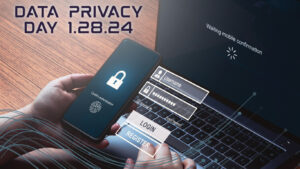 Less fun than Step in a Puddle and Splash Your Friends Day (1/11) but definitely more important than National Bobblehead Day (1/7), Data Privacy Day is January 28th and a great opportunity to tighten up your online practices. Social media accounts like Facebook, Instagram, and X are among hackers’ favorite targets – as they use credentials that are leaked or stolen using phishing emails – so let these be your priority today. Reset your passwords, clean out your spam folders, and never, ever click the “click here” link from an unknown address.
Less fun than Step in a Puddle and Splash Your Friends Day (1/11) but definitely more important than National Bobblehead Day (1/7), Data Privacy Day is January 28th and a great opportunity to tighten up your online practices. Social media accounts like Facebook, Instagram, and X are among hackers’ favorite targets – as they use credentials that are leaked or stolen using phishing emails – so let these be your priority today. Reset your passwords, clean out your spam folders, and never, ever click the “click here” link from an unknown address.
January 19, 2024
 It wouldn’t be a new year without there being a new effort to steal customer data. Back in October, the network hardware provider Citrix disclosed a high-severity vulnerability to its corporate users, but Comcast/Xfinity waited over a week to implement a patch to address the vulnerability. As a result, hackers stole more than 35 million usernames and passwords as well as personally identifying information (PII) like the last 4 digits of Social Security Numbers from Xfinity clients.
It wouldn’t be a new year without there being a new effort to steal customer data. Back in October, the network hardware provider Citrix disclosed a high-severity vulnerability to its corporate users, but Comcast/Xfinity waited over a week to implement a patch to address the vulnerability. As a result, hackers stole more than 35 million usernames and passwords as well as personally identifying information (PII) like the last 4 digits of Social Security Numbers from Xfinity clients.
“Citrix Bleed,” as the hack has been dubbed, has been described as “one of the year’s most severe and widely exploited,” with a severity level of 9.4 out of 10. Other high-profile companies from Boeing and Toyota to Bank of China and law firm Allen & Overy have also been affected.
If you have been a part of this (or another data breach), there are some steps you can take to mitigate any damage done:
- Monitor your credit. Set up an account at freecreditreport.com to check for any suspicious activity and check in periodically. If you get an alert that your credit has dropped substantially, multiple accounts have been opened in your name, or other activities you didn’t approve, contact the credit agencies immediately.
- Clear your cache. Saving usernames and passwords is convenient, but once compromised, you should delete all these cookies and history.
- Change your passwords. All of them. Of course, Comcast is asking all its Xfinity clients to change their passwords (and use multi-factor authentication when possible) but once there’s a breach in one place, it’s good practice to update all your passwords (especially if you’ve been using the same password on multiple sites—which you should avoid).
Even if you haven’t been affected by this specific hack, the new year is a great time to step up your online security practices.
- Build a wall. Consider installing a software firewall on your computer or using a hardware firewall to bolster the protection that comes with your broadband router.
- Patch, patch, patch. If you get a pop-up that any software or operating systems needs to be updated or patched, don’t wait. Stop what you’re doing and start the update.
- Back up and restart. Back up your system regularly and save your work and shut your computer down nightly. An “on” machine is a vulnerable machine.
- Beef up your passwords. “Password123” is soooo 2023. Choose complex passwords that use letters, numbers, and symbols, and set reminders on your calendar to change passwords regularly.
- Use two-factor authentication. Yes, it’s a pain, but even with the best passwords, hackers have a good shot at cracking the code. Requiring a quick text or email adds another layer of defense.
Hackers are getting more and more resourceful with each passing year, and they’re ready and able to take advantage of any vulnerability that pops up. Any company – banks, cell phone providers, and even the larger cable providers – are vulnerable to the same breaches, and when successful, these hacks can have devastating and far-reaching consequences. While you can’t control how they fight cyberattacks, you can do your part by beefing up your own security.
December 15, 2023
 Some monumental changes in the technology landscape happened in 2023 and – just like the change to your waistline when your new diet kicks in – big changes are on the horizon for 2024. Artificial Intelligence (AI) has only begun to show us what it can do, so we can expect to see more technologies, companies, service providers, and even individuals who embrace AI to do everything from assist their call centers to automate the most tedious tasks to even begin taking on more creative endeavors. What else is in store for the new year?
Some monumental changes in the technology landscape happened in 2023 and – just like the change to your waistline when your new diet kicks in – big changes are on the horizon for 2024. Artificial Intelligence (AI) has only begun to show us what it can do, so we can expect to see more technologies, companies, service providers, and even individuals who embrace AI to do everything from assist their call centers to automate the most tedious tasks to even begin taking on more creative endeavors. What else is in store for the new year?
- Multi-networking. Experts predict that rather than using a single cloud service for ALL one’s personal or business needs, consumers will begin finding the best service for each individual need based on the provider’s niche expertise.
- Improved cybersecurity. With more ransomware attacks occurring in the first nine months of 2023 than in all of 2022, “hardening” of our defenses is a must for 2024. Cybersecurity firms are increasing their offerings, and the public should make it a resolution to bolster their defenses with all available tools.
- Expansion of rural broadband. The FCC has awarded billions of dollars to rural broadband companies to begin building, expanding, and improving connectivity to rural areas. This project will bring education, jobs, and innovation to previously disconnected neighborhoods and allow these regions to flourish.
- New VR and XR technologies. From Apple to Meta, Samsung to Nintendo, a bevy of firms are taking another crack at virtual reality (VR) and extended reality (XR) goggles and experiences. Although the evolution of this technology has been slow (and their interfaces too expensive for most users), experts predict that the manifold business/innovation applications for this tech may be the driving force that keeps developers working to perfect their products.
The pace of technological advances seems to be picking up speed every year, and often it feels tough to keep up. Industry experts appeal to consumers to “lean in” to advances like AI. But if it ever feels like too much, we’re all for unplugging for a while and leaning into that wonderful pile of good old-fashioned paper books you got for Christmas. Happy New Year!
November 17, 2023
 Gone are those Christmas days when you could buy your kids a board game or your spouse a vacuum (honestly, those days were never a thing!). Today, it’s all about the tech. But where do you start? As Black Friday approaches, here are a few tips for getting the best gadgets of the year without breaking the bank (or standing in line all Friday!) …
Gone are those Christmas days when you could buy your kids a board game or your spouse a vacuum (honestly, those days were never a thing!). Today, it’s all about the tech. But where do you start? As Black Friday approaches, here are a few tips for getting the best gadgets of the year without breaking the bank (or standing in line all Friday!) …
Talk to your robots. Ask Alexa or Siri if they have any recommendations of hot items or big sales. Don’t be surprised when Alexa directs you to Amazon.
Sign up EVERYWHERE. Most companies offer 10-20% off your first purchase when you provide your email and/or phone. Sign up now, get your offers, buy, and then unsubscribe by texting STOP.
Consult your cheat sheet. Go to www.blackfriday.com to check out the ad scans for all the big box stores. If you’re not sure what’s hip and cool, check these pages to get an idea (and maybe even find a good deal).
Download apps. Most people do their online shopping on their phones, and websites just aren’t optimized for that. Download apps for your favorite stores and you’ll save time entering payment details, have access to deals, and get a more customized, curated experience.
Do some in-person recon. Store salespeople and managers probably hate this, but if you just want to get your hands on a laptop, tablet, or other gadget to make sure it’s right for you, visit your local Best Buy well before Black Friday and try it out. You can check the price online and maybe even make a local shop’s day by skipping the app altogether and buying in-store!
As always, it’s the thought that counts when it comes to great gift giving. Your kids, parents, and partner will appreciate whatever tech you find for them this year – just make sure to keep the receipts in case they wanted socks all along…
October 31, 2023
Cybercrime isn’t limited to online. Mobile devices, such as smart phones and laptops, are frequently stolen when left unattended. Sometimes, the most direct action a cybercriminal can take is surprisingly low-tech. Click HERE to watch a video about physical security for your devices. #CyberAware #CyberSecurityMonth
October 30, 2023
It’s important to have a strong password to protect yourself from cybercriminals. It’s a good practice to use phrases as passwords, and to mix in different symbols and numbers as well. Ensure your passwords are strong and avoid using the same password for all of your online accounts. Click HERE to watch a video about safe password practices. #CyberAware #CyberSecurityMonth
October 27, 2023
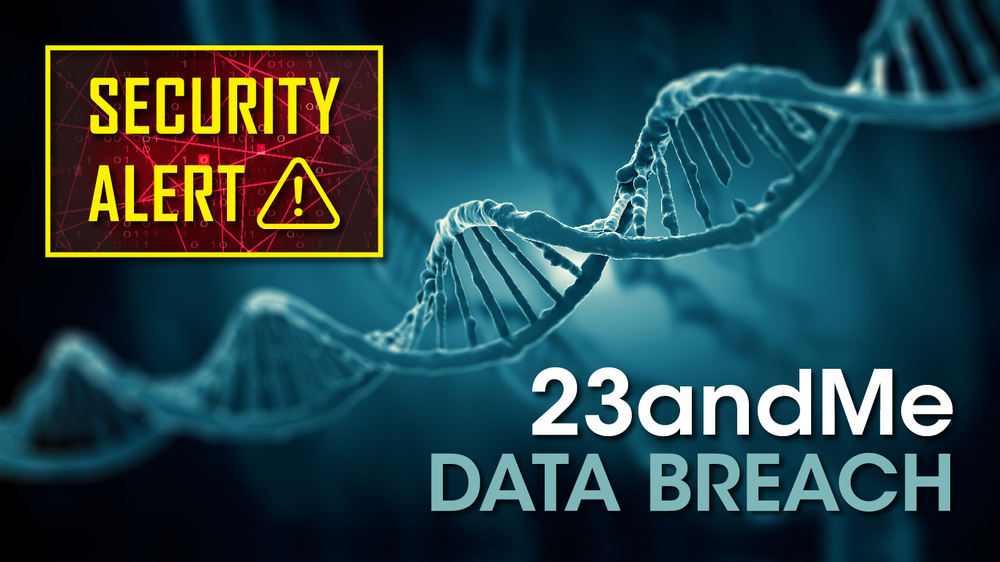 Once upon a midnight dreary, a connected consumer grew nervous and weary. He mailed in his hair (and not for free!), to the family tree company, 23andMe. No specter took over, no ghouls attacked. But still, just as scary, that firm was bloody hacked!
Once upon a midnight dreary, a connected consumer grew nervous and weary. He mailed in his hair (and not for free!), to the family tree company, 23andMe. No specter took over, no ghouls attacked. But still, just as scary, that firm was bloody hacked!
That’s right. Earlier this month, a hacker stole data from the genetic testing company, 23andMe, and has now leaked millions of user records. Extremely personal data – including health, genetic, and family information – from customers in the U.K. and U.S. was released to the cybercrime forum BreachForums.
23andMe was made aware of the first of two hacks in early October and determined that the information was stolen using a technique called credential stuffing, essentially trial and error attempts using combinations of usernames and passwords used elsewhere on the internet. In many cases, these credentials were hacked during other data breaches and released into the dark corners of the internet, only to be taken up by Golem, the perpetrator of this hack.
The damage was double bloody in this case because of an opt-in feature on the site called DNA Relatives (which essentially opened the door between possible relatives’ accounts). If the hacker was able to break into one account, he suddenly had ready access to potentially dozens more.
23andMe has proven a valuable resource for thousands of people, bringing families together and helping identify potential hereditary health concerns, but this hack has uncovered a potential monster in the closet. Experts recommend that if you use this site – or have family members who do – update your username and password immediately and opt-in to the multi-factor authentication to protect yourself against future hacks.
October 26, 2023
Don’t get held hostage. Ransomware is one of the fastest growing methods of #cyberattack. Ransomware will cost its victims around $265 billion annually by 2031, Cybersecurity Ventures predicts, with a new attack every 2 seconds as ransomware perpetrators progressively refine their malware payloads and related extortion activities. Everyone is at risk. Click HERE to watch a video about the dangers of ransomware. #CyberAware #CyberSecurityMonth
October 24, 2023
Mobile device security is just as important as physical or computer security. Just as we lock the doors on our homes and the screens on our computers, you should ensure your phone is locked with a passcode or encryption to help prevent #cybercrime. Click HERE to watch a video about safe mobile security practices.
#CyberAware #CyberSecurityMonth
October 20, 2023
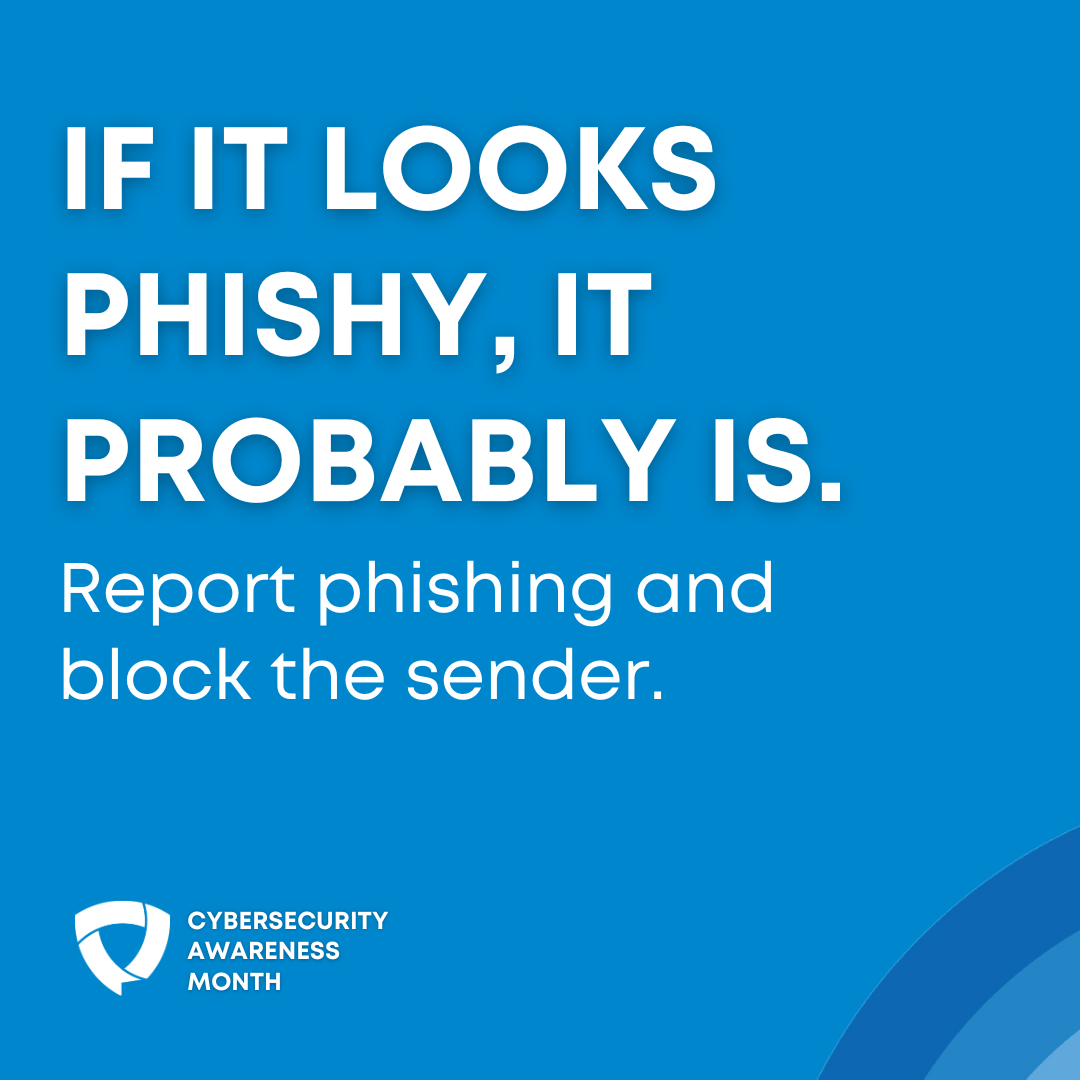 Don’t get hooked! Phishing emails are like sneaky bait trying to reel you in. Learn how to spot them and report those fishy attempts to keep your inbox clean and your personal information safe.
Don’t get hooked! Phishing emails are like sneaky bait trying to reel you in. Learn how to spot them and report those fishy attempts to keep your inbox clean and your personal information safe.
Phishing is when criminals use fake emails, social media posts or direct messages with the goal of luring you to click on a bad link or download a malicious attachment. If you click on a phishing link or file, you can hand over your personal information to the cybercriminals. A phishing scheme can also install malware onto your device.
No need to fear your inbox, though. Fortunately, it’s easy to avoid a scam email, but only once you know what to look for. With some knowledge, you can outsmart the phishers every day.
Learn more: https://staysafeonline.org/theft-fraud-cybercrime/phishing/ #CybersecurityAwarenessMonth
October 13, 2023
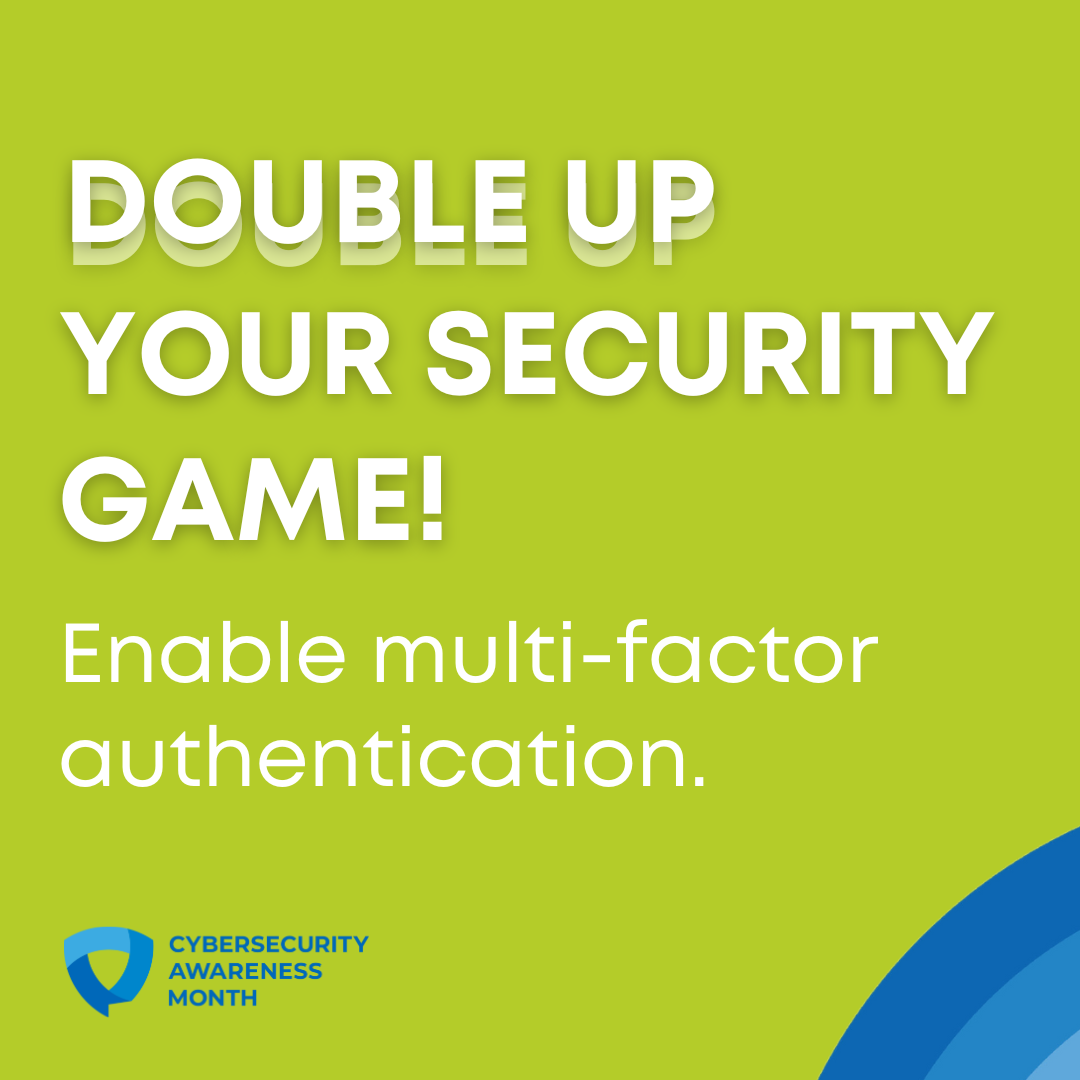 One lock, two locks, three locks… who needs a keychain? With multi-factor authentication, you’re like an expert online locksmith! Multi-factor authentication is sometimes called two-factor authentication or two-step verification, and it is often abbreviated to MFA. No matter what you call it, multi-factor authentication is a cybersecurity measure for an account that requires anyone logging in to prove their identity multiple ways. Typically, you will enter your username, password, and then prove your identity some other way, like with a fingerprint or by responding to a text message. Don’t give hackers an easy way in. Protect your accounts and sleep like a baby! Learn more by clicking HERE. #CybersecurityAwarenessMonth
One lock, two locks, three locks… who needs a keychain? With multi-factor authentication, you’re like an expert online locksmith! Multi-factor authentication is sometimes called two-factor authentication or two-step verification, and it is often abbreviated to MFA. No matter what you call it, multi-factor authentication is a cybersecurity measure for an account that requires anyone logging in to prove their identity multiple ways. Typically, you will enter your username, password, and then prove your identity some other way, like with a fingerprint or by responding to a text message. Don’t give hackers an easy way in. Protect your accounts and sleep like a baby! Learn more by clicking HERE. #CybersecurityAwarenessMonth
October 13, 2023
Email is a favorite tool of hackers seeking to steal sensitive personal information or install malware or ransomware on your devices. Be wary of suspicious emails. Click HERE to watch a video about safe email practices.
October 6, 2023
 Technology is evolving faster than ever, it seems, and with it comes a whole new language for describing those things, actions, products, and – yes – robots, that didn’t exist just a few years ago. But, just as we learned to swap out “chimney sweeps” for “HVAC repairmen,” we can evolve and start embracing the next generation of tech terms.
Technology is evolving faster than ever, it seems, and with it comes a whole new language for describing those things, actions, products, and – yes – robots, that didn’t exist just a few years ago. But, just as we learned to swap out “chimney sweeps” for “HVAC repairmen,” we can evolve and start embracing the next generation of tech terms.
A few basics to help you shine at your next cocktail party or connect with your kids:
- Algorithm– Basically, a set of instructions for a program, but also the complex set of calculations that seems to magically tailor what you see in searches, on ads, and on your social media feeds.
- Application(app, for short) – Software designed to complete a specific task, often available on your phone.
- Artificial Intelligence (AI) – Machines simulating (usually very quickly) human actions. AI is being embraced in nearly every industry to streamline repeatable jobs, expedite tasks, learn preferences, and even answer more and more complex questions.
- Bug– An error in the code that manifests in strange functioning or errors on a website.
- Cloud computing– Rather than storing your data on your hard drive, data is stored on a remote server.
- Front end vs. back end– The front end of an app is what you, the user, see and interact with, while the back end is the server side that provides functionality.
- Database– Think of this as the world’s biggest closet for information, accessible by computers, and constantly growing.
- Data mining– Essentially, all companies do this today. They take data they collect from surveys, feedback, and buying practices and tailor their marketing tactics based on that data.
- Pixels per inch (PPI)– This measurement defies how clear a digital image is. The higher the number (on a monitor or phone screen), the sharper the image.
- Virtual Private Network (VPN)– These networks allow you to use a public internet connection as if it were private (providing you more security and less chance of being hacked).
There! You’re now ready for an internship at Google or at least a conversation with your neighbor the programmer. And if this new jargon is still feeling foreign, don’t worry. There’s always new tech – and the language to describe it! – just on the horizon.
October 5, 2023
Phishing attacks are one of the most common ways that hackers attempt to lure victims. Be #CyberAware when handling suspicious emails or social media messages. Click HERE to watch a video and learn more about the dangers of phishing attacks.
October 4, 2023
September 29, 2023
 Excel! That intimidating green icon on your Program ribbon that you only visit before tax season or to create that invite list for this year’s Halloween bash. And, while Excel certainly provides a lot of advanced formulas and functions, learning a handful of shortcuts will make you more efficient than you ever thought possible.
Excel! That intimidating green icon on your Program ribbon that you only visit before tax season or to create that invite list for this year’s Halloween bash. And, while Excel certainly provides a lot of advanced formulas and functions, learning a handful of shortcuts will make you more efficient than you ever thought possible.Most importantly, all of your go-to Windows shortcuts work in Excel. Ctrl + N to open a new book, Ctrl + C to copy and Ctrl + V to paste, Ctrl + Y to repeat the last function, and – a fan favorite – Ctrl + Z to undo the last action. (On Macs, use the command key instead of CTRL.)
Specific to Excel, though, are these keyboard gems which will have your forsaking your mouse forever:
|
Keyboard Shortcut |
Action |
|
F2 |
Edit a cell |
|
Ctrl + Shift + & |
Add a border to the selected cell |
|
Alt + H + H |
Fill a cell with color |
|
Tab |
Move to the next cell |
|
Shift + Tab |
Move to the previous cell |
|
Shift + Space |
Select an entire row |
|
Ctrl + Space |
Select an entire column |
|
Shift + Space, Ctrl + – |
Delete an entire row |
|
Alt + H + D +C |
Delete an entire column |
|
Ctrl + H |
Display Find and Replace |
|
Alt + Down Arrow |
Activate a Filter |
|
Ctrl + K |
Insert a hyperlink |
Possibly the best shortcut when you’re stuck and don’t know where to turn next is Alt + Q which jumps you to the “Tell me what you want to do” search box, where you can ask for the help you need. With these shortcuts and a little practice, Excel can be your go-to tool for creating and organizing lists, doing calculations, tracking progress (for example, a fitness program weights and measures), and even doing your taxes.
Once you’ve mastered the basic functions, check out a course at Udemy to learn more advanced capabilities or visit SimpliLearn to learn some basic formulas. When you’ve got your head around all this, you MAY be able to tackle your 6th grader’s math homework!
August 11, 2023
 Our phones are our lifelines, our libraries, our maps, and, of course, our entertainment these days. So when we start to see the battery life slowly slipping away, panic can set in. But don’t rush out and buy a new battery yet; there are plenty of ways to conserve your battery life so you can play/call/text on!
Our phones are our lifelines, our libraries, our maps, and, of course, our entertainment these days. So when we start to see the battery life slowly slipping away, panic can set in. But don’t rush out and buy a new battery yet; there are plenty of ways to conserve your battery life so you can play/call/text on!
Charge properly. When and how you charge is critical to maintaining a strong battery life. First, use the charger that came with the phone. (Wireless chargers may be quicker daily, but they end up killing your battery over time.) Next, try not to let the charge drop below 20%. Finally, turn your phone completely off once a week (and unplug your laptop periodically to let it discharge as well).
Update your settings. Lots of settings suck your battery life without giving you much in return. Go to Settings and dim your display. Turn off any “always on” displays and change your wallpaper if it contains any movement. You can also put your phone in “battery saving” or “low power” mode. You’ll lose some functionality or graphic quality, but not much.
Mind your apps. When your battery first starts to falter, swipe until you’ve closed all the apps running in the background. You may be surprised to see how many unused apps are on the loose! You may also consider the “lite” version of common apps like Google Maps that provide similar services but remove some of the flashier functions that drain your battery.
Disconnect. When possible, turn off GPS, WiFi, and Bluetooth connections and change email settings to “sync less often.”
Keep it cool. Not only is extreme heat bad for your phone’s functions, it kills your battery. Keep your phone out of direct heat, don’t leave it in a hot car, and keep it in a pocket or cool purse while outside.
The average lifespan for a phone battery is one to five years, with the disparity attributed almost exclusively to good charging habits. If you’re smart about your charging and mindful of everything running on your phone – especially what’s running in the background – you can extend the life of your battery and enjoy that final episode of THE LINCOLN LAWYER while everyone else has to read the book…
July 28, 2023
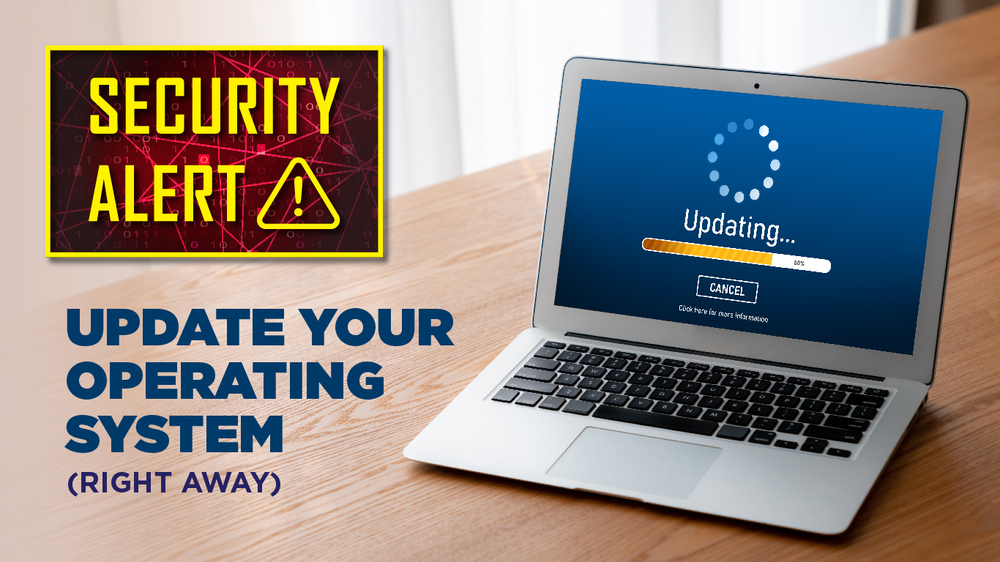 “I don’t have time for that operating system (OS) update, I’m in the middle of something. I don’t need any new features. There’s no risk in NOT updating, right?” Wrong! OS updates provide an essential connection between your computer and support, ensuring that bugs are fixed and risks are mitigated. And – of course – hackers are taking advantage of people who aren’t keeping their updates and patches current.
“I don’t have time for that operating system (OS) update, I’m in the middle of something. I don’t need any new features. There’s no risk in NOT updating, right?” Wrong! OS updates provide an essential connection between your computer and support, ensuring that bugs are fixed and risks are mitigated. And – of course – hackers are taking advantage of people who aren’t keeping their updates and patches current.
Perhaps the biggest risk in not using the most current OS is security. Consider that as attacker technologies have evolved, your security deterrents and alerts have not. Older systems may not have offered two-factor authentication upon log-in or have been able to run regular scans to detect weaknesses and stand-up barriers to attack. Hackers know these weaknesses and have begun to make it a practice to seek out users with older operating systems because they know they are softer targets.
Businesses are certainly suffering from such attacks – saving money on OS updates that result in thousands or millions in downtime and theft of data – but the consequences are real for individual users as well. If attacked, your computer could be off-line for days or weeks, your personal and financial data could be at risk, and, even if you aren’t attacked, you’re likely to be moving at a slower pace than an up-to-date OS can facilitate, and you may not be able to use all the cool and emerging tools that are compatible with current Operating Systems.
In 2016, the Mirai botnet was used to attack hugely popular sites like Twitter and Netflix, denying service to millions of their users simply because those billion-dollar companies hadn’t updated their firmware or OS. Just imagine what such a weapon could do to regular people!
If you aren’t sure what operating system you’re running, follow these simple steps:
- For PCs, click the Windows button/Settings/System/About. Scroll to Windows specificationsand note the edition and version. To see the newest version and learn how to update your Microsoft OS, visit Microsoft Support.
- For Macs, click the Apple button in the upper left corner and select About This Mac. The version number appears after macOS. To see the newest version and learn how to update your Apple OS, visit Apple Support.
Remember that as software and operating systems evolve, so too must your hardware. New Operating Systems certainly can work on older computers – but not forever. Whenever upgrading to a new OS, double-check that your machine meets the minimum system requirements. If not, it may be time to start shopping for a new computer! (Don’t worry, they’re cheaper, lighter, and faster than when you did this last!)
July 14, 2023
 Hiking, biking, swimming, and grilling… all wonderful ways to enjoy your summer. But sometimes, the only way to beat the heat is to head into the AC and binge great TV until you pass out. With so many streaming options, are you using your services efficiently? Are you being double-billed for bundled services? Could you save money by making some adjustments? Many services that used to stand alone (ESPN, Disney, and Hulu, for example) are now bundled into a single service. So, if you’re still paying for them individually, don’t! Here’s how to make the most of your streaming – and watch some killer shows for less:
Hiking, biking, swimming, and grilling… all wonderful ways to enjoy your summer. But sometimes, the only way to beat the heat is to head into the AC and binge great TV until you pass out. With so many streaming options, are you using your services efficiently? Are you being double-billed for bundled services? Could you save money by making some adjustments? Many services that used to stand alone (ESPN, Disney, and Hulu, for example) are now bundled into a single service. So, if you’re still paying for them individually, don’t! Here’s how to make the most of your streaming – and watch some killer shows for less:
- Start cutting.Either cancel services or put them on hold (most allow a three-month hold) and add service back in one at a time. If you find you’re not missing anything, cancel the held services.
- Order, binge, cancel.How many times have you ordered a service for one show, watched it all in a weekend, and forgot to cancel? Because most services allow you to cancel any time, when a show comes up you’re interested in, clear your schedule and make use of the seven-day free trials to binge and then cancel.
- Enjoy the snack breaks.Many services offer a basic subscription that includes commercials. While one of the joys of streaming is no ads, if you’re looking to save a few bucks, choose a non-premium service and use those bearable breaks to make a snack (or do some jumping jacks!).
- Browse free services.There are dozens of free TV and movie streaming services that have a surprising supply of not only older movies but some current hits. Good advice is to start a Watch List or Favorites when you have time to browse, so you aren’t sifting through hundreds of titles every time you sit down to watch.
- Get a library card.Hoopla is a great app that pairs with your local library card to provide not only streaming but also download options so you can watch even without WiFi (family road trip, here we come).
- Turn on the tunes instead.If you’re TVed out or just love music, you’re in luck. Streaming music is cheap (usually around $10/month) and selections are almost endless. According to CNET.com, cost and connectivity are providers’ main differentiators, but some boutique services are also competing with ultra-high quality Dolby Atmos audio and features like karaoke and audio book libraries. For head-to-head comparisons and additional information, check out: Best Music Streaming Services
As a big haul at this year’s Emmy nominations indicates, there is terrific television offered through streaming services today. With a little research – and some monitoring of your bank balances – you can enjoy a summer’s worth of exceptional entertainment without emptying your wallet.
June 9, 2023
 Now, more than ever, we must be diligent about protecting our data because – as you’re about to learn – even the best laid plans may not save the day.
Now, more than ever, we must be diligent about protecting our data because – as you’re about to learn – even the best laid plans may not save the day.
Managed Care of North America, a dental benefits provider, reported that it was a target of a massive data breach affecting almost 9 million people. A forensic analysis determined that the company’s network had been compromised and infected with malware, resulting in a number of files being copied or removed. The ransomware group, LockBit, demanded $10 million or they would publish the data. MCNA did not pay the ransom, and the pieces of data (including SSNs, personally identifiable information, and health records) were released.
Beneficiaries of 112 insurance plans (including Medicaid) were notified and offered 12 months of credit monitoring, but victims of health data breaches have additional concerns beyond their credit. Sometimes they have the insurance cancelled, reimbursements are denied, or they have to reapply for coverage (resulting in lapses and potentially uncovered claims).
Here are a few steps you can take to get your healthcare back on track after a breach:
- File an Identity Theft Report with the Federal Trade Commission (https://identitytheft.com).
- If you use Medicare or Medicaid, call 800-HHS-TIPS to report the theft.
- Monitor your credit carefully and contact the three credit bureaus if an unpaid charge or attempt to collect appears.
- Contact all your medical providers and get a complete record of all services, including those for your partner and children. This is important to ensure no services you or your family did not receive were paid, but also to ensure all information (like blood type, implanted devices, and allergies to medications) is current and correct.
Being the victim of theft is mentally, emotionally, and financially exhausting, but having your personal medical data taken is so much more invasive. With so much of our medical data now housed online, a breach is (unfortunately) always possible. What happens after is up to you.
June 3, 2023
 It’s that time again! Time to sweep out the cobwebs and the empty pizza boxes that got us through the cold winter and breathe some fresh air into our homes and workplaces. And, when you’re finished alphabetizing the contents of your pantry, your technology (physical and digital) could use some feather-dusting as well. Here’s how:
It’s that time again! Time to sweep out the cobwebs and the empty pizza boxes that got us through the cold winter and breathe some fresh air into our homes and workplaces. And, when you’re finished alphabetizing the contents of your pantry, your technology (physical and digital) could use some feather-dusting as well. Here’s how:
Your Desk
- Feather-dust. Literally. Clean up your workspace by wiping down your computer and screens with a soft microfiber cloth and using compressed air to get into your keyboard.
- Untangle. Unplug that tangle of cords under your desk, remove any peripherals you don’t need, bundle cables together using zip ties, and plug the new bundles into a surge protector. Organized, clean, and easy to know what you’re plugging and unplugging in the future!
Your Hardware
- Recycle. Big box stores like Best Buy have drop boxes where you can leave old tech they will either refurbish, strip for parts, or dispose of responsibly. Make sure to wipe your hard drive before dropping.
- Trade in. Check with your provider for trade-in options. This could knock a few bucks off your next phone or tablet.
- If you don’t really need the money (or the upgrade), reach out to a local school or library. They can always use computers and tablets, however old, for teaching, training, and reading e-books.
Your Digital World
- From the Start menu on PCs, go to Uninstall a Program and see where most of your memory is being used. If there are programs you never use, delete. (Use the Launchpad on Macs.)
- Delete or back up. Go through photos, documents, and folders where temporary files tend to accumulate and delete anything you don’t love or isn’t saved elsewhere. Back up what you dowant to keep with FileHopper, Google Drive, or iCloud.
- Freshen up your browser. A lot of digital detritus can accumulate in a year, so use your internet settings to clear your cache, clear browsing history, and remove unused bookmarks. (Remember that this will delete any saved passwords, but it’s probably time to refresh those anyway!)
All done? Now go outside and enjoy some fresh air. Your computer (and all your work) will be there when you get back!
May 19, 2023
 Have you ever tossed out an empty package of something you bought on Amazon and LOVED but couldn’t remember what it was called? (And then spent a day scrolling through products trying to find “the one”?) Never again! Here are a couple powerful tools on the Your Orders screen that will make shopping, returns, and more shopping a breeze!
Have you ever tossed out an empty package of something you bought on Amazon and LOVED but couldn’t remember what it was called? (And then spent a day scrolling through products trying to find “the one”?) Never again! Here are a couple powerful tools on the Your Orders screen that will make shopping, returns, and more shopping a breeze!
Beside your name at the top right, click Orders and Returns. The Your Orders screen appears. From here, you can complete these simple (but useful) tasks:
- See your orders. Seems obvious, but this screen shows everything you’ve ordered in the last 5 years with Amazon. You can filter by date range, search by keyword, and see when an item was delivered.
- Write a review. Part of Amazon’s appeal is the inclusion of reviews from real users like you. Love a product? Hate a product? Click the Write a product review box to leave your comments and shape other shoppers’ purchases based on your experience.
- Buy your favorites again. By clicking the blue Buy Again link on the order menu, you can pull up all the items you’ve bought that are still available to purchase again. If you really love it – and it’s something you run out of frequently – consider setting up a subscription when you purchase the item. You’ll save a few bucks and you’ll never run out again.
- Set up a return. Not every purchase is a winner, but one of Amazon’s claims to fame is its painless return process. Simply scroll through your history until you find the item you don’t want to keep, and click Return or replace item. You’re asked to provide a reason for the return and how you’d like to proceed (for example, replace with a different size or refund for Amazon credit or to your card). Then you’ll be directed to locations where you can drop the item, and at many drop sites, you don’t need to repackage it or even apply a return label! Try to get returns processed quickly, however, because most items cannot be returned after 30 days.
Amazon has become a daily tool for many of us, and oftentimes it seems overwhelming with SOOO many options. Using Your Orders is a great way to cut out some of the noise and repurchase things we already know we love. Shop on!
May 4, 2023
 As we celebrate World Password Day today, please tell us that LAST World Password Day was not the last time you changed your password… We all know that as we continue to get more connected online – shopping, banking, networking, gaming, and even dating – it’s more critical than ever that we choose strong passwords and update them frequently.
As we celebrate World Password Day today, please tell us that LAST World Password Day was not the last time you changed your password… We all know that as we continue to get more connected online – shopping, banking, networking, gaming, and even dating – it’s more critical than ever that we choose strong passwords and update them frequently.
Some of these tips should be old hat by now, but they’re still the best way to ensure your data is protected and your identity remains your own:
- Choose unique and complex passwords. Passwords that point to your favorite <insert team/child/place> are a gift to hackers so settle on a unique, impossible to guess password with a good mix of upper- and lower-case letters, numbers, and symbols.
- Don’t let your fingers do the walking. A complex password is no good if you use keys that are consecutive on a keyboard (e.g., QWERTY) or form a pattern on your number pad (e.g., 741852).
- Use different passwords for each account. It’s so tempting to stick with one password for every account, but remember: if a hacker cracks one password, he has access to ALL your accounts.
- Double your protection. For your very sensitive accounts (think banking or anything with personal data), set up two-factor authentication. This way, even if someone manages to guess your password, there’s one more line of defense.
- Change passwords regularly. Set a reminder on your phone to change your passwords every few months to stay one step ahead of the hackers.
As always, if you’re struggling to stay on top of your passwords (or think of tough-to-beat ones), you can always use a password manager like Password Genie for help. They not only help you generate passwords but also manage your access and make two-step authentication easy!
April 21, 2023
 THE FOLLOWING IS USED WITH PERMISSION FROM THE BLOG.BROADBAND.TIPS SITE: https://blog.broadband.tips/the-human-way-to-make-chat-gpt-work-for-you/?spid=20732. HARDYNET DOES NOT TAKE ANY POSITION ON THE USE OF CHATGPT.
THE FOLLOWING IS USED WITH PERMISSION FROM THE BLOG.BROADBAND.TIPS SITE: https://blog.broadband.tips/the-human-way-to-make-chat-gpt-work-for-you/?spid=20732. HARDYNET DOES NOT TAKE ANY POSITION ON THE USE OF CHATGPT.
The robots are coming! The robots are coming! The robots are coming and they’re… really quite helpful? Artificial intelligence (AI) is already a huge part of our days. It helps Amazon make good suggestions, it keeps our homes safe and connected, it even helps us find the fastest way to work – and the nearest coffee shop to your traffic jam. As this technology becomes more sophisticated, though, there are even more ways it can make our lives easier. The robot du jour is ChatGPT.
In a slightly creepy horror movie opening monologue, ChatGPT describes itself this way: “I am a language model developed by OpenAI. I was trained on a diverse range of Internet text, including websites, books, and more. This allows me to generate human-like text responses.” As if it anticipated our thoughts of a robot takeover, it continues, “I am still a machine. I do not have thoughts, feelings, or consciousness.” What a relief.
So how can ChatGPT help you? You can start by opening a free account at chat.OpenAi.com. Access the main interface and then, well, interface with it! Ask it anything. You can treat it like Alexa, asking it to provide information. While you should double-check its answers, this is a great way to kick off a research paper. But don’t stop there.
- Update your resume.ChatGPT can help format and create a custom resume and cover letter for each job you apply for. It can even ask questions your interviewer is likely to ask, based on industry information it finds in seconds.
- Help do your fifth grader’s homework. They can do math (so just ask for help!).
- Speak another language.Especially helpful in business when you may want to just add a few words to make a foreign colleague feel welcome, ChatGPT can provide translation skills. (It’s not recommended that you do any formal deals using this service yet.)
- Draft long-form content.You’ve no doubt received spam messages obviously written by machine as they just feel a bit off. AI is always making progress, though, so you might use ChatGPT to get you started on a letter or essay – using parameters you provide – and then use your time to polish and humanize the content it produces. Even if the first draft isn’t perfect, you’ve saved yourself some time in development.
- Have a nice chat.While ChatGPT reminds you it’s not a sentient being, it can learn how to react to your inputs, so if you have an issue you just need to bounce off its walls, go for it! It may have some interesting solutions you hadn’t thought of.
The interface is always learning and, because so many people are interested, answers come slowly, so be patient, fact-check its answers before sharing with others, and take any advice it offers on what you should do with your life with a grain of salt.
April 14, 2023
 Imagine being out in the freezing rain while everyone else is inside. Imagine it’s dark all around you. Now imagine you’re 150 feet in the air with an uninsulated wire in your hands, working to bring power back to a community. Or splicing hair-thin fiber-optic cables together to restore broadband Internet service. Being a lineman is one of the toughest, most taxing jobs in the country and one we absolutely can’t live without. So, this April 18th, we celebrate Linemen Appreciation Day. If you’re warm inside, lights on, music playing, appliances whirring…you have a lineman to thank!
Imagine being out in the freezing rain while everyone else is inside. Imagine it’s dark all around you. Now imagine you’re 150 feet in the air with an uninsulated wire in your hands, working to bring power back to a community. Or splicing hair-thin fiber-optic cables together to restore broadband Internet service. Being a lineman is one of the toughest, most taxing jobs in the country and one we absolutely can’t live without. So, this April 18th, we celebrate Linemen Appreciation Day. If you’re warm inside, lights on, music playing, appliances whirring…you have a lineman to thank!
March 24, 2023
 There was a time when traffic was going to be what traffic was going to be. When we knew our flight was cancelled when we rolled up to the gate to find a flight attendant shaking her head and directing us to the nearest Cinnabon. But times have changed, and technology is here to make travel a breeze.
There was a time when traffic was going to be what traffic was going to be. When we knew our flight was cancelled when we rolled up to the gate to find a flight attendant shaking her head and directing us to the nearest Cinnabon. But times have changed, and technology is here to make travel a breeze.
On the Road
Google Maps has proven to be an invaluable resource for lost drivers and hardcore planners alike. You already know it provides near foolproof directions (driving, cycling, or walking!), but it has lots of additional features just waiting to be adopted into your summer travel plans:
- Beat the traffic. When you enter your start and endpoints, you can also enter your leave time and Google will tell you how traffic will look at that point. Or enter the time you want to arrive, and Google will tell you when to leave.
- Avoid speed traps. After entering the destination, blue megaphone icons appear on the map indicating speed traps. (PSA: Don’t speed, but if you’re a mile or two over, just slow down a bit when you come to these spots.)
- Set and get notifications. One new feature is perfect for travelers meeting others at a destination, a café, for example. Users can set the location notification so they can see in real time when their friends have arrived at the designated spot. By clicking “Share trip progress,” they can also let friends (or mom and dad) know where they are.
- Keep your hands on the wheel. With all the touchscreens, it’s tempting to scroll and press Google Maps while driving, but both Apple and Android allow you to talk to Google (“Hey Siri” or “Hey Google”) hands-free. You can ask about restaurants or gas stations nearby, what road to take to avoid a toll, or for step-by-step directions.
In the Air
Never miss a flight again – or get to the airport for a cancelled flight – and find some great deals with these amazing travel apps.
- Bargain hunt for tickets. You can log into Google Flights and choose a destination and set your travel times to “Any dates” and set an alert. When the flight price drops significantly, you’ll get an email instructing you how to buy your cheap tickets.
- Track planes in-flight. Use the FlightAware app to track any plane (commercial, charter, and even private) with only about a 30-second delay from live coverage. You can even set the GPS to see what plane is flying over you right now.
There’s plenty of time to unplug from technology and enjoy the great outdoors, a beautiful museum, or a bustling city abroad – but BEFORE you go, let these tools be your guide. You’ll get where you’re going faster, with fewer headaches, and with a few spare bucks in your pocket to spend on refrigerator magnets from all over the Google map!
February 23, 2023
![]() This spring has been the season of the late/cancelled flight leaving passengers stranded for hours (and sometimes days) at airports across the nation. Adding insult to injury, passengers often feel like they can’t step away from their gates for even a moment or they’ll miss an update about their flights. iPhone to the rescue!
This spring has been the season of the late/cancelled flight leaving passengers stranded for hours (and sometimes days) at airports across the nation. Adding insult to injury, passengers often feel like they can’t step away from their gates for even a moment or they’ll miss an update about their flights. iPhone to the rescue!
If you have iMessage on your phone, you already have the tools you need to track your flight in real time without having to download the airline’s app. Before you travel, you’ll need to complete a few set-up steps:
- Enable iMessage (this app doesn’t work on SMS/MMS).
- Make sure your flight number appears in a text (incoming or outgoing) in the following format: [Airline] [Flight number], for example, Delta 2112.
When your flight becomes trackable, that number will appear in your text messages underlined and clickable. Once you click the link, a menu appears asking if you wish to Copy Flight Code so you can send these details to someone else or Preview Flight. If you click this option, you’ll have access to flight status, terminal and gate of departure and arrival, time of departure and arrival, flight duration, and the likely number of the baggage claim carousel.
If you’re a true worrywart, you can also check out the details of your return flight by swiping left on the bottom half of the flight tracker.
Flights will still be cancelled, and gates will still be changed until the end of time, but using this simple tool has the power to set your mind at ease, plan ahead, grab a bite to eat without worrying your flight will leave without you, and save your friends a drive to the airport in Paris while you’re stuck at a Cinnabon in Cincinnati!
January 19, 2023
 With record cold temperatures (and higher fuel prices) sweeping the nation, now might be a great time to consider installing a smart thermostat in your home. The good news is that these little efficiency boxes have gotten easier to install even as the technology has gotten more advanced. There are lots of YouTube guides available, as well as instructions included with your unit, but the basic steps are as follows:
With record cold temperatures (and higher fuel prices) sweeping the nation, now might be a great time to consider installing a smart thermostat in your home. The good news is that these little efficiency boxes have gotten easier to install even as the technology has gotten more advanced. There are lots of YouTube guides available, as well as instructions included with your unit, but the basic steps are as follows:
- Turn off your HVAC at the breaker panel.
- Remove the faceplate. If it doesn’t pop right off, check for a tiny screw holding it in place.
- Snap a photo. Use your phone to take a picture of the wiring so you’ll know what wire connects to what.
- Remove the backplate from the wall.
- (Optional) Add a C-wire to power the thermostat. (Again, if wiring isn’t your thing, call an electrician.)
- Using the new backplate as a template, mark the wall with a pencil and drill holes to mark where the screws will go.
- Pull the thermostat wires through the backplate beforescrewing it into the wall.
- Connect the thermostat wires to the appropriate terminals (check the photo you took).
- Snap the new faceplate into place. If it doesn’t affix cleanly, check for loose wires, tuck them away, and try again.
- Switch your breaker back on.
- Once booted up, use the prompts to connect to the WiFi. Some smart thermostats come with a companion app for your phone which you’ll need to set up separately.
The smart thermostats available vary in price and features, so review and compare options at Consumer Reports here: https://www.consumerreports.org/products/thermostats-34572/smart-thermostats-200124/view2/
A few words of caution from Consumer Reports tester John Galeotafiore, though:
- Don’t try to replace your thermostat on a freezing cold (or super-hot) day or before guests are set to arrive – just in case you screw it up.
- If you don’t feel confident, or you hit an unexpected roadblock, call an electrician. Better to pay a little service fee than to damage your HVAC by accident!
December 8, 2022
 We’ve all done it. Hit “Reply All” when we meant to hit “Only reply to that one person so I can talk about everyone else.” Or sent a message noting the incredibly important document attached – and then forgot to attach the document.
We’ve all done it. Hit “Reply All” when we meant to hit “Only reply to that one person so I can talk about everyone else.” Or sent a message noting the incredibly important document attached – and then forgot to attach the document.
So, what can you do (besides panic/sweat/cry) while you wait for the recipients to receive and open your sinister message? If you’re sending your message from your Gmail account, a few quick updates to your settings and you can ensure you’ll be able to undo the damage BEFORE it’s done. Update your settings as follows:
- Click the Settings (the cog wheel) icon at the top of the screen. The Settings screen appears.
- In the Undo Send section, update the default delay (5 second) to 30 seconds.
- Click Save Changes to lock in the new setting.
You’re set! The next time you send an email in error – to the wrong recipient, with typos, or without an attachment – follow one of these steps to recall the message:
- When the option dialog appears in the lower left corner, select Undo, OR
- Enter CTRL+Z immediately. (This keyboard shortcut undoes the last action so the email delivery will be halted, and the message appears in your workspace to be edited.)
If you decide not to send the email, even after editing, the message will be saved in your Drafts folder.
Email is one of our most powerful tools for communicating in our personal and business lives, but the immediacy with which messages can be sent can lead to embarrassing moments. Thank goodness someone at Google knows how human we humans can be!
December 2, 2022
 Started in 2001 by the Indian company N.I.I.T while celebrating its 20th anniversary, World Computer Literacy Day now encourages tech companies and schools to take more of an interest in providing computer literacy to women, children, and those less inclined to embrace new technologies. What can YOU do today? Take a class! Teach a class! Give to a charity that supports digital literacy and inclusion. Help your grandparents set up their WiFi – or let your 9-year-old teach you about blockchain.
Started in 2001 by the Indian company N.I.I.T while celebrating its 20th anniversary, World Computer Literacy Day now encourages tech companies and schools to take more of an interest in providing computer literacy to women, children, and those less inclined to embrace new technologies. What can YOU do today? Take a class! Teach a class! Give to a charity that supports digital literacy and inclusion. Help your grandparents set up their WiFi – or let your 9-year-old teach you about blockchain.November 23, 2022
 That’s a wrap. You’ve had your second piece of pie, you’ve packed up the turkey for tomorrow’s sandwiches, and the tryptophan is kicking in. But before you fall asleep watching football (and more football!), make your plan for slaying Black Friday and Cyber Monday!
That’s a wrap. You’ve had your second piece of pie, you’ve packed up the turkey for tomorrow’s sandwiches, and the tryptophan is kicking in. But before you fall asleep watching football (and more football!), make your plan for slaying Black Friday and Cyber Monday!
Because last year so many companies struggled to keep shelves stocked for the holidays, many erred on the side of caution this year by overordering. This means warehouses are full and many companies are slashing prices to clear their inventory. Here are a few tricks for finding deals and landing those must-have gifts:
- Remember that you get what you pay for. Black Friday is a good chance for retailers to unload items that aren’t selling well (perhaps for a reason). Do your research, know what you want (and what you are willing to compromise), and don’t get sucked into buying an inferior product just because it’s cheaper.
- Join loyalty clubs. Brick and mortar and online shops often have loyalty clubs that alert you to big sales, allow you to put holds on hard-to-find gifts, and offer discounts if you sign up.
- Install a discount app. Installing an extension like Rakuten, Honey, or Capital One to your search engine applies discounts and coupon codes automatically and lands you a rebate check as savings accumulate.
- Sign up for email/text alerts. Most online shops offer a 10-15% discount on the first purchase if you sign up for notifications. Do your shopping, collect your discount, and then unsubscribe or reply “stop” to texts.
- Set daily alerts to seek out specific gifts. According to Adobe, for the best daily deals, shop Thursday for electronics, Friday for TVs, Saturday for toys, Sunday for sporting goods, and Monday for laptops.
- Start early and follow up. Many sales have already kicked off, so start “window-shopping” and don’t be afraid to make a purchase. Most online shops’ customer service will refund the difference if the price drops.
As inflation has made almost everything more expensive this year, hunting for bargains and being smart about purchasing is a great way to save a few bucks this holiday shopping season. Just remember to make a budget and stick to it, stay safe amidst the chaos, and treat yourself to something nice at the end of the day!
November 18, 2022
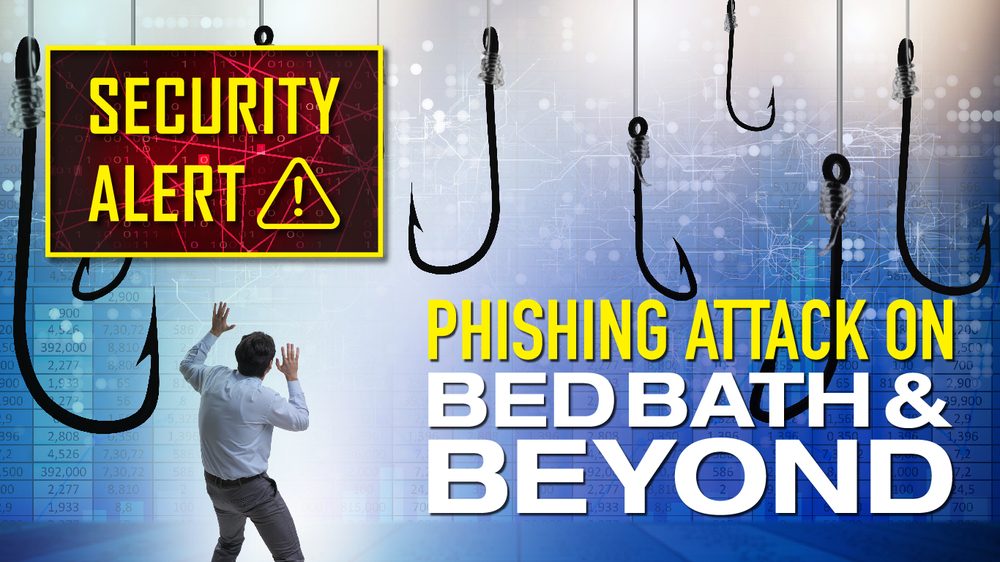 For the second time in a year, big box retailer Bed Bath & Beyond has been the target of a data breach that has put potentially thousands of customers’ personal information at risk. The store, which is already struggling financially, has asked its customer and technology chief to step down in hopes that they can get ahead of the problem under new leadership.
For the second time in a year, big box retailer Bed Bath & Beyond has been the target of a data breach that has put potentially thousands of customers’ personal information at risk. The store, which is already struggling financially, has asked its customer and technology chief to step down in hopes that they can get ahead of the problem under new leadership.
This breach was the result of a phishing expedition in which a BB&B employee provided access (likely unwittingly) to a hard drive and shared drives that may have contained personally identifiable information. Thus far, the company has declined to say what information may have been stolen, whether measures were in place to mitigate risk, or even what steps they would take to avoid future attacks. Not the best response from a company already on the ropes.
What could they have done differently? What can other retailers (big and small) do to keep their customers’ information safe?
- Hire a cyber/forensic expert to identify vulnerabilities and develop a risk mitigation strategy to keep this from happening again.
- Gain a very clear picture of what information has been (or could have been) divulged and communicate that to potentially compromised customers.
- Conduct training with employees to ensure they understand their role in online security and how to avoid being scammed or hacked.
- Have a cybersecurity program in place that helps protect, detect and respond to attacks.
- Ensure the new technology officer makes a public statement about how BB&B will make cybersecurity a priority in the future.
As we move into the biggest shopping season of the year, it’s critical that stores (brick and mortar and online) keep their customers safe from attacks. Bed Bath & Beyond – and other retailers like it – has the opportunity to change its current lax policies and put customers’ privacy first.
November 4, 2022
 You did it! You recorded your daughter’s ballet recital – all three hours of it – and you uploaded it successfully to YouTube. You want to send the link to grandparents and friends, but you don’t want them to have to sit through two hours and 55 minutes of other kids’ pirouettes and arabesques. What now?
You did it! You recorded your daughter’s ballet recital – all three hours of it – and you uploaded it successfully to YouTube. You want to send the link to grandparents and friends, but you don’t want them to have to sit through two hours and 55 minutes of other kids’ pirouettes and arabesques. What now?
Here’s how to link to a specific time in a YouTube video:
- Navigate to youtube.com and search for the video you want to share, or use the link provided if you uploaded the video yourself.
- Watch/scan the video and make a note of when the important part starts.
- Below the video, click SHARE(next to the thumbs up and thumbs down icons). A Share pop-up appears.
- Mark the checkbox at the bottom left and in the Start atfield, enter the time you noted. (This field may already be populated with the desired time if you paused the video at this moment.)
- Click COPY. The link (a new time-stamped URL) is now copied to your clipboard.
You can now paste the link into emails or even share it directly to Facebook, Twitter, Reddit, or other platforms from within the Share pop-up.
While this feature will earn you kudos from grandparents, it’s also a terrific feature for sharing specific steps in long tutorials, calling out critical moments in a news story, and ensuring that business clients don’t click away before they get to the good stuff!
October 28, 2022
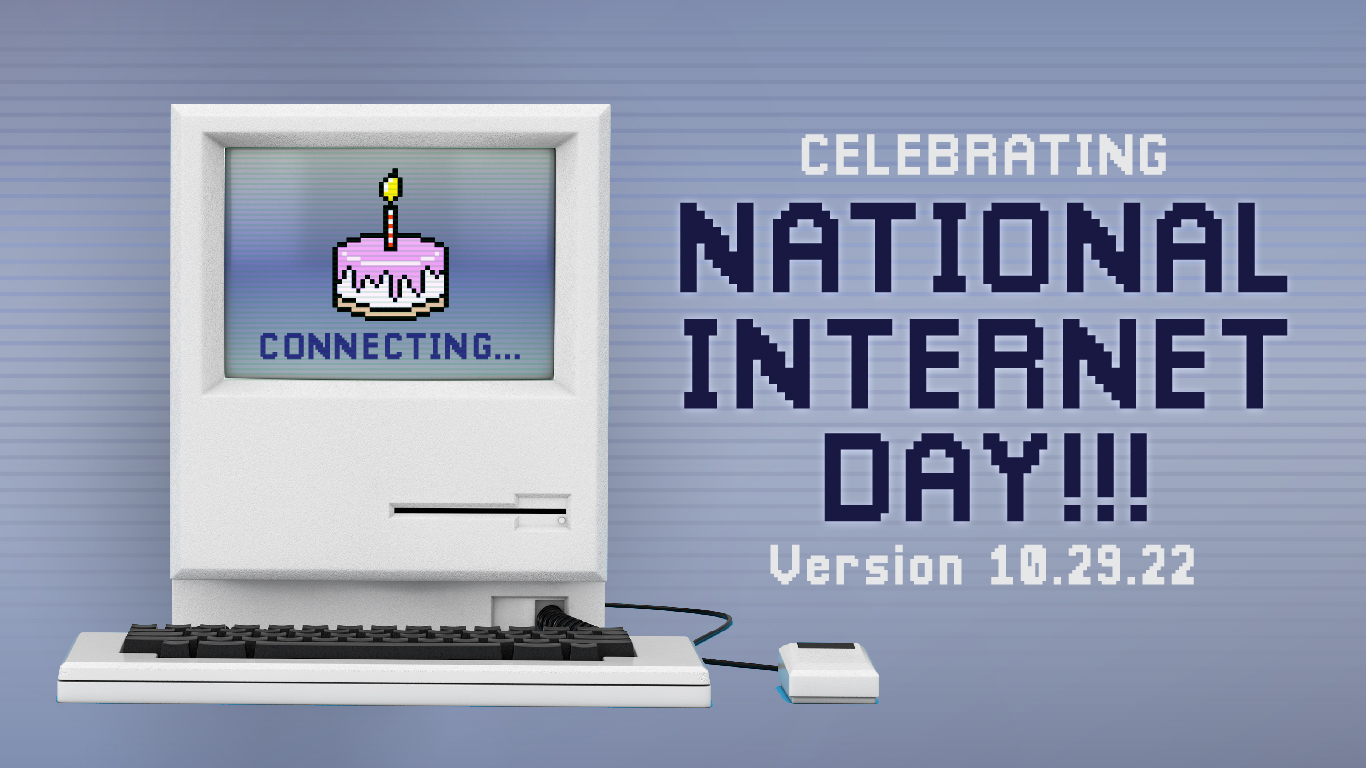 Remember that time before the Internet? Me neither! But what our parents say is true! On October 28, 1969, our only options for contacting each other were by phone, letter, or perhaps telegram, but one day later the first message was sent via the Internet. Hilariously, the message was “LO” because the network crashed before “LOGIN” could be entered. But, from these humble beginnings, an entirely new information and communication ecosystem was born, where 74 trillion emails are exchanged every year and 1.5 billion websites are live and just waiting to be visited. Way to go, Internet! You’re 53 years young today.
Remember that time before the Internet? Me neither! But what our parents say is true! On October 28, 1969, our only options for contacting each other were by phone, letter, or perhaps telegram, but one day later the first message was sent via the Internet. Hilariously, the message was “LO” because the network crashed before “LOGIN” could be entered. But, from these humble beginnings, an entirely new information and communication ecosystem was born, where 74 trillion emails are exchanged every year and 1.5 billion websites are live and just waiting to be visited. Way to go, Internet! You’re 53 years young today.
October 20, 2022
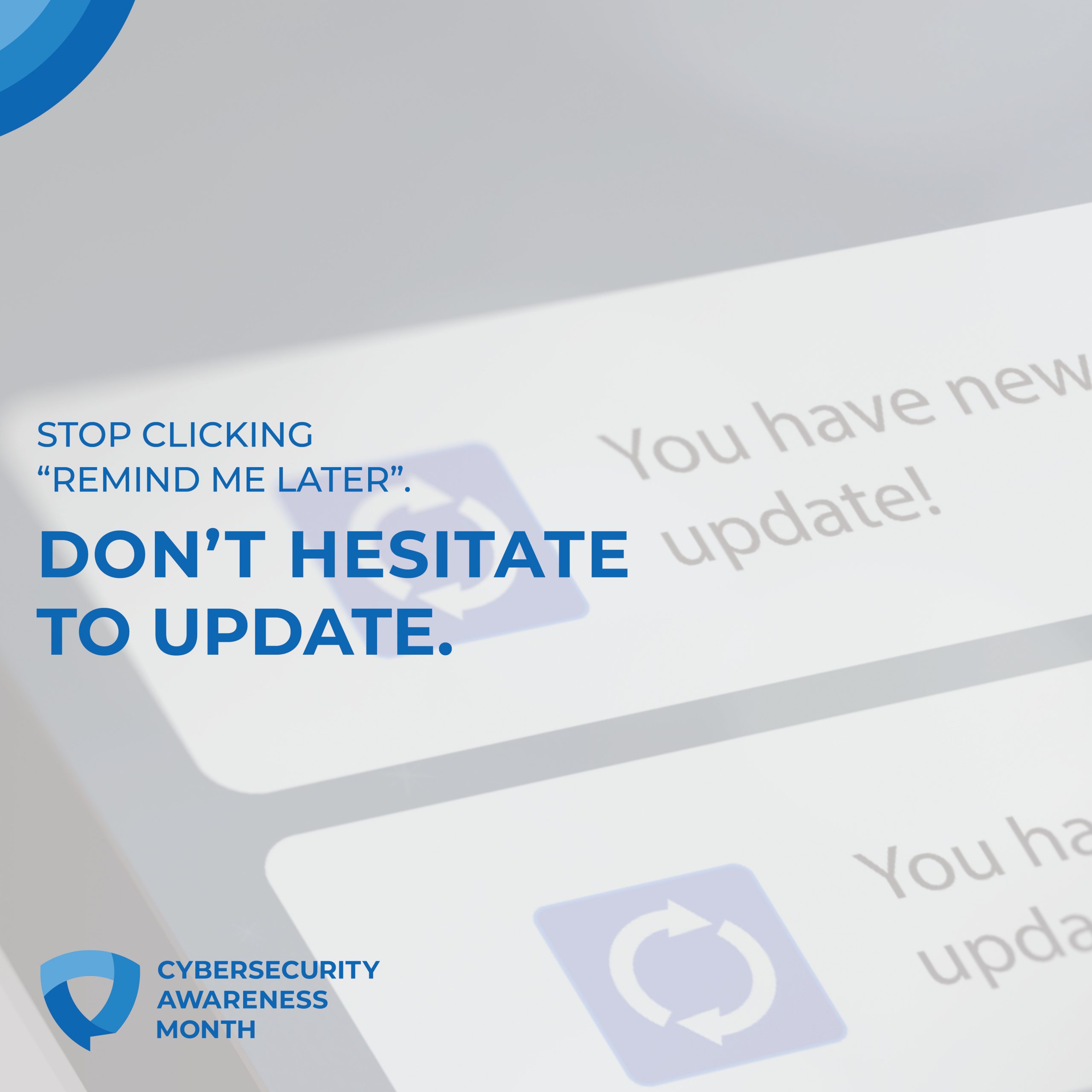 All those update alerts from your software are important to install! Not only do they fix things that might be buggy, they also patch up any security holes. #BeCyberSmart #CybersecurityAwarenssMonth
All those update alerts from your software are important to install! Not only do they fix things that might be buggy, they also patch up any security holes. #BeCyberSmart #CybersecurityAwarenssMonth
October 14, 2022
 Wouldn’t it be nice if your smartphone lasted forever? It’s got all the apps you want, your alarms and important dates are set, and you have every picture you’ve ever taken saved in your Photo Gallery. But… have you SEEN that new phone that folds in half? Must. Have.
Wouldn’t it be nice if your smartphone lasted forever? It’s got all the apps you want, your alarms and important dates are set, and you have every picture you’ve ever taken saved in your Photo Gallery. But… have you SEEN that new phone that folds in half? Must. Have.
So, now that you’ve committed to that new phone, what will become of your old friend? While you may offset the cost of a new phone, there are some other cool options to bring that paperweight back to life!
- Give it to a kid. When properly configured (and security measures put in place), old phones make great starter devices for kids. They can use them to take pictures, play games, or even Facetime with grandparents (if you still have WiFi connected).
- Up your home security game. Download a security camera app like Alfred on both your old and new phones and set the old phone up as a camera. You can use this camera as a baby monitor, at an entrance or exit to your home, or anywhere requiring additional security.
- Go play. Lots of games do not require Internet connection, so you can use your old phone to kill some time while you wait for dinner to cook or while standing in line at the store.
- Set an alarm. Most experts recommend disconnecting from all devices for at least an hour before bed. How do you do that when you need your phone by the bed to serve as your alarm clock? Try plugging your every-day phone into a charger in the kitchen, and use your old smartphone to serve as your alarm clock. This eliminates the temptation to surf late at night and quiets those pesky notifications that might wake you up as well.
- Switch the channel. This is the coolest. Instead of digging through your sofa cushions for your multiple remotes (Apple TV, Fire Stick, Roku – all have their own), just download the mobile app to your old phone and it will display and operate exactly as your remote!
- Entertain yourself. While you’ll need WiFi to either download or stream content, you can use an old phone to listen to music, play an audio book, or even read books and magazines.
In some instances, it makes good financial sense to trade in an old phone for a discount on a new one, but if you have the choice, there are some great reasons to hold on to it!
October 6, 2022
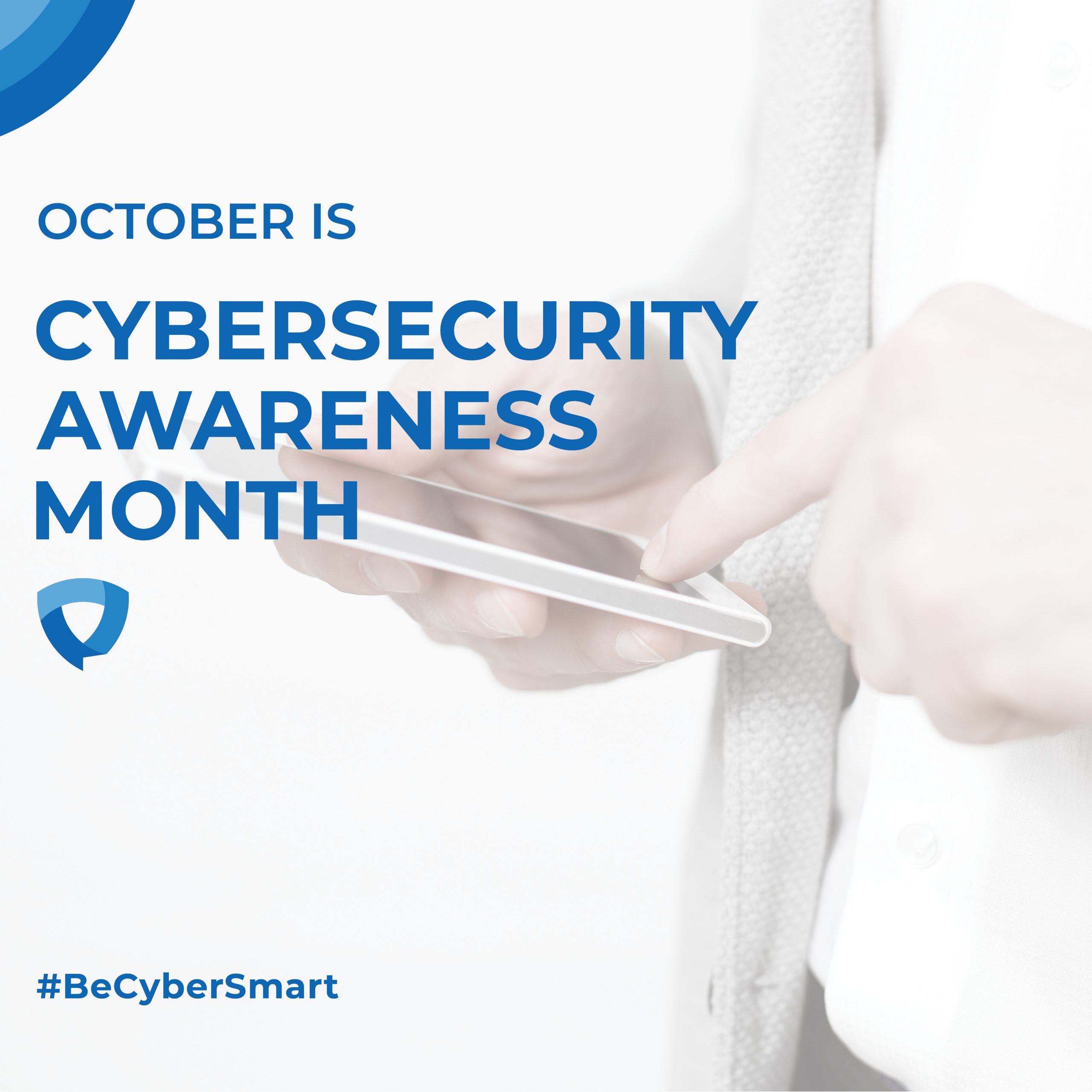 It’s our favorite month! October is #CybersecurityAwarenessMonth. Remember, it’s easy to stay safe online. With just a few clicks, you can be on your way to keeping yourself safe: https://staysafeonline.org/cybersecurity-awareness-month/
It’s our favorite month! October is #CybersecurityAwarenessMonth. Remember, it’s easy to stay safe online. With just a few clicks, you can be on your way to keeping yourself safe: https://staysafeonline.org/cybersecurity-awareness-month/
September 29, 2022
 You do everything right. You never open sinister emails. You don’t click on unsolicited links. You hold your passwords tight and change them often. So, what happens when a company with whom you do business gets hacked? It’s happening more and more, and the two most recent victims were Uber and American Airlines.
You do everything right. You never open sinister emails. You don’t click on unsolicited links. You hold your passwords tight and change them often. So, what happens when a company with whom you do business gets hacked? It’s happening more and more, and the two most recent victims were Uber and American Airlines.
In Uber’s case, a teenaged hacker used social engineering tactics to convince an Uber employee to provide multi-factor authentication information to bypass security measures. Once inside, the hacker infected the system with malware, downloaded “personal information” (though the company didn’t specify what kind), and put the information up for sale to the highest bidder. With American Airlines, employee email accounts were breached, releasing some customer and employee information including dates of birth, passport numbers, and even some medical information.
In both cases, customer information was put at risk not by customer action or inaction, but by the companies they entrusted with their information. Consider how often you use a credit card online to make a purchase. How often you enter your mother’s maiden name or even upload medical information to what you imagine is a secure portal. You’re trusting that the website with which you’re interacting is secure – but it isn’t always.
While companies are taking cybersecurity more seriously and investing in security measures, these types of attacks are all but inevitable. As always, you can mitigate risk yourself in a few different ways:
- Only buy from secure sites. Remember to check for the “Https” in a web address.
- Consider using an insured payment service like PayPal instead of a credit card.
- Use a mobile wallet like Apple or Google wallet.
- Avoid entering sensitive information (personal, financial, and medical) online unless you absolutely must.
And, if a vendor or company does happen to be hacked (and they make the hack public), you aren’t totally powerless.
- If you have a credit card on file with the company, cancel the card immediately, call your bank to notify them, and request a new card. When you receive it, be sure to select a new PIN.
- Change not only the password but any security questions associated as well.
- Be wary of emails from the company. Hackers may use the list of email addresses they’ve acquired to message potential victims, pretending to be the trusted company. Check the return address and never click a link you don’t trust.
Unfortunately, with all the great and useful strides we’ve made in technology comes people who want to take advantage of vulnerabilities and hurt people in the process. Nobody (or company!) is perfect, but a little preparation and a panic-free response can certainly minimize the damage of a hack.
September 16, 2022
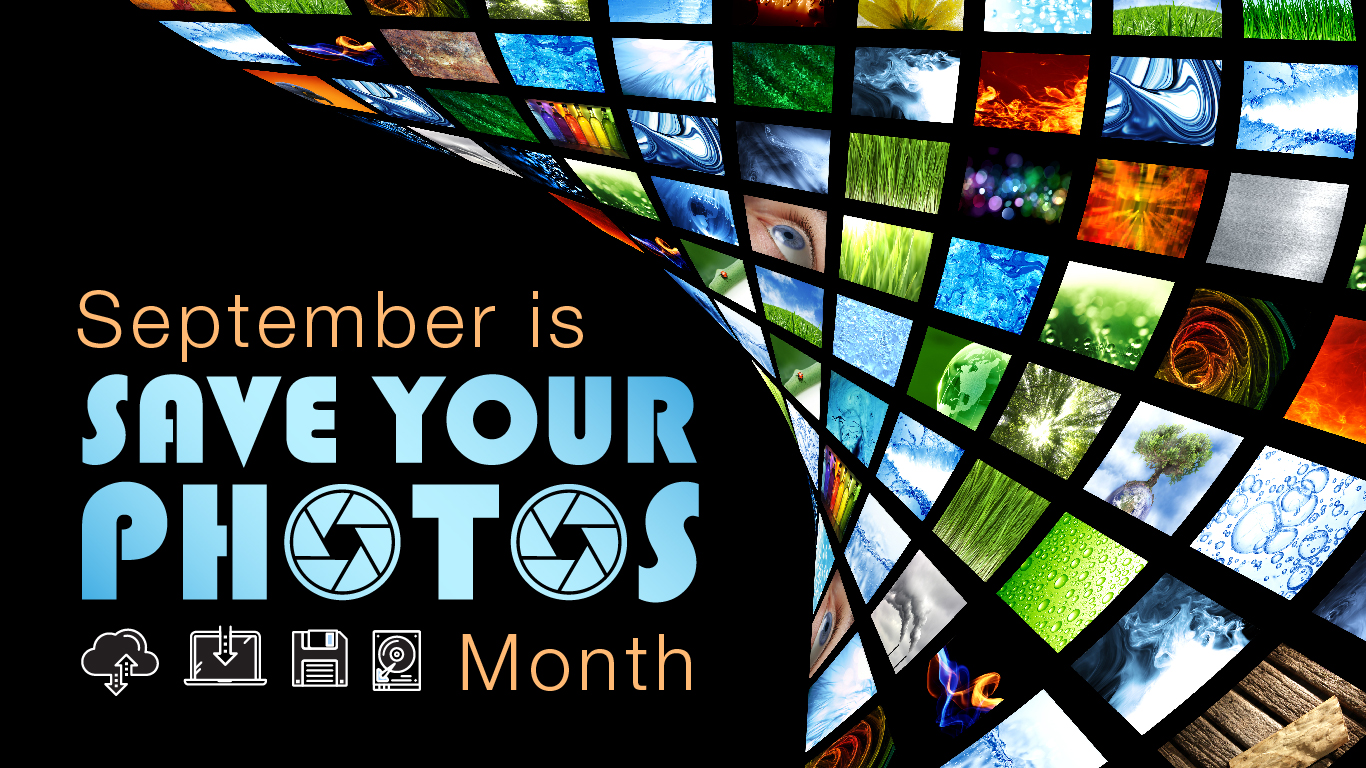 Your wedding. The birth of your child. A graduation. A bon voyage party. Or just a series of you and your best friend making silly faces. These are memories you’ll never forget – partially because you have a phone full of incredible photos to remind you! In honor of Save Your Photos Month, give yourself the gift of memories by backing up your images. Make a habit of deleting photos you don’t want (from your gallery as well as those attached to texts) to save storage, and use your Settings to schedule regular backups to the cloud. Most phone services come with tons of free space, but if you need extra, Google, Apple, Microsoft, and Dropbox all have secure storage and sharing options available for just a few bucks a month.
Your wedding. The birth of your child. A graduation. A bon voyage party. Or just a series of you and your best friend making silly faces. These are memories you’ll never forget – partially because you have a phone full of incredible photos to remind you! In honor of Save Your Photos Month, give yourself the gift of memories by backing up your images. Make a habit of deleting photos you don’t want (from your gallery as well as those attached to texts) to save storage, and use your Settings to schedule regular backups to the cloud. Most phone services come with tons of free space, but if you need extra, Google, Apple, Microsoft, and Dropbox all have secure storage and sharing options available for just a few bucks a month.
August 26, 2022
 Yes, virtual reality is cool! Yes, it’s fun to put on the goggles and step into a fantasy world. But as the technologies that power virtual reality continue to evolve, the opportunities to apply this innovation in new and creative ways grow. Here’s how to apply VR to your work and daily life:
Yes, virtual reality is cool! Yes, it’s fun to put on the goggles and step into a fantasy world. But as the technologies that power virtual reality continue to evolve, the opportunities to apply this innovation in new and creative ways grow. Here’s how to apply VR to your work and daily life:
- Healthcare – VR is being used to help both doctors and patients. Doctors can use VR to train with new technologies or surgical procedures before attempting them in a real operating room, and patients have found relief from physical pain and mental illness using VR applications and exercises.
- Retail – Imagine being able to try on a fitting room full of clothing without ever leaving your home! A number of fashion designers are working with software developers to create VR experiences that let customers shop, try on clothes, and select sizes before ordering exactly what they want.
- Travel and Tourism – COVID lockdown was devastating for travel, but a boon to VR applications like Thomas Cook’s “Try Before You Fly” VR experience where people could walk through international cities, museums, and landmarks. And, now that people are travelling again, many of the destinations people visited in virtual reality are becoming destinations for real travel again.
- Training – With the explosion of remote work, sometimes people need help from colleagues hundreds of miles away. Now, subject matter experts can walk employees through complicated procedures, manipulate equipment, or step through virtual documents until even the most complex questions have been answered. And, critically, people who learn by doing are able to complete desired tasks, supervised by someone who can call out missteps, with no risk.
- Real Estate – With the housing market tighter than ever, buyers are having to make snap decisions, often making offers sight-unseen. Now, users can walk through the front door of their dream house, check out the pantry, throw open the French doors to the backyard, and (almost literally) feel the grass between their toes without ever leaving their own home.
It’s a bold new world with innovations and opportunities changing how we live, work, learn, and play. Next time you have the chance, “borrow” your kid’s VR goggles and tell them you’ve got important work to do!
August 19, 2022
 Following a year of intensifying cyberattacks on small businesses and government agencies, experts across a number of sectors got together to figure out strategies for defending against such attacks. The trend of targeting smaller businesses (which are likely to have fewer resources to defend themselves) continued into 2021 with companies of 500 employers or fewer accounting for 70% of all attacks. With these businesses held at a standstill and millions of dollars changing hands to unlock systems and return documents, something had to be done.
Following a year of intensifying cyberattacks on small businesses and government agencies, experts across a number of sectors got together to figure out strategies for defending against such attacks. The trend of targeting smaller businesses (which are likely to have fewer resources to defend themselves) continued into 2021 with companies of 500 employers or fewer accounting for 70% of all attacks. With these businesses held at a standstill and millions of dollars changing hands to unlock systems and return documents, something had to be done.
A Ransomware Task Force of experts developed a Ransomware Blueprint which provides specific actions businesses can use to defense themselves and keep their businesses up and running. Recommendations include:
- Know your network. Keep a registry of software, hardware, and data you’ve saved to the cloud. Pay particular attention to sensitive data including customer personal data and financials.
- Restrict permissions. The more people with access, the more opportunities for security lapses, so restrict admin permissions to your network to a limited few.
- Train train train. Make online security a priority and a team responsibility. Provide regular training to remind employees of how they can (and must) support network security in the workplace.
- Update your anti-malware software. Most ransomware attacks start with malicious email attachments or web browsers, so make sure your anti-malware software is patched and up to date.
- Implement multifactor authentication.Even though it’s tedious for the user, setting up multifactor authentication is critical to verifying your employees’ identity and stopping attacks.
- Back up your data. In the event that an attacker gets in, they can’t hold your content for ransom if you have copies elsewhere. So, regularly back up your data, encrypt that data, and store it somewhere other than on the cloud.
One final piece of advice from the Ransomware Taskforce is to consider a cyber insurance policy. Diligent cyber attackers may still get in – despite your best efforts – and the costs to unlock files, manage downtime, hire incident response pros, and repair any damage will escalate quickly. Insurance may not be able to get back all your data, but it can help mitigate the costs of the attack.
July 29, 2022
 The next time you get an unsolicited message from a helpful-sounding tech support representative offering to pinpoint your network weaknesses, run – don’t walk. A new gang of North Korean cybercriminals known as HolyGhost has been attacking schools, small manufacturers, and events companies, shutting down their networks or holding their data ransom.
The next time you get an unsolicited message from a helpful-sounding tech support representative offering to pinpoint your network weaknesses, run – don’t walk. A new gang of North Korean cybercriminals known as HolyGhost has been attacking schools, small manufacturers, and events companies, shutting down their networks or holding their data ransom.
Until now, HolyGhost has been seen mostly as a nuisance because its ransoms have been relatively small (less than 2 Bitcoins or up to $100k) and these smaller enterprises simply pay the ransom rather than losing their data or having it exposed publicly. But, as is the case with most criminals like this, they will continue to operate, and more brazenly, until they are caught. Now is a good time to check your security protocols to make sure you don’t fall victim to HolyGhost (or a group like them):
- Don’t be a two-time victim. HolyGhost has a reputation for attacking their victims again – perhaps assuming no one thinks they’ll be attacked twice. If you end up paying the ransom, tighten up your security ASAP.
- Seek out help if you need it. Never accept help from or let down your defense to unknown sources. Research some specialists yourself and reach out with questions.
- Keep an eye on the news. Because ransomware gangs are often working, even if informally, in conjunction with the North Korean government, attacks are more likely to come following implementation of sanctions. The logic goes that if North Korea can’t make money through normal commerce channels, they’ll seek out gangs like HolyGhost to help restock the coffers.
- Never download “encryption tools” or click on links from unknown sources. One of HolyGhost’s moves is to send a message saying they are here to help decrypt your files and that using any other service may damage your files. Don’t click anything or download anything. Contact your network security immediately.
As always, your best defense is a proactive posture. Make sure your ransomware is up to date and ensure your family, colleagues, and employees know what to do if they are contacted by HolyGhost or groups like them. Bad guys are inevitable but the damage they can do is not!
July 8, 2022
 First, there was the chisel on the cave wall. Then, the pen and sticky note. And now this! The next great technology for taking, storing, and organizing notes is here and it’s the coolest new gadget you didn’t know you needed. Introducing… the digital notebook!
First, there was the chisel on the cave wall. Then, the pen and sticky note. And now this! The next great technology for taking, storing, and organizing notes is here and it’s the coolest new gadget you didn’t know you needed. Introducing… the digital notebook!
June 24, 2022
 We all know at this point (or should) that if a Nigerian prince contacts us regarding the millions of dollars he will deposit into our account, we should not send him our bank information. But hackers and scammers have gotten more subtle, developing personalized scams that seem much more legitimate. The FBI has identified one such scam and is getting the word out to ensure you aren’t the next victim.
We all know at this point (or should) that if a Nigerian prince contacts us regarding the millions of dollars he will deposit into our account, we should not send him our bank information. But hackers and scammers have gotten more subtle, developing personalized scams that seem much more legitimate. The FBI has identified one such scam and is getting the word out to ensure you aren’t the next victim.
The Platform – Scammers use social media like Facebook, Instagram, and Twitter to create realistic looking profiles and reach out to unsuspecting users with “investment opportunities.” They contact users directly using messaging apps, sometimes even using profiles stolen from the victim’s friends – so the contact seems legitimate.
The Con – Scammers describe a money-making opportunity in which the victim will send a little bit of money that will grow exponentially with no risk or interest. If they comply, the scammer may cease contact (if they got enough) or they will send a fake Cash App screenshot “proving” how the money is growing in order to coerce even more money from the victim.
The Cycle – Once money has changed hands, the scammer may suggest that funds are pending until the victim replaces his email address with one provided by the scammer. Once that is done, the scammer need only change the password on the Cash App account to have complete control of the funds. Now that the email matches the victim’s social media profile, the scammer can attack the victim’s friends (who see their friend’s name and, thus, are more likely to believe the offer).
The Counter – As always, the best defense against this kind of attack is to just never send money electronically to someone you don’t know. If the offer seems genuine, contact your friend via phone to confirm it’s really them you’re talking to. Beyond that, take these steps to bolster your online defenses:
- Confirm the identity of anyone reaching out with an unusual request (especially ones having to deal with money). If you can’t, block them.
- Don’t click any links or download any attachments until you’ve confirmed the sender’s ID.
- Don’t change your profile information to suit someone else’s request. Someone asking you to change your username or password should set alarm bells ringing.
- Use multi-factor authentication to secure your account. It’s a pain to have to enter a password AND the code texted to you, but it could save you money and stress.
- Log out of apps when you’re done using them. Staying logged in all day and night is the online equivalent of an unlocked door to an open safe.
Times are tough for a lot of people these days, so the offer of a quick return on investment may be very tempting. There certainly are opportunities out there, but if your gut tells you that this is too good to be true, it probably is.
May 19, 2022
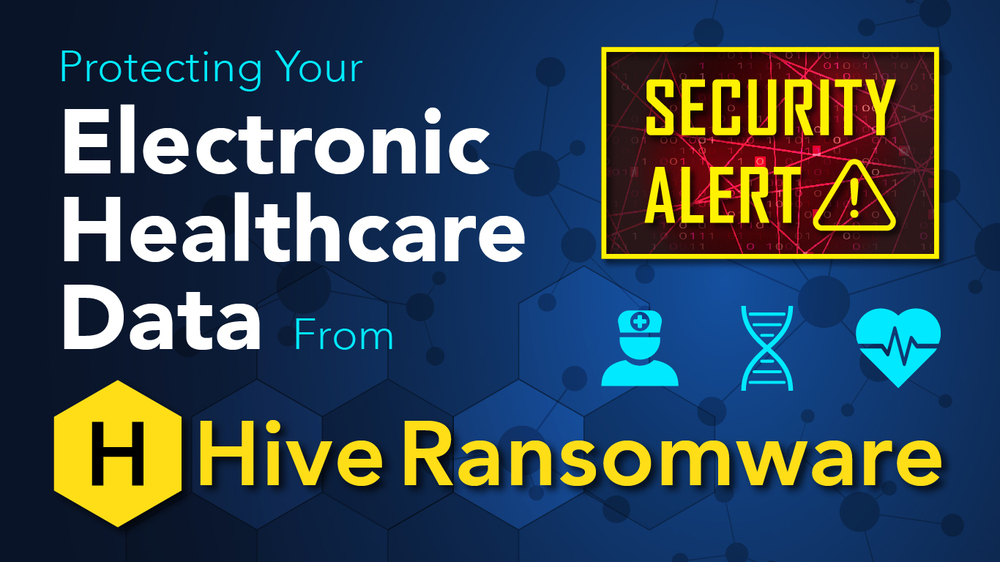 The last decade has seen some incredible advances in healthcare, owed largely to the ability to diagnosis, treat, and track disease and illnesses virtually. We can Dial-a-Doc to Zoom with our primary care doctors, mail away our samples, and have prescriptions e-mailed to our pharmacy, all because our records, test results, and medications are housed online.
The last decade has seen some incredible advances in healthcare, owed largely to the ability to diagnosis, treat, and track disease and illnesses virtually. We can Dial-a-Doc to Zoom with our primary care doctors, mail away our samples, and have prescriptions e-mailed to our pharmacy, all because our records, test results, and medications are housed online.
But with these momentous steps forward come potential risks to our privacy and data integrity. Most recently, a ransomware group of hackers known as the Hive has set its sights on the United States’ healthcare sector. The Hive uses traditional ransomware tactics like phishing, phone calls, and the exploitation of remote networks and even VPNs to steal data from people at their most vulnerable. Worse still, they preempt users’ best practices by deleting shadow copies, back-up files, and system snapshots so that when documents and personally identifiable information (PII) is stolen, they have no back-ups available. At that point, patients and healthcare groups feel there is no alternative but to pay a ransom.
The Health Sector Cybersecurity Coordination Center (HC3) says that healthcare organizations and individuals do have some tools in their arsenal to defend against such attacks:
- Supercharge your passwords. Choose strong, difficult-to-guess passwords and strengthen them further by requiring two-factor authentication.
- Monitor and fortify VPNs. With so much remote work, VPNs help employees remote into an office network, but it’s not a perfectly secure solution. Healthcare companies should consider hiring an accountable third-party VPN management system, and individuals should tighten up their VPN security by setting strong passwords, enabling a network lock, and setting up a kill switch.
- Adhere to the 3-2-1 HC3 recommends backing up data in threedifferent locations, on at least two forms of media, with one stored offline.
The old adage goes that you’re nothing without your health. Make sure that while you’re taking good care of your health, you’re also taking good care of your online healthcare footprint!
May 13, 2022
 Remember the good old days when you could leave your back porch door unlocked? Then, one day you added a simple lock. And today, you’ve got a deadbolt and a Ring to monitor your stoop from anywhere! Keeping up with patches and software updates is the virtual equivalent to bolstering your home security as new safety measures come to market.
Remember the good old days when you could leave your back porch door unlocked? Then, one day you added a simple lock. And today, you’ve got a deadbolt and a Ring to monitor your stoop from anywhere! Keeping up with patches and software updates is the virtual equivalent to bolstering your home security as new safety measures come to market.
May 5, 2022
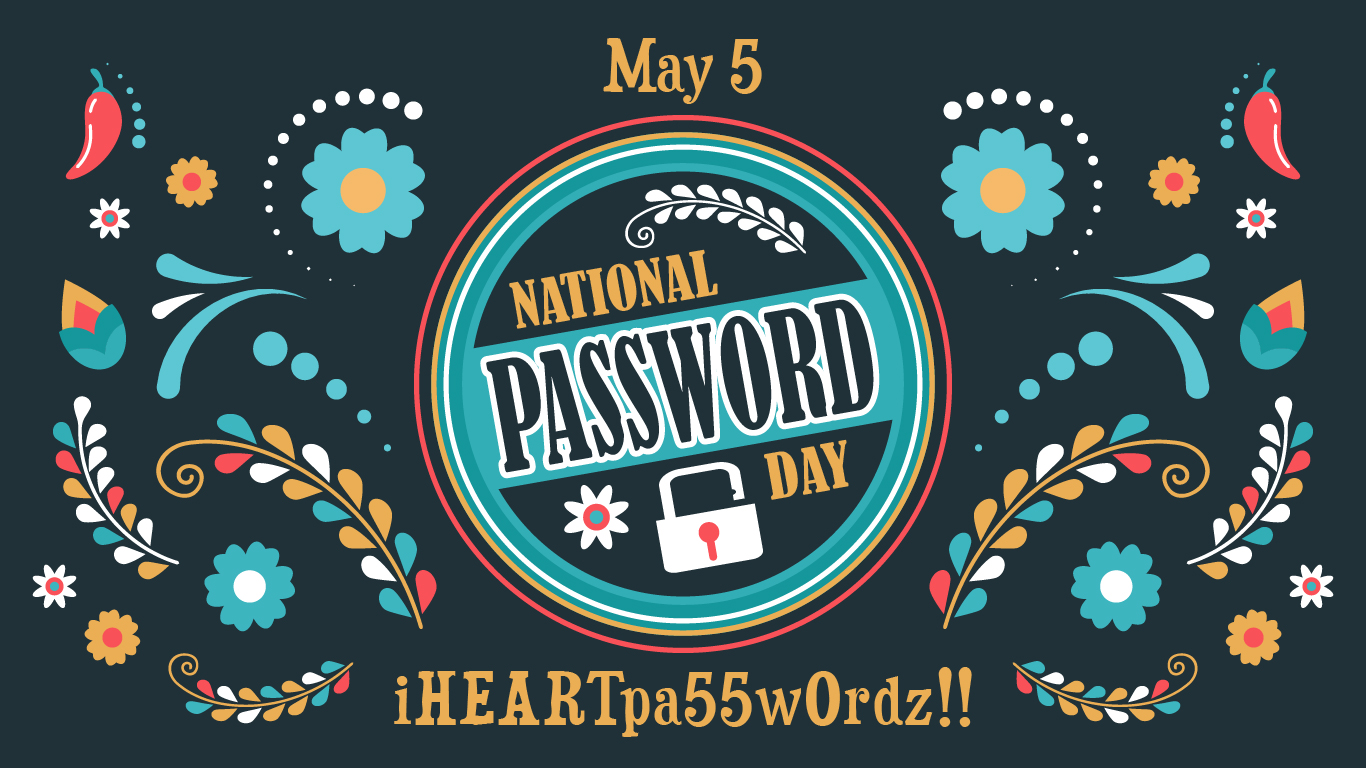 Whoever put National Password Day on Cinco de Mayo was a genius! Just in time for you to head out for margaritas and merrymaking (and potentially losing your phone), you can make sure your smartphone and your laptop are secure. Remember to update your passwords regularly with difficult-to-guess passwords. Try to use both upper- and lower-case letters, digits, and special characters. And make layered changes to already tough-to-remember passwords. For example, if you really want “Ilovemytwolabs” as your password, try this layered alternative: iHEARTmy2lAb$!! Or download and use a password manager to create (and remember) unique and complex passwords for you. This May 5th, may your passwords be hard, and your pinata be soft!
Whoever put National Password Day on Cinco de Mayo was a genius! Just in time for you to head out for margaritas and merrymaking (and potentially losing your phone), you can make sure your smartphone and your laptop are secure. Remember to update your passwords regularly with difficult-to-guess passwords. Try to use both upper- and lower-case letters, digits, and special characters. And make layered changes to already tough-to-remember passwords. For example, if you really want “Ilovemytwolabs” as your password, try this layered alternative: iHEARTmy2lAb$!! Or download and use a password manager to create (and remember) unique and complex passwords for you. This May 5th, may your passwords be hard, and your pinata be soft!
April 29, 2022
 Hackers strike again! This time, mobile giant T-Mobile was attacked by the cybercrime gang Lapsus$ in a brazen theft of company source code. While the company has assured the public that no personal information belonging to their customers has been compromised, they did confirm that Lapsus$ stole credentials that allowed them access to T-Mobile’s “house operational tools software.”
Hackers strike again! This time, mobile giant T-Mobile was attacked by the cybercrime gang Lapsus$ in a brazen theft of company source code. While the company has assured the public that no personal information belonging to their customers has been compromised, they did confirm that Lapsus$ stole credentials that allowed them access to T-Mobile’s “house operational tools software.”
This is the second time in as many years that T-Mobile was targeted, but whereas the last breach resulted in millions of names, birthdays, and Social Security information being stolen, this time the hackers were shut down before they could do real damage. Company officials stated that their “systems and processes worked as designed” and “the intrusion was rapidly shut down and closed off, and the compromised credentials used were rendered obsolete.”
This hack represents a terrific example of how it’s critical for companies who hold valuable data (and personal customer information) to be proactive, rather than reactive, with their cybersecurity. Installing malware blockers, ensuring software patches are up to date, securing networks, tightening up endpoint security, and wiping old hardware before destroying it are all critical steps toward protecting company data and customer information. Likewise, training employees on data protection and communicating regularly with customers about remaining vigilant against possible phishing or other attacks is a great way to ensure everyone is invested in protecting data.
Scarily enough, this hack was conducted by a handful of Lapsus$-affiliated teenagers in London. They were arrested soon after the attack, but officials believe that Lapsus$ is a growing threat (among so many) and companies (and individuals) should stay on their toes.
April 22, 2022
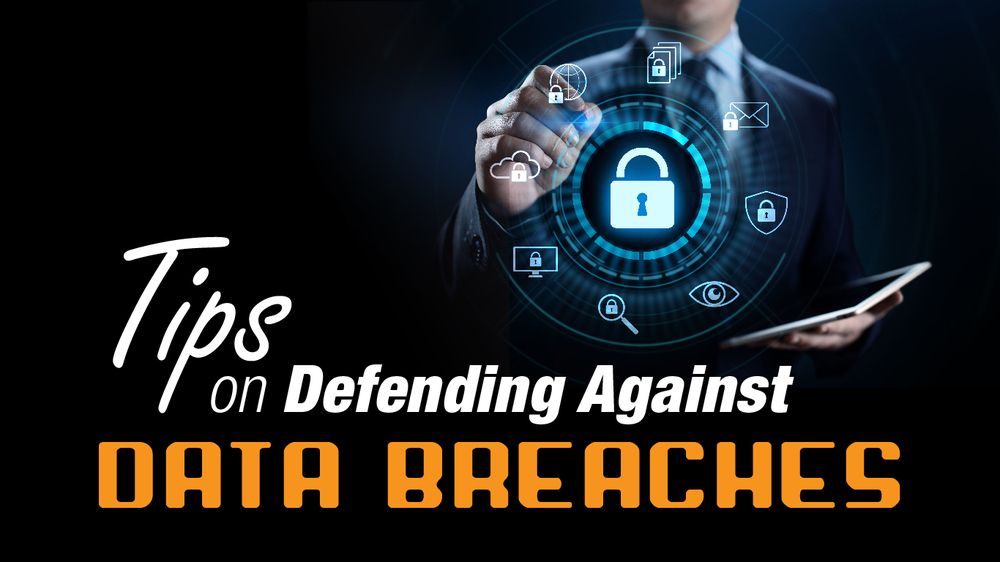 Between 2013 and 2016, Russian-backed hackers initiated cyberattacks on Yahoo that resulted in the compromise of – wait for it – 3 billion users. The attack began as an FSB assault on several banks and high-ranking international businesspeople, but the simple spear-phishing emails they sent ultimately gave them access to every Yahoo user’s information, including names, phone numbers, and even password recovery details.
Between 2013 and 2016, Russian-backed hackers initiated cyberattacks on Yahoo that resulted in the compromise of – wait for it – 3 billion users. The attack began as an FSB assault on several banks and high-ranking international businesspeople, but the simple spear-phishing emails they sent ultimately gave them access to every Yahoo user’s information, including names, phone numbers, and even password recovery details.April 7, 2022
 Stop. Put your phone down (just for a second) and think about this: According to EndDD.org, the average text takes 4 seconds to send, so if you’re going 55 mph, you will travel the length of a football field before you look up from your phone. Imagine the damage that can be done in those 4 seconds…
Stop. Put your phone down (just for a second) and think about this: According to EndDD.org, the average text takes 4 seconds to send, so if you’re going 55 mph, you will travel the length of a football field before you look up from your phone. Imagine the damage that can be done in those 4 seconds…April is Distracted Driving Awareness Month, and organizations like EndDD are helping families, teen drivers, and even employers learn safe driving habits and bring an end to distracted driving. Research shows that drivers are distracted by their phones up to 10 percent of the time they spend behind the wheel, but other distractions abound as well.
Here are a few ways you can bring some focus back to your driving (and maybe save a life in the process!):
• Put the phone away. Don’t just put it down, put it in your purse or glove compartment where you aren’t tempted. If you really feel like you might miss something, make a habit of setting automatic replies to texts saying you’re driving and will call back.
• Eat first, drive second. We’re all on the go these days so fast food is sometimes a necessity but eating while you drive can be messy and distracting. Take five minutes to eat before getting back on the road.
• Groom before you go. We’ve all seen the lady curling her eyelashes while driving or the guy using his electric shaver in the mirror. Try setting your alarm for 10 minutes earlier to get all your hair and makeup done in the bathroom mirror. (The lighting is better there anyway.)
• Be a good role model. Kids are always watching so make sure you set a good example. Make a point of putting your phone away and enjoying a few minutes to eat together rather than eating in the car. Telling your teen driver how to avoid distracted driving is good – showing them is even better.
March 11, 2022
 Now that the pandemic appears to have entered a less severe phase, lots of people are headed back into their offices, but many have embraced the work-from-home lifestyle and are never going back. If you are one of the millions who is living the pajama revolution, it’s time to take your makeshift “office” under the stairs/in the garage/at the dining table to the next level.
Now that the pandemic appears to have entered a less severe phase, lots of people are headed back into their offices, but many have embraced the work-from-home lifestyle and are never going back. If you are one of the millions who is living the pajama revolution, it’s time to take your makeshift “office” under the stairs/in the garage/at the dining table to the next level.
Get comfortable (ergonomically speaking) – Short-term, posting up at the kitchen table is fine, but if you’re committed to long-term WFH, you’ll need a good chair and a table or desk set to the proper height. Try to find an adjustable chair with good lumbar support and try it out in the store rather than buying on-line. Likewise, find an adjustable desk (or a standing desk!) where your forearms are parallel to the ground and your wrists aren’t bent while typing or using your mouse.
Lighten up – A bright monitor in a dark room is a recipe for eye strain and headaches. Give yourself some good overhead lighting, pull a translucent shade over windows (to get some natural light without the glare), and ensure your monitor’s brightness is set to slightly brighter than the light in the room.
Stay connected – Make sure both your equipment and your internet service support your needs. WiFi is convenient but if fool-proof connectivity is a must (during Zoom calls, for example) you may want to hardwire in using an ethernet cord. Talk to us about the number of devices and type of communications you need and we’ll help ensure that you are on an internet plan with the speed to accommodate your needs.
Back it up – When working on a company network, we take for granted the security and storage provided. When you’re on your own, make sure to keep your anti-virus software up to date and do regular back-ups of your files.
Get up and get moving – With no trips to the watercooler or the cafeteria, it’s easy to get sucked into work and forget to take breaks. Consider setting a timer or getting an app that reminds you to stand (at least) once an hour. Stretch, roll your neck, bend at the hips and do a few “good mornings” to keep your back and hips loose, and get out for a few laps around the block at lunch. Work is important, but so is fresh air and staying connected to your neighbors!
If working from home really is your long-term strategy, create a space that is comfortable and supports your focus and creativity.
March 4, 2022
 While we’re familiar with the names of famous women in science and technology like Curie, Goodall, and Johnson, you’ll never look at a computer the same after you meet Ada Lovelace. Ada was born in 1815 to Lord and Lady Byron. Not wanting her daughter to ruin her brain with fanciful poetry (like her father!), Lady Byron set out to rein Ada in with math. Instead, Ada combined her imagination and love of figures to become one of the great mathematical minds of her age. Eventually, her work on the Analytical Engine – the world’s first digital computer complete with processor memory, and all basic functions of today’s machines – led her to be known as the first computer programmer.
While we’re familiar with the names of famous women in science and technology like Curie, Goodall, and Johnson, you’ll never look at a computer the same after you meet Ada Lovelace. Ada was born in 1815 to Lord and Lady Byron. Not wanting her daughter to ruin her brain with fanciful poetry (like her father!), Lady Byron set out to rein Ada in with math. Instead, Ada combined her imagination and love of figures to become one of the great mathematical minds of her age. Eventually, her work on the Analytical Engine – the world’s first digital computer complete with processor memory, and all basic functions of today’s machines – led her to be known as the first computer programmer.
March 2, 2022
Malwarebytes has uncovered a phishing scam targeting Microsoft account holders. The phishing email exploits tension over the Russian invasion of Ukraine to trick recipients into thinking their account has been hacked, when in fact the email itself is the first step in an attempted scam. Hackers will take every opportunity to lure in unsuspecting citizens. Please be cautious and verify the validity of any suspicious emails like those described here. You can read the Malwarebytes story by clicking this link: https://blog.malwarebytes.com/scams/2022/03/unusual-sign-in-activity-mail-goes-phishing-for-microsoft-account-holders/
February 25, 2022
 The Russian aggression toward Ukraine may seem too far away to have any effect on everyday Americans, but the FBI’s Cyber Division released a report this week saying we should all be on our toes. Historically, when Russia faces adversity (in this case, sanctions and international condemnation) their first inclination is to launch cyberattacks.
The Russian aggression toward Ukraine may seem too far away to have any effect on everyday Americans, but the FBI’s Cyber Division released a report this week saying we should all be on our toes. Historically, when Russia faces adversity (in this case, sanctions and international condemnation) their first inclination is to launch cyberattacks.
Experts say that the Russians are likely to rely on go-to tactics like spear-phishing and brute force attacks and more covert attacks using social media to amplify disinformation and make sharing of those false facts as easy as clicking Share.
Here’s how to tighten up your security to avoid being a victim of a Russian attack:
- Update your passwords– The best way to avoid a brute force attack is to make your passwords tough to guess and different from your passwords on other sites. If you are able to implement multi-factor authentication, do that.
- Update your antivirus software – We always say it, and we always mean it! This is a simple and cheap way to keep hackers at bay – but only if your solutions are current and patched.
- Don’t “Click here”– If you receive an email (or a text) from an unknown source asking you to click a link or download a file for more information, don’t. These spearfishing expeditions often look like they come from legitimate sources, so be wary; hover over links and email addresses to see where they are really coming from, and in most cases, just delete the message (and notify your security officer if on a work machine).
- Have a backup plan– Hackers are likely to target critical infrastructure like healthcare, telecommunications, transit, and energy so try to think a few steps ahead. Back up your medical records to the cloud and make sure you’re stocked up on prescriptions. Keep at least a half a tank of gas in your car at all times.
- Keep your eyes open on social media – Research stories (especially ones with an obvious bias) before sharing them through social media. Often, these stories are made up out of thin air and have no purpose other than to ramp up tensions and increase division among populations.
February 18, 2022
I Love Emojis
 We’re all pretty solid with inserting emojis into our text messages because our phones make choosing one of these cute/scary/funny/thoughtful icons a one-click effort. But have you ever been writing a document or an email and thought, “No word can express my feelings right now like a graphic of a dumpster on fire or an octopus holding a heart?” Or do your business documents require special characters like degrees or foreign currencies?
We’re all pretty solid with inserting emojis into our text messages because our phones make choosing one of these cute/scary/funny/thoughtful icons a one-click effort. But have you ever been writing a document or an email and thought, “No word can express my feelings right now like a graphic of a dumpster on fire or an octopus holding a heart?” Or do your business documents require special characters like degrees or foreign currencies?
So 
- Character Picker– Press the Windows button + the period. The Character Picker pops up and allows you to select from emojis, Kaomoji (Japanese character emojis), and symbols (like the copyright symbol, the degree symbol, and even an inverted question mark for Spanish text). There is a search window as well to help you find a specific icon.
- Character Map– Before there were emojis, there was the character map! In the Windows search window, type “charmap” and the character map appears. Scroll through or use the search window to find what you need.
- Populate your Clipboard– From the Character Map, double-click the character you want and click Copy. This adds the character to your Clipboard. Copy as many characters as you like and open the Clipboard by pressing the Windows key + V. Copy and paste your characters from there instead of having to search the entire Map again.
- Keyboard Shortcuts– When you’ve selected a symbol or character from the character map, you’ll notice a keyboard shortcut in the bottom of the dialog. For example, when you hover over the copyright symbol, the dialog says “Keystroke: Alt+0169.” If this is a symbol you use often, you can make a note so that next time you can just use the keyboard shortcut. (Note that this power move only works if you have a separate number pad.)

 .
.Data Privacy Day – January 28
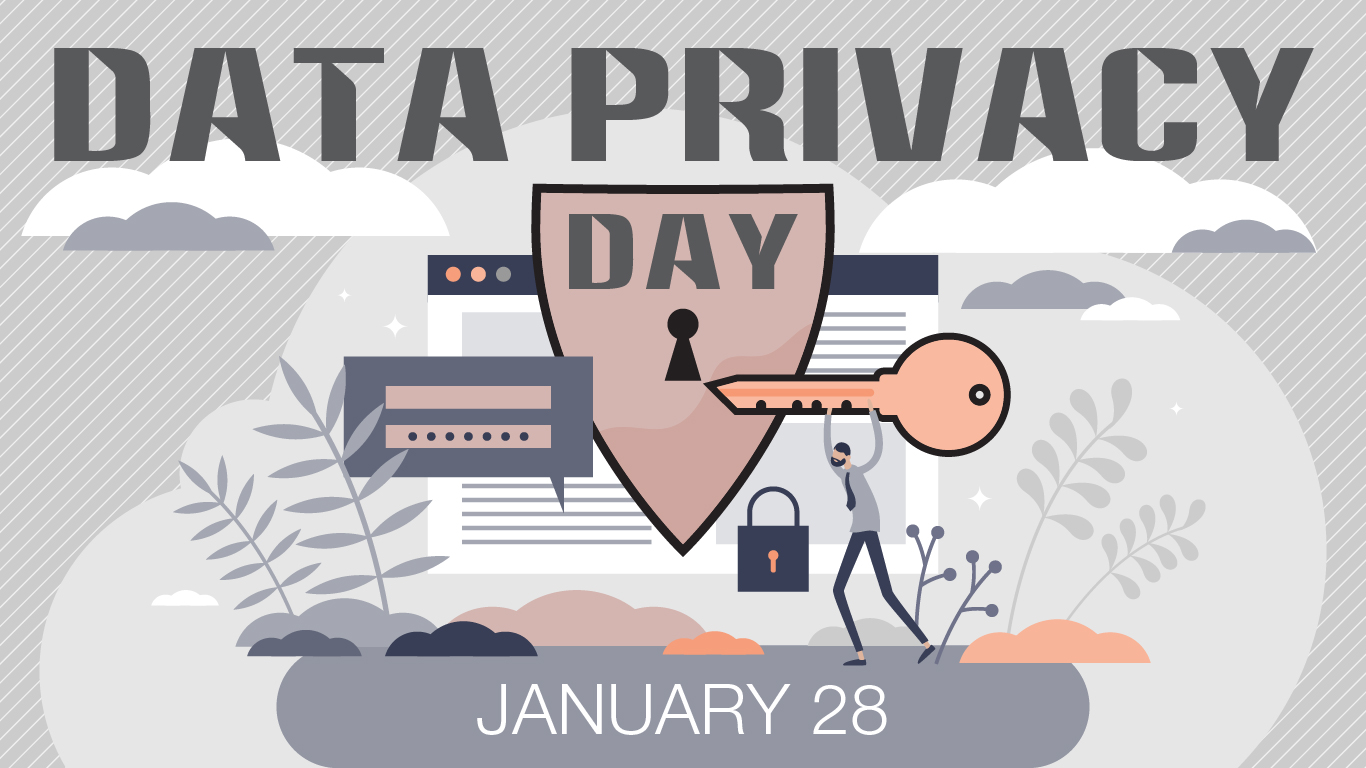 Data Privacy Day was created to encourage users worldwide to “own their own responsibilities to create a culture of privacy.” Sounds like a big task but there are a few simple ways to celebrate this day with a few tiny but mighty changes:
Data Privacy Day was created to encourage users worldwide to “own their own responsibilities to create a culture of privacy.” Sounds like a big task but there are a few simple ways to celebrate this day with a few tiny but mighty changes:Tips to be a Web Browser Power User
 You know the difference between “I’m just browsing” and “I’m on a mission,” right? Well, what power-shopping is to brick and mortar browsing, these tips are to the savvy online navigator. Make a note of these tricks and keyboard shortcuts, and you’ll turn your casual browsing into an interactive, supercharged online experience.
You know the difference between “I’m just browsing” and “I’m on a mission,” right? Well, what power-shopping is to brick and mortar browsing, these tips are to the savvy online navigator. Make a note of these tricks and keyboard shortcuts, and you’ll turn your casual browsing into an interactive, supercharged online experience.
- Clear your cache. If you’ve felt your search speeds lag lately, delete all those pesky pages, images, and cookies from your cache. Press Ctrl + Shift + R to empty your cache (but be aware that you may need to re-enter passwords on your favorite sites).
- Bounce between tabs. Do you often keep lots of tabs open at once? Instead of using your mouse to click from one to the next, use Ctrl + Tab to open the tab to the right or Ctrl + Shift + Tab to move left.
- Create a Reddit Slideshow. This is so cool. If you’ve spent any time on Reddit, you’ll know there are subreddits for everything, many including tons of photos. If you find a subreddit you like and you just want to share the photos it contains, copy the URL and add “p” after “reddit” and a slideshow is automatically created. Try www.redditp.com/r/awwfor all the cute animal photos you can stand.
- Try a Google alternative. Google is so ubiquitous that it’s made itself a verb, but there are alternatives that don’t rely on ads or track your habits the way Google does. If privacy is a concern, try DuckDuckGo or StartPage. Or, if you’re interested in using a search engine that drives interest (and funding) for social causes, try Ecosia or Ekoru (which not only donates 60% of its revenue to charities, but uses renewable energy sources for its data centers).
- Log out of secure sites. Just as you put your credit card back in your wallet after a purchase, make sure to log out of any secure site when you’re done. If you simply close the browser window, the site is still active and open to hackers.
- Sync bookmarks across devices. Don’t you hate it when the site you need (but can’t remember) is on your phone but not your laptop? If you sync your devices in Settings you won’t need to log in or enter passwords for your most-used sites and your bookmarks will be available at work, at home, or on the go.
Defending Against the Apache Log4j Hack
 It’s a new year, filled with opportunity and optimism and just being a better person. Except for hackers. They continue to wreak havoc throughout our connected world, and their new target is the logging function, Log4j. Log4j is managed by Apache Software Foundation and is an open source, Java-based logging library, which means that thousands of applications, libraries, and frameworks worldwide could be affected.
It’s a new year, filled with opportunity and optimism and just being a better person. Except for hackers. They continue to wreak havoc throughout our connected world, and their new target is the logging function, Log4j. Log4j is managed by Apache Software Foundation and is an open source, Java-based logging library, which means that thousands of applications, libraries, and frameworks worldwide could be affected.Tech Gifts That Will Dazzle and Delight
 We are just weeks away from Santa’s big day, but there’s still time to get that perfect tech for everyone on your list. And the good news is that, while some big-ticket items may be cost-prohibitive, smart shopping will help you stuff stockings with tech that will dazzle and delight.
We are just weeks away from Santa’s big day, but there’s still time to get that perfect tech for everyone on your list. And the good news is that, while some big-ticket items may be cost-prohibitive, smart shopping will help you stuff stockings with tech that will dazzle and delight.
Green gifts – Not every piece of tech must break the bank – and some can actually do good for the environment. Consider Lumi lighting that transforms traditional light plates into eco-friendly nightlights. Give your green thumb a smart garden that helps you grow vegetables and herbs inside all year long. Or snag a Little Sun Diamond, a solar-powered light that provides 5 hours of light for each charge, and for each one sold, one is delivered to a community in Africa with limited access to electricity.
Wellness wows – From electric toothbrushes to white noise machines for restful sleep to all types of wearable tech, science is here to make your new year more healthy than your last! Consider smart water bottles, a massage gun for recovery, or even the Oura Ring that tracks your heart rate, sleep patterns, and overall health – all while looking like a cool, sleek ring.
Cooking tech – Think you (or someone you love ) is a terrible cook? Help them out with burn-proof tools like the Ninja (an indoor grill and griddle, pressure cookers, and air fryers ), Ooni (gas-fired pizza ovens), or the “James Bond toy of thermometers,” the ThermoWorks Thermapen ONE.
Smartphones – Just in time, all the major carriers are releasing phones for every taste. The folding Samsung Galaxy Z Flip3, the Pixel 5A from Google, and of course the iPhone 13 are all available, many with new features like 5G, amazing cameras, and a crazy amount of storage. Call your carrier for deals, trade in your existing phone, and consider financing your phone so the sticker shock can be spread out over time.
As always, do your research, hunt around for the best price, and don’t forget to buy batteries or chargers to make sure you have the merriest of Christmas mornings!
December 4, 2021Tips to Make Sure Your Gifts Arrive Before Christmas
 It’s the most wonderful time of the year! Eggnog by the fire, mistletoe from the rafters, caroling at the door, and of course… panic at the shopping center! Even with the well-documented supply chain issues that are hampering Christmas shopping, experts are predicting a “blockbuster holiday season,” topping last year’s shop-from-home $843 billion by almost $16 billion. Great news for the economy, but a dynamic that will require some quick thinking and shifts in the way we usually shop for gifts.
It’s the most wonderful time of the year! Eggnog by the fire, mistletoe from the rafters, caroling at the door, and of course… panic at the shopping center! Even with the well-documented supply chain issues that are hampering Christmas shopping, experts are predicting a “blockbuster holiday season,” topping last year’s shop-from-home $843 billion by almost $16 billion. Great news for the economy, but a dynamic that will require some quick thinking and shifts in the way we usually shop for gifts.- Shop in waves. Any must-have gifts on your list, especially electronics, go ahead and grab it. One expert noted, “If it’s got a chip, buy it now.” Stocking stuffers or anything you can get locally can wait.
- Choose the fastest shipping option. Yes, you may pay more for expedited shipping (think FedEx rather than USPS) but better to splurge a bit than for gifts to arrive in March. When possible, use member delivery options like Amazon Prime which guarantee 2-3 day turnaround, but check the shipping information too since some items that appear as “Prime” may not be delivered to the warehouse for weeks.
- Choose no shipping. Shopping local is a great way to support merchants in your community and has the added bonus of no shipping costs or hassles, and you’re able to find unique, special gifts you might not get on-line.
- Think outside the big box. Shopping online isn’t limited to Amazon. Think of something special and dig around the internet for a niche shop.
- Try a subscription. If you want a gift that keeps on giving, try a subscription box that arrives monthly or quarterly. Bespoke offers cool, unique gifts for men, IPSY provides hard-to-find beauty and wellness trial-size items, and Birchbox sends an easy-to-return outfit every month. Some subscriptions are more flexible than others, so read the fine print, but enjoy the fact that your gift will last the whole year long!
- Give the gift of experience. If things aren’t their thing, surprise them with an experience. Find a local art school or cooking class and grab a gift card to be used throughout the year. Or, if you have a real brain on your hands, visit www.masterclass.com to buy a class in anything from cooking with Gordon Ramsey and screenwriting with Aaron Sorkin to conservation with Jane Goodall and science with Bill Nye.
- Donate in someone’s name. Heiffer International, World Vision, Make-a-Wish, and hundreds of charities allow you to give the gift of philanthropy. Make a donation in your loved one’s name and they’ll get a certificate or card describing the gift.
December 1, 2021
Scam HardyNet Password Email Circulating
HardyNet has learned of a scam email circulating that tries to get customers to confirm their password by saying it’s expiring. This email is not from HardyNet, and customers are urged to permanently delete the email if received. Do not click any links or reply to the email; simply delete it.
The scam email claims that the customer’s password is going to expire in 24 hours, and the customer must click a link to confirm and continue using the same password. The false email claims that failure to confirm your account password might lead to closing your mailbox. Again, DO NOT CLICK THE LINK OR RESPOND TO THE EMAIL IN ANY WAY! Clicking this link and entering any information will put your confidential information at risk.
Although the email appears to come from “Hardynet – Administrator” and it is sent to a customer’s hardynet.com email address, the actual sender email address is completely different and obviously is not from HardyNet. Scammers and hackers hide the actual sender address behind a false title.
If you have any questions about a suspicious email you’ve received that purportedly came from HardyNet, please do not enter any confidential information and instead call our office at 304-530-5000 or 304-897-9911 to confirm the email’s authenticity.
November 19, 2021
Tips To Set Up a Smart Home
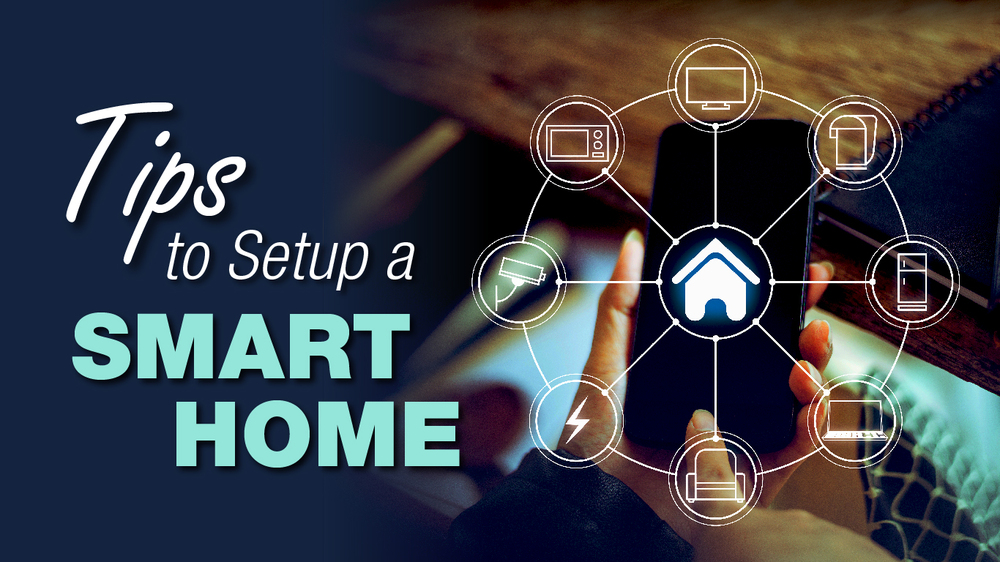 There’s something cozy about coming home to a nice, warm house, lights aglow in the window and greeted with a soothing, “Welcome, home, family!” From your genius smart house robot!
There’s something cozy about coming home to a nice, warm house, lights aglow in the window and greeted with a soothing, “Welcome, home, family!” From your genius smart house robot!
These days, the technology exists to program your home to do just about anything: maintain a certain temperature, turn lights on at a specific time of day, and even create a shopping list whose items ship directly to your door. Depending on your personal goals for “smartening up” your home, there are several major themes around which the technology is designed:
Security – Perimeter cameras, alarm systems, motion detectors, and doorbell cameras outdoors, and fire detection, internal cameras, and voice activated calls to 911 inside.
Energy efficiency – Smart thermostats, timed lighting, appliance monitoring (remotely turn off that oven you left on as you headed out), and solar panel monitoring.
Entertainment – Notifications of new releases, automatic download of gaming updates, sound design, and projection screen movements.
Best of all, each objective can be realized with minimal technical savvy, a plug and play device (a wall-mounted touchpad or a pod) and an app on your phone or laptop. Some outdoor devices may require a battery, but almost everything else is already wired into your home and just needs a little direction. You should do some research to determine which Smart Home is for you. Google Nest, Alexa by Amazon, and HomePod by Apple provide comprehensive services and a number of national and local security companies provide smart security you can install yourself (but rely on the monitoring and quick response of a trusted security firm).
As with all new technology purchases, do some self-reflection to see what you need vs. what would be overkill for you. Understand that with the low-priced hardware to get you started will come a monthly or yearly subscription for service, so be sure to budget accordingly. But once you’ve got your hub installed and your app downloaded to your device, just sit back and relax and call, “Hey Google, can you pour me some eggnog?”
October 21, 2021
Remember Cybersecurity In Device Purchasing Decisions
Buying a new device? Don’t forget to consider security in your purchasing decisions. Make cybersecurity a priority. #BeCyberSmart
October 18, 2021
Cybersecurity Awareness Month – Keep Tabs On Your Apps
Do all of your apps need to track your location? Um, no. Take a moment now to configure the privacy and security settings of your apps and, while you’re at it, help someone in your community configure theirs. Do your part. #BeCyberSmart
October 18, 2021
Cybersecurity Awareness Month – Lock Down Your Login
No matter how long and strong your passphrase is, a breach is always possible. Make it harder for cybercriminals to access your account by enabling multi-factor authentication. #BeCyberSmart
October 8, 2021
Stay Safe Online – Cybersecurity Awareness Month
Keeping our interconnected world secure requires all of us to be proactive and diligent. Learn how you can #BeCyberSmart this #CybersecurityAwarenessMonth at staysafeonline.org/cybersecurity-awareness-month/
October 1, 2021
Tips For Choosing a VPN
 The list of negative side effects of the COVID pandemic seem to be never-ending, and now we can add the explosion of cyberattacks on our home office to the list. As millions of Americans are now working from home, they send and receive sensitive information, they manipulate customer data (often personal or financial in nature), and they handle intellectual property that, if stolen, could be devastating for companies.
The list of negative side effects of the COVID pandemic seem to be never-ending, and now we can add the explosion of cyberattacks on our home office to the list. As millions of Americans are now working from home, they send and receive sensitive information, they manipulate customer data (often personal or financial in nature), and they handle intellectual property that, if stolen, could be devastating for companies.
We have explored mitigating measures in the past – keeping anti-virus software up to date, not falling for phishing expeditions, and so on – but probably the best way to keep the connection between you and your company secure is to invest in a solid Virtual Private Network (VPN) service. (In most instances, your employer’s IT department will set up the VPN for you while you’re connected to their network. If you work for yourself or simply want a more secure internet experience, you can set up a VPN on your own in under 10 minutes.)
Think of a VPN as a straight tunnel, reinforced with concrete, that connects your home computer (or laptop) to your office network. A standard internet connection, by contrast, is the 8-lane highways, detours, shoulders, and teenage drivers outside Atlanta. All your data flies free, opening your company and you up to data breaches and other cyberattacks.
While most VPNs provide the same general type of protection, there are so many to choose from that you should ask yourself the following questions to determine which service is right for you:
- Do you need to access content from international sources? Some VPNs can mask your IP location so you can access content that might be blocked otherwise.
- What browser do you use? Some VPNs only work with Google, some with Edge, some with multiple browsers and so on.
- How many services do you need? Beginners may be fine with a basic service. If you need more advanced actions like creating blacklists, find a more comprehensive service.
- What level of security do you need? If you’re handling confidential or extremely sensitive information, consider services that offer “military-grade encryption” and a kill switch that automatically severs your connection to the internet if your VPN fails.
Most VPN services are between $5 and $10/month (depending on your billing plan) and can be set up and maintained with minimal effort. But this simple fix will provide the safety and security you (and your company!) can rely on to protect what matters most.
To compare the top VPN services on the market and choose the one right for you, click HERE.
September 10, 2021
Improving Your Wellness and Tech Health
 Summer is over, the holidays are upon us, and many of us are still working from home, so the temptation is real to just let it all go. Don’t give in! Especially since September is Self-Improvement month. Use this month to learn a new language, save some money, be more organized. Or, if you want to do good for both body and mind, why not focus on your wellness AND your tech health?
Summer is over, the holidays are upon us, and many of us are still working from home, so the temptation is real to just let it all go. Don’t give in! Especially since September is Self-Improvement month. Use this month to learn a new language, save some money, be more organized. Or, if you want to do good for both body and mind, why not focus on your wellness AND your tech health?
- Update your passwords. Nothing makes a hacker’s day like breaking your password and then learning it’s the same one for your bank, your credit cards, and your social media. Get a password manager like Password Genie and update all your passwords using a combination of upper and lower case letters, numbers, and symbols – and make them varied and unguessable. Passphrases are becoming more common because they’re easier to remember and still difficult for hackers to break.
- Take a breath. Even 5 minutes of meditation, sitting quietly and breathing deeply, can lower your blood pressure, boost brain function, elevate your mood, and reduce stress. Make a point to meditate a little every day.
- Protect yourself. Anti-virus software is one of the best weapons against cyber attacks, but it’s useless if you don’t keep it current. When you get an alert to “Click for updates,” go ahead and do it – rather than hitting “Remind me later.” Better yet, use an anti-virus like SecureIT which automatically updates itself.
- Stand up and stretch out. Sitting is one of the most damaging things you can do to your body, but you can undo a lot just by standing up! Set a timer on your phone to get up every hour and go for a quick walk or do a few stretches. Open up tight hip flexors and neck and back muscles with a few key moves: https://www.runnersworld.com/health-injuries/a25136942/muscles-to-stretch-if-you-sit-all-day/
- Back up your files. Maintain file integrity – and don’t lose forever your precious photos and documents – by backing up files regularly. Consider cloud-based solutions like FileHopper Plus for daily backups as well as an external hard drive for more sensitive documents.
- Hydrate. Often, we get sucked into our work and forget to drink enough water. Staying hydrated will help with concentration, keep you full between meals, and help transport nutrients that keep you feeling energized all day.
It’s nearly impossible to get through the day without touching our technology, but if we make the effort to keep our tech safe AND put it down for a few minutes a day, we’ll all be safer and healthier for it. How’s that for self-improvement?
August 6, 2021
Tips for Getting Ready for Back to School
 Another school year, another Trapper Keeper and 1,000 pack of pre-sharpened #2 pencils to buy! But, as much of the country is getting back to some semblance of normal, the ongoing pandemic has a lot of parents and teachers scrambling to prepare for the first day. Here are some tips to keep you safe – and sane – this back to school season:
Another school year, another Trapper Keeper and 1,000 pack of pre-sharpened #2 pencils to buy! But, as much of the country is getting back to some semblance of normal, the ongoing pandemic has a lot of parents and teachers scrambling to prepare for the first day. Here are some tips to keep you safe – and sane – this back to school season:
- Shop online or off-hours: Avoid the mad dash to nab that last box of crayons by ordering online (using the list provided by your school). If you are committed to supporting local businesses, get there early and know exactly what you need.
- Stock up on masks: With kids under 12 still unvaccinated, guidance for most elementary school students will be to wear a mask while indoors. Find some cool masks and make them just another part of school clothes this fall. Check with your school and local officials regarding mask mandates and proof of vaccination requirements.
- Smile with your eyes (and don’t be afraid to reach out): Masks definitely cover up our emotions, so encourage kids to express themselves in other ways. Smile with your eyes, use hand gestures to get your point and enthusiasm across, squeeze a shoulder or fist-bump a friend or teacher who’s made your day. Getting back into a social setting will be a big shift, but don’t forget how to be an engaged human!
- Brush up on hygiene habits: Everyone eases up a little during the summer, but as we get into the colder months, remind kids to wash hands often, cough or sneeze into their elbows, and stay home if they feel at all unwell. (That Perfect Attendance ribbon is just not worth it!)
- Geek out: With many virtual options still available, creating a connected learning space for kids is dependent on up-to-date tech. A quick Google search will show you a few must-haves including:
- ChromeBook – Moderately priced laptop/tablet that allows kids to connect to their classrooms, store Word documents and images, and flip to a tablet for reading and drawing.
- Headphones – Consider the Wyze headphones that provide terrific sound AND noise-cancelling function (for multi-kid households!) for under $80.
- Organizational Apps – Getting back to a schedule after free-for-all summers is tough. Check your App Store for great apps to keep your family organized and connected this school year. Try Wunderlist, My Study Life, or iStudiez to get school projects, sports, and activities under control.
- Relax: The world is still a bit uncertain so remember to take time for yourself – and with your kids and apart from them – to just breathe. Lots of apps are available to guide you through yoga, meditation, and breathing, but you can always just take a nice walk, journal, or call a friend to talk about anything other than school.
May your return to school be smooth, your schedule be manageable, and all your lunches be Sloppy Joe’s!
July 23, 2021
Tips for Securing Your Social Media Accounts
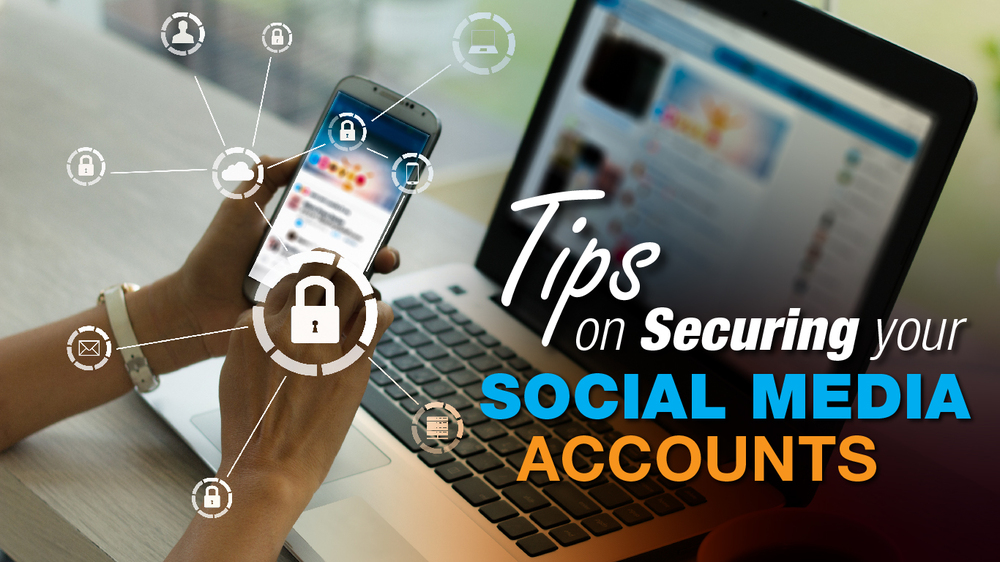 Most of us spend a large portion of our days (5 or 10 minutes at a time) using social media. We post photos, share details about ourselves and our whereabouts, take seemingly harmless quizzes, and make connections with people we only know vaguely. And, while every move we make in Facebook, Instagram, Snapchat, and even LinkedIn may seem harmless enough, each move also maximizes the opportunities for hackers and identity thieves to do real damage.
Most of us spend a large portion of our days (5 or 10 minutes at a time) using social media. We post photos, share details about ourselves and our whereabouts, take seemingly harmless quizzes, and make connections with people we only know vaguely. And, while every move we make in Facebook, Instagram, Snapchat, and even LinkedIn may seem harmless enough, each move also maximizes the opportunities for hackers and identity thieves to do real damage.
Here’s how to protect yourself on your social media platforms:
- Create good passwords and actually use them. Just as we’ve recommended in other articles, create passwords using a combination of upper and lower-case letters, numbers, and special characters. Don’t spell out words, don’t repeat old passwords, and don’t use passwords you use on other sites. Set up security questions as well to ensure no one can access your account or change your password but you. AND, when you have the opportunity to stay logged in or “remember my password,” don’t. Not selecting this option will result in a two-factor authentication (like having a text message sent to your phone with a code); this may seem annoying, but the few seconds it takes to verify your credentials may save you hours of pain and drama.
- Don’t take quizzes. Remember that app that let you upload a photo and see what you looked like as an older person? That one turned out to be created by Russian hackers to build a facial recognition database! While not all quizzes are that nefarious, they do collect information like your first car, favorite sports team, best friend… all of which can be used to cache data about you (which ultimately can be used to guess passwords).
- Review your “friends” list. We’ve all accepted friend requests from people we don’t really know well. Maybe they’re connected to someone we trust, maybe they work at a company we’re applying to. Still, it’s good practice to review your friend list periodically and remove anyone you’re not sure about; you can also use those reviews to update who sees your different types of content. Some posts/photos may be perfect for public consumption, but others should be limited to just close friends.
- Review your privacy settings monthly. As patches go out monthly, it’s a good idea to review your privacy agreement and settings for revisions. Facebook (and third-party providers) may opt you in to sharing things you might not agree with; review and opt out as necessary. Also, make sure that others can’t tag you in photos without your permission.
- Update your profile. Anyone who needs to know your birthday already knows it! Never post contact information or personal information like your birthday.
- Don’t announce your absence or track your location. It’s always nice to brag a bit on Instagram when you’re on an amazing vacation (and your co-workers aren’t!), but letting strangers know when your house will be empty is not smart. Geotagging also lets local businesses know where you are, increasing the likelihood that you will be spammed with ads or requests. You can always post those gorgeous waterfall photos in Oregon when you get home!
Staying connected is more important than ever, and social media helps us do that. But as hacking and manipulative marketing gets more sophisticated, using these few tips will help you stay social without making yourself vulnerable to attack.
July 16, 2021
Happy World Emoji Day!
 Happy World Emoji Day!
Happy World Emoji Day!
July 8, 2021
National Cell Phone Courtesy Month
 Without question, cell phones are a wondrous way to increase our connection to the people and world that surround us. However, in certain hands, those same cell phones can transform into an easy and mindless tool that would make Miss Manners blush.
Without question, cell phones are a wondrous way to increase our connection to the people and world that surround us. However, in certain hands, those same cell phones can transform into an easy and mindless tool that would make Miss Manners blush.
#CellPhoneCourtesyMonth reminds us that having a smartphone in our hands should never be an excuse for thoughtless behavior. Here are five etiquette tips for mobile phone usage to keep in mind this month, and all the others.
- Silence is golden. Be aware of the times and places when your phone should be placed on silent or turned off. This includes the library, movie theaters, church services, and work meetings. Rule of thumb: if the sound or light of your phone is going to distract or bother others, turn your phone off.
- Voices carry. We all know that person. The one who talks so loudly into his or her cell that everyone within a 25-foot radius is able to hear every word. Don’t be that person. When in public, monitor the volume of your voice so the rest of the world doesn’t have to hear your conversation.
- Think first. Cell phones offer us the opportunity to respond to emails, texts, and social media posts instantaneously. Be mindful that whatever you write can be captured in a screenshot – or a voicemail saved as an audio file – for all time. So before writing, sending, or posting anything on your phone, be sure to think: Is this appropriate? Is this kind? Will what I’ve written hurt anyone? Will I regret writing this later?
- Don’t text and drive. This is not just a matter of good cell phone etiquette but a matter of life and death. No message is THAT important. If you truly have an urgent need to call or text while driving, just pull over.
- Put people first. Sometimes, we use our cell phones as emotional support devices when we’re feeling uncomfortable in social situations. Cell phones can allow people to be in the same physical space without truly being together. Take a deep breath, put your phone in your pocket, and engage like a human. Other humans will thank you!
May 21, 2021
Tips for Choosing a 4K Smart TV
 A recent study finds that more than half (52%) of the TVs in the U.S. are smart TVs. These devices are getting less expensive every year and many manufacturers are creating their own streaming content for their hardware customers.
A recent study finds that more than half (52%) of the TVs in the U.S. are smart TVs. These devices are getting less expensive every year and many manufacturers are creating their own streaming content for their hardware customers.
First off, what is different about today’s smart TV, the 4K? The 4K stands for the nearly 4,000 horizontal pixels (and 2,160 vertical pixels) that make up this TV’s resolution; the number of pixels is about four times as many as a traditional full HD TV, meaning the picture is crisper and clearer and more “immersive” than any in history. Second, with more than 80 channels worldwide broadcasting in 4K, and new models entering the marketplace with streaming content of their own, the amount of 4K content continues to grow. This is all good news for consumers but there are some tips for how to choose, set up, and enjoy your new 4K TV:
BUYING
- Don’t compromise on upscaling. Since not all content is 4K, you’ll want a TV that “upscales” — converts lower quality images to display well on the 4K screen. Talk to your salesperson and make sure this is a priority.
- Know your priorities. Is it more important to have a huge TV or a bright picture? More important to have super user-friendly apps or access to a ton of apps? You CAN have it all — but at a price. Determine which features matter most and focus on the models that give you the most bang for the buck.
- Remember your peripherals. Will you be plugging in your video game console or an external soundbar? Plug in a cable box? Make sure your TV has enough ports to accommodate everything you’ll need to plug in.
SET-UP
- Pick your spot! Use this handy calculator to determine where to put your TV for the best viewing experience based on size of the screen: https://www.inchcalculator.com/tv-size-viewing-distance-calculator/
- Be careful mounting. Check VESA standards to be sure you’re getting mounting hardware kits that will keep your TV in place. Experts also recommend a surge protector to protect the screen from power surges.
- Update settings. Connect to the WiFi and use on-screen settings menus to complete set-up of apps. Adjust the settings to optimize different kinds of content; choose “cinematic” or “calibrate” for realistic, accurate colors for movies but turn up the “motion smoothing” option for sports to get that “on the field” experience.
- Update firmware. Before using the TV for the first time, ensure the operating system is up to date with enhancements and security fixes. Firmware updates may take up to 30 minutes to complete.
- Connect to your streaming device. Even though your TV’s apps should lead you to plenty of great content, you’ll still likely want a streaming device like the Roku Stick, Amazon Fire Stick or Cube, or the Apple TV 4K. HDMI cables will work with your 4K TV, but make sure they are “high-speed.”
A few other important considerations before making the leap:
- Price. While you can get a high quality 4K TV for $500, you can also spend more than $3,000 for the top of the line. Shop around and really pinpoint the features that matter most to you.
- Bandwidth. 4K uses a lot more data than current high resolution TVs. For example, streaming Netflix on a 1080-pixel TV uses about 3 GB per hour while a 4K TV uses about 7 GB per hour. Check to see if your usage is capped; if it is, your speed may slow considerably once you’ve hit your data limit for the month.
May 6, 2021
World Password Day
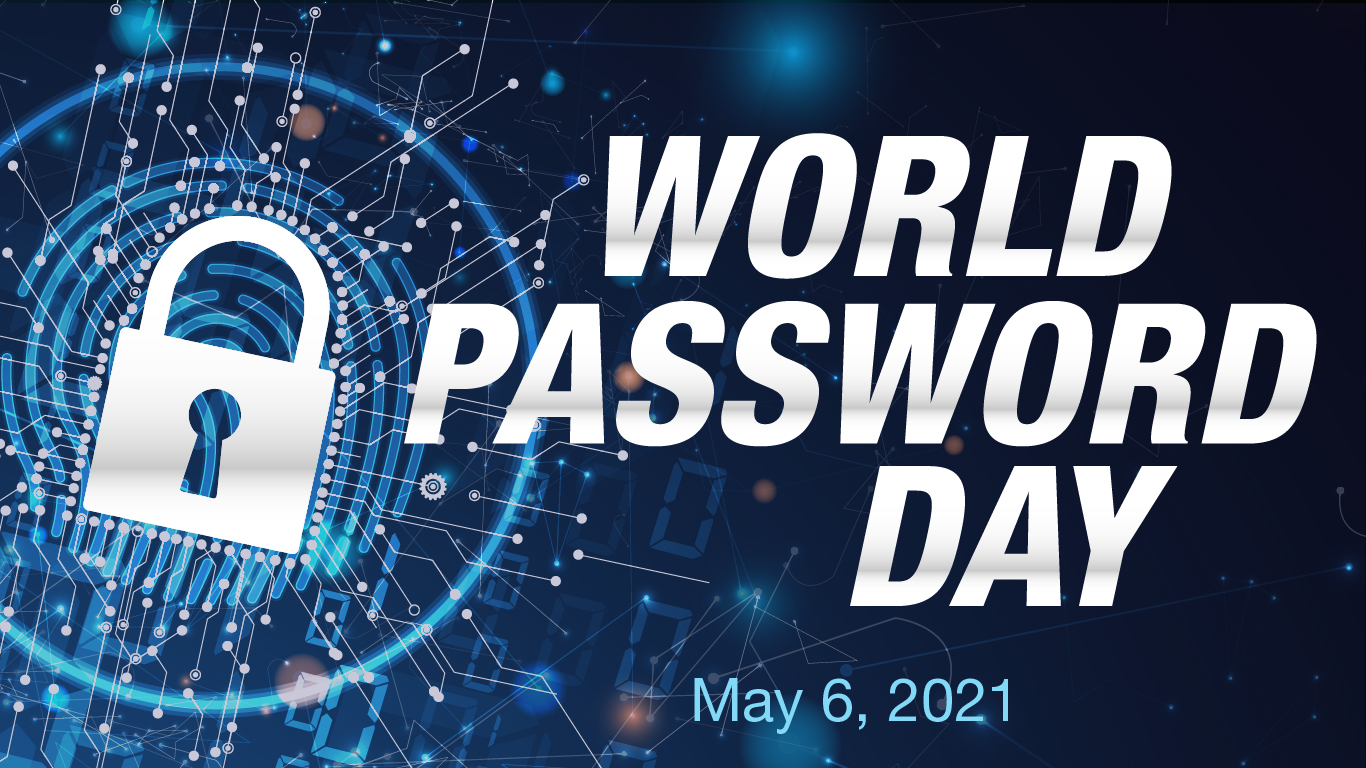 You know the scenes in action movies when the villain is able to hack the system because someone wrote his password on a sticky note and left it under his keyboard? Don’t be that guy! In honor of National Password Day, why not take stock of your passwords and reset ones that are too simple or outdated? Don’t use family or pet names. Avoid dates. Try not to use the same password on multiple sites. If you use a shared computer, don’t use autofill or “Remember my Password” options. And, if you’d rather not manage your own password maintenance (especially if you have lots and lots of passwords) try Password Genie. Password Genie will keep your digital identity secure and convenient, helping you generate strong passwords, providing 2-step verification, and keeping track of all your passwords from email and social media to banking and bill pay.
You know the scenes in action movies when the villain is able to hack the system because someone wrote his password on a sticky note and left it under his keyboard? Don’t be that guy! In honor of National Password Day, why not take stock of your passwords and reset ones that are too simple or outdated? Don’t use family or pet names. Avoid dates. Try not to use the same password on multiple sites. If you use a shared computer, don’t use autofill or “Remember my Password” options. And, if you’d rather not manage your own password maintenance (especially if you have lots and lots of passwords) try Password Genie. Password Genie will keep your digital identity secure and convenient, helping you generate strong passwords, providing 2-step verification, and keeping track of all your passwords from email and social media to banking and bill pay.
April 23, 2021
Automate Your Spring Cleaning
 The wheel. The printing press. Apollo 11. Certainly these make the list of humankind’s greatest technological achievements, but #1 on the list for procrastinators and busy housekeepers everywhere is, hands down, the robot vacuum! Just imagine: no more carrying a bulky vacuum up and down stairs, no more asking kids and spouses to “please lift your legs.” Instead, with today’s robot vacuums you really can set it and forget it and you’ll never have to trap dust bunnies again.
The wheel. The printing press. Apollo 11. Certainly these make the list of humankind’s greatest technological achievements, but #1 on the list for procrastinators and busy housekeepers everywhere is, hands down, the robot vacuum! Just imagine: no more carrying a bulky vacuum up and down stairs, no more asking kids and spouses to “please lift your legs.” Instead, with today’s robot vacuums you really can set it and forget it and you’ll never have to trap dust bunnies again.
Here’s how to choose the right one for you:
The market is full of options and not every robot is right for every household. Do you have more carpet or more hardwood (some do both, some only hardwood)? Do you want it to unload its dustbin while charging or will you empty it yourself? Do you want it to sync with your Alexa or Google Home or are you happy to control it on your phone? Is it more important to have a robot that runs quiet or one with amazing suction (looking at you, pet owners)? And of course, you’ll want to pick a model that fits your budget. Robot vacuums run from $200 to well over $1,000, so, while you don’t want to skimp (and end up sweeping yourself!), if you don’t need the one with LED lights and music, don’t waste your money! Try https://bestreviews.com/best-robotic-vacuums for a list of 2021’s top models and their pros and cons.
Now you’ve got your robot! How do you put it to work? While each robot is a bit different, the basic steps of operation are the same:
- Plug in. Find a clean, uncluttered spot against a wall to plug in the robot home. Place the robot on its home to charge. Make sure it’s fully charged (about three hours) before the first use.
- Get the app. Download the robot app to your phone. Most robots provide support for both Apple and Android phones.
- Connect. Use the app to connect your robot to your home WiFi network.
- Map it. Most robots have multiple settings for how the unit will learn the nooks and crannies of your house. Check your app for options on how to “map” your home. Some robots take 3-4 practice runs before they get the hang of corners, stairs, and furniture placement.
After that, make sure to empty dustbins regularly and charge when not in use. Beyond that? Please lift your legs up and relax!
April 18, 2021
National Linemen Appreciation Day
 When Superstorm Sandy hit the United States in late October 2012, more than 6 million people in 15 states and the District of Columbia lost power, some for weeks. And, while police, firefighters, and other emergency workers came to the nation’s aid, the real unsung heroes of the recovery were the linemen. These brave men and women not only worked tirelessly for 16 hours a day to restore power and phone lines, they helped FEMA clear roads, remove debris, pull up fallen trees, and of course climb poles to rehang fallen lines – one of the most dangerous jobs in the world. In honor of their service, Congress named April 18th National Lineman Appreciation Day. So, if you see a lineman climbing a pole, give a wave and thank them for their tireless, and critical, work!
When Superstorm Sandy hit the United States in late October 2012, more than 6 million people in 15 states and the District of Columbia lost power, some for weeks. And, while police, firefighters, and other emergency workers came to the nation’s aid, the real unsung heroes of the recovery were the linemen. These brave men and women not only worked tirelessly for 16 hours a day to restore power and phone lines, they helped FEMA clear roads, remove debris, pull up fallen trees, and of course climb poles to rehang fallen lines – one of the most dangerous jobs in the world. In honor of their service, Congress named April 18th National Lineman Appreciation Day. So, if you see a lineman climbing a pole, give a wave and thank them for their tireless, and critical, work!
April 9, 2021
Tech Tips To Protect Your Tax Filing Data
 Procrastinators rejoice! The IRS has extended the filing date for many of us. Be sure to double check with your state tax agencies here for specific dates as not all states are handling tax season the same: https://www.taxadmin.org/state-tax-agencies. Here are a few tips to make sure you don’t miss a beat (or get scammed) when you pay your taxes—or get your refund!
Procrastinators rejoice! The IRS has extended the filing date for many of us. Be sure to double check with your state tax agencies here for specific dates as not all states are handling tax season the same: https://www.taxadmin.org/state-tax-agencies. Here are a few tips to make sure you don’t miss a beat (or get scammed) when you pay your taxes—or get your refund!
- Don’t procrastinate. Especially if your taxes are very complicated, or you are using an accountant or service to complete your taxes, try to gather your paperwork as soon as possible to avoid any traffic jams caused by other procrastinators!
- Don’t fall for phishing schemes. The IRS will never request personal data like Social Security Numbers or bank account details via email or phone. Be wary of emails with subjects like “IRS Refund!” Doublecheck any links before clicking; instead check your bank account regularly for deposits.
- Do use direct deposit. Old school thieves still steal checks out of mailboxes, so when possible, opt for direct deposit of your refund check. This method is more secure and easier to manage if a fraudulent deposit is made into your account.
- Don’t send personal information via email. If you are relying on a professional to prepare your taxes, try to use a secure portal (a branded website whose address starts with “https”) rather than just emailing attachments. Any document that includes SSN, date of birth, or bank details should be sent encrypted or delivered by hand to your preparer.
- Do visit the IRS website for updates on new scams. Sadly, new scams including mail, phone, and email pop up all too regularly. Check the IRS website here for scams to watch out for: https://www.irs.gov/newsroom/scam-alert-irs-urges-taxpayers-to-watch-out-for-erroneous-refunds-beware-of-fake-calls-to-return-money-to-a-collection-agency
And a final very important note: If you are a sole proprietor, a partner in an S-corporation, or anyone who makes income without having an employer withhold taxes (essentially anyone who pays quarterly taxes), you must still pay your estimated tax by April 15th.
Enjoy having some extra time to file your taxes if you qualify, but take the same precautions you always do to make sure your taxes are paid on time and your personal data is protected!
March 4, 2021
Celebrate National Day of Unplugging
 Celebrate March 5-6, the National Day of Unplugging, by taking a break from social media – or tech in general. Studies show unplugging lowers blood pressure and puts you in a better mood, so why not cut the cord today and go for a walk? Play a team sport? Read a book (yeah, the paper kind)? Enjoy a meal with a friend without phones on the table? And, if you can find good hiding places for your kids’ devices, you can make the Great Unplug a family affair. Play a board game, bake something delicious together, or head to the park for a good old-fashioned kickball game. Be free. You’re untethered now!
Celebrate March 5-6, the National Day of Unplugging, by taking a break from social media – or tech in general. Studies show unplugging lowers blood pressure and puts you in a better mood, so why not cut the cord today and go for a walk? Play a team sport? Read a book (yeah, the paper kind)? Enjoy a meal with a friend without phones on the table? And, if you can find good hiding places for your kids’ devices, you can make the Great Unplug a family affair. Play a board game, bake something delicious together, or head to the park for a good old-fashioned kickball game. Be free. You’re untethered now!
Read more at nationaldayofunplugging.com.
February 25, 2021
How To Set Up Your Smart Watch
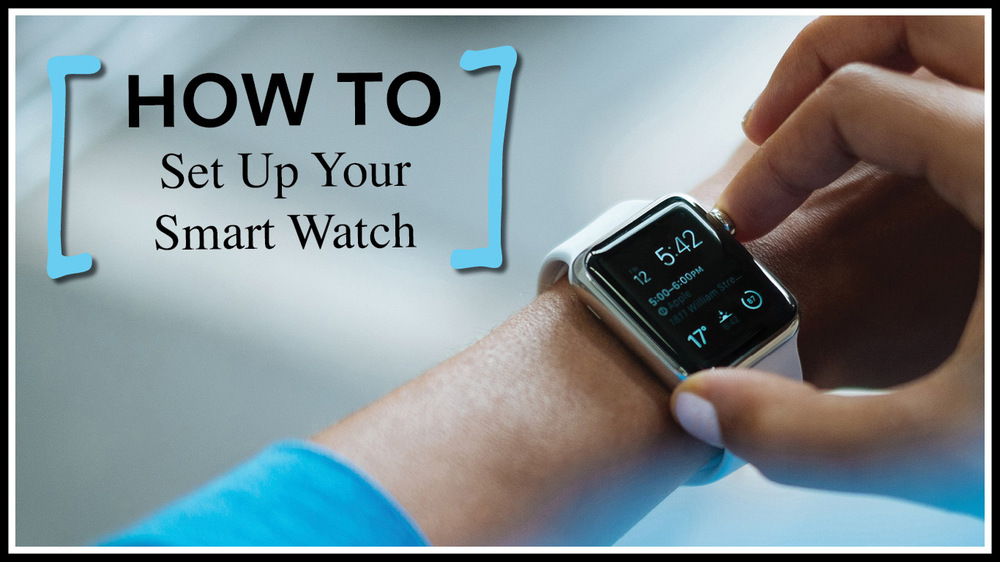 Have you stuck to your New Year’s Resolution? Have you finally unpacked that fancy stairstepper you got for Christmas and are ready to get climbing? Now may be the perfect time for you to up your fitness game by investing in a smart watch. They aren’t cheap (typically $100-500) but prices are coming down every day and they really can add value for those interested in hardcore training stats and those just looking to track steps.
Have you stuck to your New Year’s Resolution? Have you finally unpacked that fancy stairstepper you got for Christmas and are ready to get climbing? Now may be the perfect time for you to up your fitness game by investing in a smart watch. They aren’t cheap (typically $100-500) but prices are coming down every day and they really can add value for those interested in hardcore training stats and those just looking to track steps.
First, a few steps to choosing the right watch for you:
- Know your operating system. A smart watch needs a smart phone so make sure that the watch you select is compatible with your phone.
- Be realistic about what you need. If you’re a serious athlete, you may want a heartrate monitor to ensure you’re training efficiently or a GPS, but those features will cost you. If you don’t need them, don’t buy them.
- Consider if battery life matters. If you’re an endurance racer, a hybrid watch (that looks like an analog watch without a touchscreen) may work best for long runs because the battery life is longer. If you plan to interact a lot with a touchscreen, be prepared to charge your battery more often.
You’ve picked a winner so the next step is the setup! Each watch will be subtly different, and most models provide instructions in the box (and on the manufacturer’s website), but the basic steps are the same:
- Download the watch’s app to your phone.
- Turn the smartwatch on and make sure it’s fully charged.
- Typically, a menu appears asking you to confirm settings. Select language, units of measure, etc.
- Pair your watch with your phone. Go to your phone’s Settings/Bluetooth and find your smartwatch listed among the possible devices. Some pairings will require you to pull a code from your watch and select it on your phone.
- Once the phone and watch are paired, you may be prompted to begin software updates. This may take some time so make sure your phone is charged and you’re connected to the WiFi.
- When updates are complete, you may be invited to take a tutorial on how to use your new watch. Check it out to make sure you’re getting everything you can out of your new watch!
Remember that there are hundreds of watches available and the right one is out there for you. Shop around, find the one with just enough – but not more than you need – and enjoy the kickstart it will give your workouts and the motivation it will give you to take just a few more steps every day!
February 4, 2021
Black History Month 2021: Science Pioneers
 From George Washington Carver to Bettye Washington Greene to everyone’s favorite astrophysicist, Neill deGrasse Tyson, African Americans have always been a part of the fabric and foundation of the scientific community in this country. This Black History month, let’s meet three beacons in their field:
From George Washington Carver to Bettye Washington Greene to everyone’s favorite astrophysicist, Neill deGrasse Tyson, African Americans have always been a part of the fabric and foundation of the scientific community in this country. This Black History month, let’s meet three beacons in their field:
Dr. Shirley Ann Jackson – Dr. Jackson is a physicist who was the first African-American to earn a doctorate (in theoretical physics, no less) from MIT and went on to be not only the first African-American woman president of the prestigious Rensselaer Polytechnic Institute but the first to receive the National Medal of Science. She spent almost 20 years at AT&T Bell Laboratories researching solid-state and quantum physics and producing more than 100 articles and papers and paving the way for the fiber-optic cable, ubiquitous in today’s telecommunications. While she continues her work at RPI, she also serves on the Global Board of the Nature Conservancy due to her dedication to the preservation of the environment.
Otis Boykin – From an early age, Otis Boykin was fascinated by electronics. Over time, his interest focused on resistors. He tweaked existing resistors to make them more efficient and eventually invented a new resistor that could withstand shifts in temperature and air pressure. This breakthrough allowed many electronic devices to be manufactured more cheaply and reliably than ever before, making them accessible to everyone. He laid the foundation for modern televisions, computers, and even guided missiles, but he also invented a control unit for pacemakers making them safer and more precisely regulated. He patented 26 devices before his death at just 61.
Lisa Gelobter – Lisa Gelobter is a computer scientist and a technology executive who successfully intertwined her software development career with leadership at multimedia and entertainment companies such as BET Network, Brightcove, and The Feed Room. In 2015, she was invited to serve in the U.S. Digital Service at the White House to overhaul the rollout of the healthcare.gov website. She also went on to co-found tEQuitable, a company dedicated to making work more inclusive through providing a platform to address bias and discrimination in the workplace. And, finally, she set off the eternal debate: is it “jiff” or “giff”? She developed the animation used to produce the images that would one day be GIFs no one can live without!
January 28, 2021
Data Privacy Day
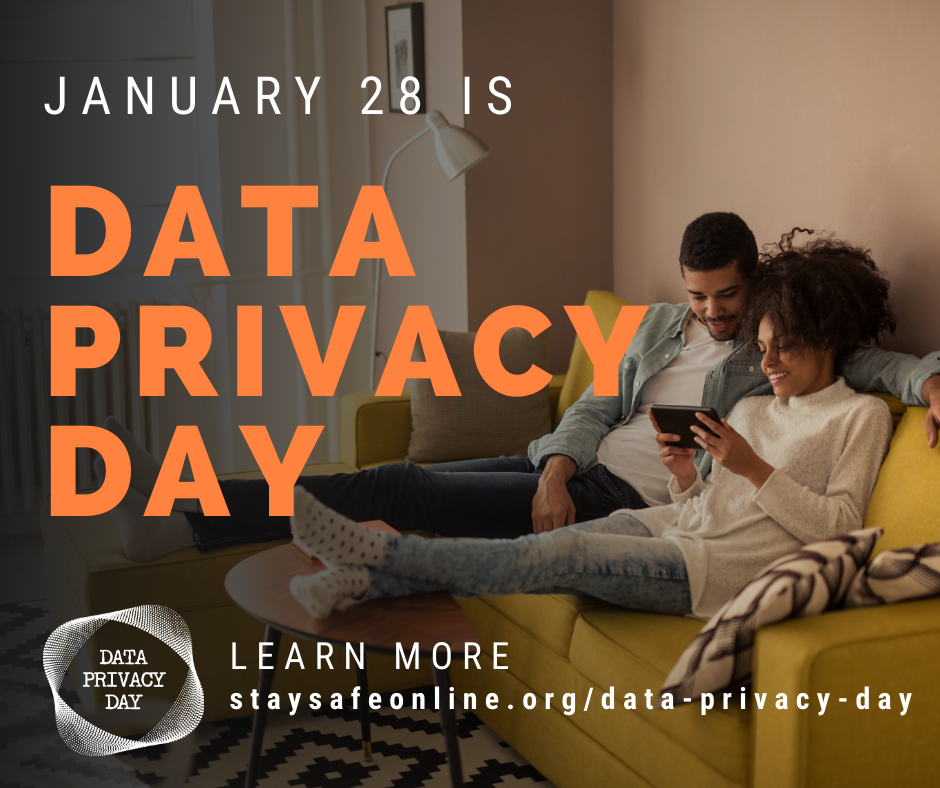 Learn how to better manage your privacy in a world of data breaches this Data Privacy Day (January 28). Stay #PrivacyAware out there! staysafeonline.org/data-privacy-day
Learn how to better manage your privacy in a world of data breaches this Data Privacy Day (January 28). Stay #PrivacyAware out there! staysafeonline.org/data-privacy-day
January 26, 2021
Hooking Up Your PS5
 Your prayers were answered! Santa delivered! Somehow, by some miracle, the new PlayStation5 is yours, all yours! If you’ve owned a PlayStation console before, much of the set-up and configuration is the same, but if you’re new to the PS game, read on and you’ll be set up in a jiffy:
Your prayers were answered! Santa delivered! Somehow, by some miracle, the new PlayStation5 is yours, all yours! If you’ve owned a PlayStation console before, much of the set-up and configuration is the same, but if you’re new to the PS game, read on and you’ll be set up in a jiffy:
1. Attach the base to the PS5 console. You can set this up vertically or horizontally.
2. Connect the console to a display device using an HDMI cable.
3. Plug the power cable into the AC IN connector of the PS5 and then plug the cable into an electrical outlet.
4. Turn on the console and follow the on-screen instructions to connect your controllers, adjust settings, and prepare to connect to the internet.
5. Connect the console to the internet.
6. Update the PS5 System Software.
7. Connect the console to the PlayStation network.
8. If you have an existing console, transfer games and data from it to the PlayStation Plus cloud storage and then to the PS5.
9. Buy a game! From the Games home, go to Playstation Store, find the game you want, select Buy > Confirm Purchase > Download. Your new game now appears in your Game Library.
10. Play!
For the extremely uninitiated, detailed instructions are available on the PlayStation website here: https://www.playstation.com/en-us/support/hardware/ps5-get-started-set-up/
Enjoy, play hard, and get out and get some air from time to time.
January 6, 2021
Tech Predictions For 2021
 It’s fair to say that no one could have predicted the year we had in 2020 considering that “murder hornets” were the least of our concerns. But with the start of 2021, we have renewed hope and optimism that this year will bring health, prosperity, and, of course, new tech! Let the prognosticating begin:
It’s fair to say that no one could have predicted the year we had in 2020 considering that “murder hornets” were the least of our concerns. But with the start of 2021, we have renewed hope and optimism that this year will bring health, prosperity, and, of course, new tech! Let the prognosticating begin:
Invest in comfy pants: Research firm Forrester predicts that remote work will rise to 300% of pre-COVID levels this coming year. While certain industries wait on pins and needles to return to their old workspace, plenty of companies are finding that they really can do their work from remote settings. This trend toward “work from anywhere” models will likely result in a decline in commercial real estate but a spike in cloud-based solutions, a rise in training and skill acquisition for remote-specific skills but a decline in the need for suit pants! Also, as we remain apart, expect innovation toward any tech that helps bring people together (virtually) and builds relationships, not just brand loyalty.
But also get yourself a new outfit: Great news towards the end of last year was that there are multiple vaccines approved which appear to be incredibly effective. That means at some point this year, we’ll all be getting back out there. As the roll-out progresses, exposure notifications and contact tracing technologies will be replaced by notifications about the status of citizens’ vaccination. As states and cities have taken over determining the order of vaccinations – and changing them – communicating where and when people can get vaccinated will become more crucial. Already, the CDC has created an app called v-safe that uses text messages and web surveys to provide personalized health check-ins after you receive your shot and reminds you when it’s time for your second shot (yes, a second shot!).
Take back your data!: One result of being stuck at home and spending all our work and leisure time online is that we have all exposed our personal data (knowingly and unknowingly) to the universe. While of course our passwords, credit card info, and other personal information is always at risk, now too are our preferences, political leanings, and habits. As Mark Surman of Mozilla Foundation says, “Why should Amazon get to know so much about our shopping habits? Why should Facebook get to create eerily accurate psychographic profiles of us?” Many in the industry envision 2021 as the year we “rebalance power,” taking control of our data, relying on leaders to explore data governance policies, and even entrusting our information to data trusts which operate as intermediators between us and big tech.
With so much in flux, companies are innovating like crazy so we’re all hopeful 2021 will be full of helpful, necessary, and (because we all need it) fun technology just waiting to be revealed. Happy new year!
December 16, 2020
Making Spirits Bright One Gig at a Time
 New tech always makes a great gift for the holidays, whether it’s a brand new phone for Mom or the coolest new tablet for the kids. Here are a few of Santa’s favorites this season!
New tech always makes a great gift for the holidays, whether it’s a brand new phone for Mom or the coolest new tablet for the kids. Here are a few of Santa’s favorites this season!
Oculus Quest 2 Virtual Reality Headset ($299) – VR has come a long way and this headset is proof that this groundbreaking tech has never been more realistic or more affordable. The Oculus Quest 2 works best for gamers, but unique games like Half Life: ALYX allow even those new to gaming to enjoy a realistic, 3D experience.
Chromecast with GoogleTV ($49) – Combining all the magic of Google streaming with the old fashioned comfort of just clicking through channels/shows/categories on an actual remote, Chromecast with GoogleTV has arrived just in time for holiday lounging! It does everything Chromecasts used to but now has Google TV smart UI built right in. Let the bingeing begin!
iPhone 12 Mini ($699) – If you’ve had it with massive phones but you still want style, speed, and function, the adorable iPhone 12 Mini may be the phone for you. It boasts a terrific camera, the same Super Retina display as its big brother, 64 GB of RAM, and water resistance up to 6 meters for 30 minutes, all in a cheerful package that is 15% smaller and 16% lighter than the iPhone 12. Good things do come in small packages!
Amazon Echo Dot ($29) – Just as chatty as the original but small enough to place one in every room, the Dot smart speaker has a few notable upgrades. An LED display shows the time and outdoor temperature, dims at night, and will fit perfectly into anyone’s stocking!
Old School/New School Emergency Radio ($29) – If you’re traveling this holiday season, the OMEW emergency radio is a very cool must have. This unit looks like an old fashioned radio but it has four charging modes (hand crank, battery, solar, and USB) so you’ll always have power. It has a super-bright flashlight, a motion sensor, an SOS alarm, and of course a radio that allows you to tune in to AM or FM weather channels.
LARQ Self-Cleaning Water Bottle ($95) – If you try to do your part by avoiding plastic water bottles but you also hate cleaning your steel or glass bottles, switch to the LARQ. Each bottle can be programmed to self-clean using a UV-C LED Light that eliminates up to 99.9% of harmful germs. You can also purify your water in as little as two hours and it stays cold for 24 hours!
Microsoft Surface Go 2 ($399) – If you’d rather not spend $600 for an iPad Air (plus $200 for the Magic Keyboard), the Surface Go 2 is for you. With 8GB of RAM and a sleek 10.5-inch display (AND keyboard included), the Surface Go is perfect for writing documents, streaming video, and browsing the web.
Phonesoap 3 UV Phone Sanitizer ($79) – This may be the perfect gift this season: a nice hot bath for your phone! The PhoneSoap 3 UV SmartPhone Sanitizer is a small case that charges and disinfects your phone. It kills nearly 100% of bacteria and germs, leaving your phone charged and pristine. Works great for keys, earbuds, and even cash.
Happy shopping, stay safe, wash your hands (and water bottles), and have the merriest of holidays and healthiest of new years!
December 9, 2020
Flashback: First Mouse Demonstration
 12/9 – On this day in 1968, an engineer and inventor named Douglas Engelbart unveiled the world’s first computer mouse in what would be dubbed The Mother of All Demos. While this groundbreaking demo was the first to showcase all elements of a modern computing system—windows, hypertexts, word processing, and even video conferencing—the introduction of the mouse was truly the marvel most people remember. Engelbart’s mouse was constructed of wood, looking like a ring box resting on two pizza cutters (rolling side to side and up and down) with a single push button on top and a long wire to plug into the computer. Since then, the mouse has evolved and come a long way, but it was Engelbart’s simple design that changed computer navigation, design, and communication forever.
12/9 – On this day in 1968, an engineer and inventor named Douglas Engelbart unveiled the world’s first computer mouse in what would be dubbed The Mother of All Demos. While this groundbreaking demo was the first to showcase all elements of a modern computing system—windows, hypertexts, word processing, and even video conferencing—the introduction of the mouse was truly the marvel most people remember. Engelbart’s mouse was constructed of wood, looking like a ring box resting on two pizza cutters (rolling side to side and up and down) with a single push button on top and a long wire to plug into the computer. Since then, the mouse has evolved and come a long way, but it was Engelbart’s simple design that changed computer navigation, design, and communication forever.
November 19, 2020
Ho! Ho! Homeshopping!
 Anyone who went shopping for Halloween decorations around October 28th may have gotten a festive shock at their local Target or Home Depot: Christmas gifts and decorations were already on the shelves! Retailers are preparing for an unusual holiday season that is already underway (kicked off on Amazon Prime Day back in October). They’re getting an early start to ensure that everyone shopping from home will be able to buy and ship gifts in time for the holidays.
Anyone who went shopping for Halloween decorations around October 28th may have gotten a festive shock at their local Target or Home Depot: Christmas gifts and decorations were already on the shelves! Retailers are preparing for an unusual holiday season that is already underway (kicked off on Amazon Prime Day back in October). They’re getting an early start to ensure that everyone shopping from home will be able to buy and ship gifts in time for the holidays.
If you typically indulge in the traditional Black Friday sales, you may be in for a very quiet day. Salesforce estimates that the $6 billion usually spent in the U.S. during Cyber Week in November was already spent in the month of October. So, are there still deals available and how will you feel fulfilled if you don’t stand in line for that toaster oven for 6 hours? A few tips to keep you sane and get everything you’re looking for:
- Splurge on online wrapping services. Remember that EVERYONE is going to be buying and shipping and the Post Office, FedEx, and UPS will be bogged down. Rather than shipping to you to wrap and ship to your loved one, pay for the gift-wrapping service and save yourself the headaches.
- Shop local. If you have local friends on your shopping list, try to patronize a local shop (likely hit hard by the pandemic). Many have websites you can shop on or curbside delivery if you know exactly what you want. Or, mask up, smile with your eyes, and let a local store know you haven’t forgotten them.
- Load your shopping cart over time. Rather than buying items from on-line sources one or two at a time, add them to your shopping cart as you think of them and try to get one big shipment assembled. This will take some of the pressure off the shippers.
- Try an online discount provider. Download Honey or Rakuten to your internet browser to automatically have discounts to thousands of online stores applied to your purchases. You may get immediate discounts or even a savings check mailed to you just in time for Boxing Day sales!
- Donate and volunteer. A lot of people have had a very bad year and many aren’t able to give their family and friends the holiday they would like. If you have the means, donate to worthy charities like Toys for Tots or Christmas Spirit Foundation (which provides Christmas trees to military families when one parent is deployed), drop off food at a local pantry, or even volunteer your time at a soup kitchen or adopt a family in need.
- Skip it all together. Of all the years to make a gift or surprise your friends and family with an experience (rather than a tangible gift), this is the one. People don’t need anything fancy. They just want to know that they are loved and that they are on your mind.
This year has been different in so many ways but some things remain the same this season of giving: be thoughtful, be kind, be charitable, and let the spirit of the holiday shine bright—even if Black Friday gets cancelled!
October 29, 2020
Flashback: ARPANET Worm Births Cybersecurity
 Flashback – 11/2/1988 – On this day in history, cybersecurity (or the need for it) was born when a Cornell student named Robert T. Morris introduced a self-replicating worm into ARPANET, the predecessor of today’s internet. Morris said the worm was designed to measure the size of ARPANET, but instead it caused denial of service for 6,000 machines, about 10% of all computers connected to ARPANET. This worm was so smart and so infectious that, before wiggling in, it checked to see if the machine was already infected – one in seven machines that had already been infected got re-infected! Morris said this was all an accident, but the courts felt differently, and Morris was the first person convicted under the Computer Fraud and Abuse Act and served three years in prison!
Flashback – 11/2/1988 – On this day in history, cybersecurity (or the need for it) was born when a Cornell student named Robert T. Morris introduced a self-replicating worm into ARPANET, the predecessor of today’s internet. Morris said the worm was designed to measure the size of ARPANET, but instead it caused denial of service for 6,000 machines, about 10% of all computers connected to ARPANET. This worm was so smart and so infectious that, before wiggling in, it checked to see if the machine was already infected – one in seven machines that had already been infected got re-infected! Morris said this was all an accident, but the courts felt differently, and Morris was the first person convicted under the Computer Fraud and Abuse Act and served three years in prison!
October 22, 2020
Cybersecurity Awareness Month: Share With Care
 Cybercriminals love it when you overshare on social media – they can learn all about you! #BeCyberSmart and make it harder for them by avoiding posting real names, places you frequent, and home, school and work locations.
Cybercriminals love it when you overshare on social media – they can learn all about you! #BeCyberSmart and make it harder for them by avoiding posting real names, places you frequent, and home, school and work locations.
October 15, 2020
Cybersecurity Awareness Month: Think Before You Click
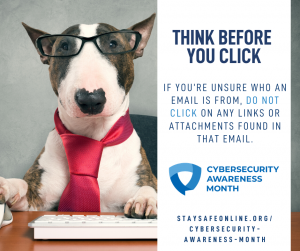 Cybercriminals cast wide nets with #phishing tactics, hoping to drag in victims. They may offer a financial reward, threaten you if you don’t engage, or claim that someone is in need of help. Stop, take a moment, and think before you click. #BeCyberSmart
Cybercriminals cast wide nets with #phishing tactics, hoping to drag in victims. They may offer a financial reward, threaten you if you don’t engage, or claim that someone is in need of help. Stop, take a moment, and think before you click. #BeCyberSmart
October 8, 2020
Cybersecurity Awareness Month: Connect It, Protect It
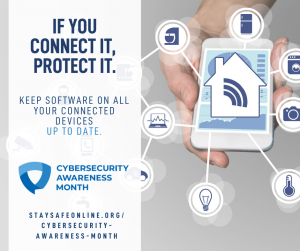 Any device that connects to the internet is vulnerable to risks. The best defense is to keep device security software, web browser and operating systems up to date. #BeCyberSmart by turning on auto-updates.
Any device that connects to the internet is vulnerable to risks. The best defense is to keep device security software, web browser and operating systems up to date. #BeCyberSmart by turning on auto-updates.
October 2, 2020
Cybersecurity Awareness Month: Stay Safe Online
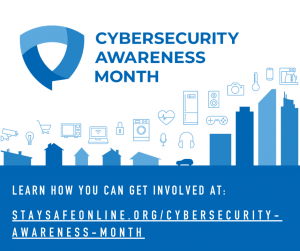 Keeping the digital world secure requires all of us to be proactive and diligent. Learn how you can #BeCyberSmart this #CybersecurityAwarenessMonth at staysafeonline.org/cybersecurity-awareness-month/
Keeping the digital world secure requires all of us to be proactive and diligent. Learn how you can #BeCyberSmart this #CybersecurityAwarenessMonth at staysafeonline.org/cybersecurity-awareness-month/
September 25, 2020
The Red, the Blue, the Tech, and You
 With an historic election just weeks away, there’s plenty of buzz about policy and personality, records and revelations, but this is also an election like no other in history because we’re in the middle of a pandemic. This means that even if you already have your heart set on a candidate, “voting” may mean something very different than strolling up to the polling station on November 3rd. The good news is there are websites and apps that will make sure you are informed, registered, and ready to vote!
With an historic election just weeks away, there’s plenty of buzz about policy and personality, records and revelations, but this is also an election like no other in history because we’re in the middle of a pandemic. This means that even if you already have your heart set on a candidate, “voting” may mean something very different than strolling up to the polling station on November 3rd. The good news is there are websites and apps that will make sure you are informed, registered, and ready to vote!
Am I Registered?
Check Vote.org. Simply enter your name and address and this site confirms if you are registered or not. If you aren’t registered, scroll down to the link or phone number for your state’s election commission and learn what to do next.
Where is my polling place? How do I vote absentee?
Each state has its own Election Commission and their websites have everything you need to know about how to vote in your state. Just a few questions you can answer here:
- What is the deadline for registering to vote?
- Can I mail in my vote? How do I request a ballot? Can I drop it off or do I have to mail it? What’s the deadline?
- Where is my polling station?
- Can I vote early in-person? Where do I go and do I need an excuse?
- Have you received my vote? Has it been tallied yet?
How do I get texts or emails from my candidate?
Easy! Simply visit the candidate’s website and sign up for how you would like to be contacted. Some candidates also allow you to select the frequency of contact.
How do I get the texts to stop?
The nearer we get to the election, the more campaigns will ramp up their communication. When you’ve had enough, just reply STOP or CANCEL or UNSUBSCRIBE.
How do I know who’s telling the truth?
We’re surrounded by opinion, spin, and hyperbole so how do we know what’s true? Download the FactStream app to fact-check claims and news. A joint effort by three of the top fact-checking organizations (Washington Post, PolitiFact, and Factcheck.org), FactStream allows you to look up claims made by candidates and even fact-check speeches and debates in real time.
It’s a crazy time, but technology is making it easier than ever to stay informed, fact-check your candidates, and most importantly get registered and make your vote count!
September 16, 2020
Sun Outages Affect TV Service In Fall, Spring
Hardy OneNet’s TV signal is affected every fall and spring by sun outages. A sun outage is an interruption or distortion of geostationary satellite signals caused by solar radiation. The problem occurs when the sun is in direct line with a communication satellite and the sun’s radiation overwhelms the satellite signal. In the Northern Hemisphere, sun outages typically occur in late September or early October after the September equinox and in late February or early March before the March equinox. Sun outages are common and can be expected at these particular times of year. Sun outages typically occur from approximately October 4 to October 12 and from February 28 to March 11. During the day from about 9 a.m. to 6 p.m. is the most common time for fall sun outages to occur. A sun outage can last for several minutes, during which time your TV signal may experience interference with picture and/or sound quality. Typically, sun outages last anywhere from two minutes to almost 11 minutes. The channels affected depend on which satellites are being impacted by the solar radiation and what channels OneNet receives from those satellites. Sun outages do not affect Internet or telephone service.
September 10, 2020
Flashback: Microchip Introduced In September 1958
 It’s hard to believe that with so much of what surrounds us today being driven by microchips, the very first microchip was not introduced to the world until 1958. On September 12, 1958, Jack Kilby demonstrated the first-ever working integrated circuit – what would become known as a microchip – to his colleagues at Texas Instruments. The U.S. Air Force was the first to buy his invention, and in 2000 he was awarded a Nobel Prize in physics for his contribution. While others improved upon this chip over the years (changing component elements and shrinking it in size), Kilby will always be known as the mind that set in motion a whole new era of computing, communicating, and even space exploration.
It’s hard to believe that with so much of what surrounds us today being driven by microchips, the very first microchip was not introduced to the world until 1958. On September 12, 1958, Jack Kilby demonstrated the first-ever working integrated circuit – what would become known as a microchip – to his colleagues at Texas Instruments. The U.S. Air Force was the first to buy his invention, and in 2000 he was awarded a Nobel Prize in physics for his contribution. While others improved upon this chip over the years (changing component elements and shrinking it in size), Kilby will always be known as the mind that set in motion a whole new era of computing, communicating, and even space exploration.
August 27, 2020
Back to School Apps That Get An A+
 Most of our kids have been inseparable from their devices this summer of quarantine, so getting them to embrace technology for school should be a breeze. Here are a few must-have apps that will make back to school fun and easy—even if “school” means the kitchen table.
Most of our kids have been inseparable from their devices this summer of quarantine, so getting them to embrace technology for school should be a breeze. Here are a few must-have apps that will make back to school fun and easy—even if “school” means the kitchen table.
Communication
Zoom – The ubiquitous app that parents use for work video calls is likely to be used by many school districts that are offering remote learning. It’s easy to download (on a computer, tablet, or even a phone) and it’s also easy to customize. You can change your profile, update how your screen appears to you, and even customize your background.
Grammarly – Nothing is worse than a term paper covered in red ink because you didn’t proof your work. This year, download Grammarly and suggestions for correcting typos, grammar mistakes, and even writing style appear in real time. You can accept or reject them, but this app will not only fix one-off mistakes but will actually help you become a better writer.
Organization
MyHomework – Cooler than a paper planner, this app helps students organize all their assignments, get reminders for due dates, and even receive rewards for finishing projects.
GoogleDocs – A great way to clean up your desktop and be able to collaborate with fellow students is to stop saving documents to your computer and start saving them to the cloud. Google provides free cloud storage that allows students to upload and edit Word documents, Excel spreadsheets, and even PowerPoints which teachers can view and teammates can edit.
Education
Flocabulary – This app and companion website rock. It uses catchy tunes and hip hop rhymes to help kids absorb everything from vocabulary to math and even has songs/lessons on back-to-school jitters and bullying. Videos are available for students K-12.
Epic! – What do voracious readers do when their library is closed AND they’re out of school? Check out Epic!, an online library of over 25,000 books. Students can read books online or offline (so you can download a bunch before a long roadtrip with no WiFi) in a variety of genres from chapter books for bigger kids to graphic novels to read-to-me picture books for young readers.
Mind and Body Motivation
GoNoodle Kids – Perfect for kids stuck at home with no recess, this app encourages kids to get up and move around throughout the day, starting the morning off with blood-pumping stretches and checking in to encourage breathing when stress levels might be rising.
Headspace – School is stressful enough for little people and Headspace can help kids manage the additional anxiety and unknowns of a remote learning experience. It uses cool cartoon videos that lead kids through meditations they can use to manage anxiety and stress.
Even though kids may be trading in uniforms for jammies and lunch with friends for lunch with family, now you have the tools to make this school year a success! Just remember to stay connected, proof your work, and get outside when algebra gets you down!
August 20, 2020
Back to School Tech Finds for Parents
 This time last year, parents were racing to wrap up school supply shopping, buying uniforms, and packing lunchboxes. And although this year there will be fewer worries about transportation or picking out the perfect school outfit, parents can still use a hand with staying on top of homework, activities, and general wellness. Here are a couple of great tools to keep you sane!
This time last year, parents were racing to wrap up school supply shopping, buying uniforms, and packing lunchboxes. And although this year there will be fewer worries about transportation or picking out the perfect school outfit, parents can still use a hand with staying on top of homework, activities, and general wellness. Here are a couple of great tools to keep you sane!
Health and Wellness
- WebMD – Who wants to sit in a doctor’s office with everything else going on? WebMD allows you to research symptoms and possible treatment for small medical emergencies or colds from the comfort of your home.
- Heal – Many health insurance companies provide teledoc services, but if you are uninsured or need to reach someone without an appointment, this app directs you to a health call center or on-call doctor to help diagnose illness or direct you to seek in-person care.
- Talkspace – With so much focus on physical wellness, mental health has taken a backseat during the pandemic despite the fact that many people’s anxiety and depression has worsened over the past few months. Talkspace pairs you or a family member up with a licensed therapist and provides a variety of payment structures to make sure your emotional health is taken care of.
Organization
- Timetree – You’re a parent! But you’re also likely an employee, a spouse, a coach, and a taxi driver for kids. If you need multiple calendars accessible by different groups of people, Timetree is for you. You can color code events, invite friends and colleagues to use specific calendars, and view all of your events on a single feed so nothing will slip through the cracks.
- Artkive – Yes, your sweet angels are the most amazing artists who ever lived. But when your fridge can’t handle another piece of art, use Artkive to capture that painting (certificate, report card, or other special memory) on your phone and save it by child, date, or category.
- 2Houses – The object of this app is to relieve conflict and facilitate better communication while co-parenting. It features in-app communication tools, calendars that help manage custody schedules (without sharing personal calendar entries), and helps track shared expenses throughout the month.
Faking it Till you Make it
- Photomath – Terrified by “new math”? Don’t be. Just take a picture of that undoable geometry problem, upload it to Photomath, and receive not only the answer but step-by-step directions for how to solve it. You might even learn something!
- Yummly – This app has some incredible recipes (searchable and scrollable) you can add to your calendar as well as a shopping list that ensures you have all the ingredients you need for tonight or a special occasion.
It is going to be a challenge but just remember: everyone loves mac and cheese, there’s only one Monday every week, and hardly any of us will become math experts. Best of luck!
August 6, 2020
Flashback: World Wide Web Project Begins
 With more than 1.74 billion websites in the world as of January 2020, it’s hard to remember a time before the World Wide Web, but this network is only 29 years old. On August 6, 1991, English computer scientist Tim Berners-Lee posted the first information about the WorldWideWeb project to a message board, inviting open and free participation from anyone who had something to add. This simple message kicked off the collaboration, research, communication, commerce, and – let’s face it – satisfying time-wasting we know today as the internet. Employers watching the clock may curse you, Sir Berners-Lee, but the rest of us send you a big heart emoji today!
With more than 1.74 billion websites in the world as of January 2020, it’s hard to remember a time before the World Wide Web, but this network is only 29 years old. On August 6, 1991, English computer scientist Tim Berners-Lee posted the first information about the WorldWideWeb project to a message board, inviting open and free participation from anyone who had something to add. This simple message kicked off the collaboration, research, communication, commerce, and – let’s face it – satisfying time-wasting we know today as the internet. Employers watching the clock may curse you, Sir Berners-Lee, but the rest of us send you a big heart emoji today!
July 30, 2020
Apps, Gear That Make Summer Workouts A Breeze
 With record heat across the nation, it’s just too hot for running and even cycling outside. And since many gyms still remain closed, many fitness fiends (and average Joes!) are looking for ways to stick to their routine. While some options are pricier than others, there are lots of ways to stay healthy and be cool doing it:
With record heat across the nation, it’s just too hot for running and even cycling outside. And since many gyms still remain closed, many fitness fiends (and average Joes!) are looking for ways to stick to their routine. While some options are pricier than others, there are lots of ways to stay healthy and be cool doing it:
Peloton – If you’re ready for your old Schwinn to look like a rusty Model T, give a Peloton stationary bike a try. Packages range from $2,245 and include just the bike to the family package for $2,700 which includes shoes, headphones, a mat, and all the other accouterments an indoor cyclist would need. The coolest part, though, is you can take classes from world-renowned coaches or bike to videos of the world’s greatest roads and trails.
MIRROR – While spending your workout staring into a mirror might not be your thing, you may change your mind when you meet the Mirror. Turn it on and suddenly a mirror becomes your boxing coach, your barre instructor, and your coach who tracks every movement, every wobble, and every improvement. Instructions appear in real-time on the screen to offer tips for more efficient and effective movement—just like a real coach. The Mirror starts at about $1,500 and you’ll pay a monthly fee for the coaching services, but you may never want to go back to the gym again!
Strava – This app can be used with iPhone or Android devices and syncs with heart rate monitors, GPS, or power meters to track performance metrics like a pro. You can design programs to improve your performance, review past runs and rides, and – of course – share your experiences and successes with friends. Strava bills itself as “the social network for athletes” giving die-hard racers and rookies a place to talk fitness, form unique and specialized groups, check out new routes, and congratulate each other on races well run.
PEAR – PEAR has come a long way since their first device that clipped to your shoes. Today, their suite of diagnostic and coaching tools will make you actually WANT to get out there and run. Their apps boast “adaptive coaching” telling you mid-run to “pick up the pace” or “dial it back, your heart rate is too high.” The apps are also brandable so local coaches and physical trainers can design programs and deliver them to their clients with chat features, workout plans with trainer logos, and even video clips.
Fitbit – Fitbit was the trailblazer with fitness tracking, and today it still offers an array of options and styles that track what you need without the price tag that comes with the Apple Watch and other tools. Track daily steps, workouts, nutrition, weight, and sleep, and share your progress with friends.
Whatever you choose, however hot and sluggish you feel, just get out there – or in there! – for a little exercise every day for a better, healthier you!
July 23, 2020
Flashback: IBM Introduces Personal Computer
 Flashback – July 28, 1981 – On this day 39 years ago, IBM introduced the IBM PC, a personal computer that was to revolutionize both business and home use. For $1,500, customers received 64 KB of RAM and a monochrome monitor that looked like a TV. It spoke BASIC, offered two enormous disk drives, and was accompanied by the full technical specs making it easy to operate and easy to expand, but also easy to clone. And today? An iPhone 11 (that fits in your pocket) boasts 4 GB of RAM or more than 65,000 times as much. It also operates at speeds more than 13,000 times faster than IBM’s old girl.
Flashback – July 28, 1981 – On this day 39 years ago, IBM introduced the IBM PC, a personal computer that was to revolutionize both business and home use. For $1,500, customers received 64 KB of RAM and a monochrome monitor that looked like a TV. It spoke BASIC, offered two enormous disk drives, and was accompanied by the full technical specs making it easy to operate and easy to expand, but also easy to clone. And today? An iPhone 11 (that fits in your pocket) boasts 4 GB of RAM or more than 65,000 times as much. It also operates at speeds more than 13,000 times faster than IBM’s old girl.
July 16, 2020
Staycations: This Summer’s Great Adventure With Tech
 So many plans have been put on hold or scrapped altogether this summer, but even though we can’t travel or hold big get-togethers, we can still make this summer a great one. Pop yourself a cold drink, sit back, and enjoy a vacation right in your own backyard!
So many plans have been put on hold or scrapped altogether this summer, but even though we can’t travel or hold big get-togethers, we can still make this summer a great one. Pop yourself a cold drink, sit back, and enjoy a vacation right in your own backyard!
- Explore the world. Without leaving your house, experience the sights and sounds and even the flavors of somewhere exotic. Try a program like Babbel or Rosetta Stone to learn a new language, find a Spotify station to tune into the music of your destination, and download some recipes from the place you’d love to go. And, with many museums offering free virtual tours, you can see priceless works of art without getting out of your jammies!
- Take a class. Imagine you’re back at summer school – by choice this time – and learn something new. Countless schools and universities are offering free or reduced online courses and webinars to jumpstart any academic endeavor, and YouTubers (among others) are providing how-to’s for hobbyists, crafters, musicians, and anyone willing to try something new.
- Get fit. The temptation is real to sit back and binge TV and bake another loaf of banana bread, but we all have more time than ever at home that we could use to get fit. Online fitness leaders like Beach Body and Betty Rocker are offering free online classes to kick off a new program, and most have Facebook groups to keep you motivated.
- Bake some banana bread. With all the terrific baking shows and cookbooks available right now, why not use your time at home to become a better chef? Bake something sweet and decadent or cook a big party’s worth of appetizers (and freeze whatever you can’t eat!).
- Have a Zoom barbecue. The best thing about the summer is getting together with friends. Just because we have to do it at a distance doesn’t make face-to-face time any less special. Send out email invites – as fancy as you like – to friends and family, grill up something delicious, pour a cocktail, and sit down in front of your computer to host a Zoom party or happy hour. Everyone can show off what they made, chat, and raise a glass to their loved ones. You might even try a game or even karaoke to keep the party going.
2020 is like nothing we’ve ever seen, but locked down doesn’t mean locked out of lots of fun, exciting, challenging, and delicious staycations you’ll really enjoy.
June 25, 2020
Nintendo 64 Flashback
 On June 23, 1996, the Nintendo 64 gaming console was released to great acclaim. It was the last console to use cartridges rather than CDs, and it boasted 3D capabilities and a controller that both wowed players and drove them absolutely crazy! The initial launch in Japan sold 300,000 consoles in one day, and three months later, the same number sold in the North American debut. This console became a fan favorite and was even named TIME’s Machine of the Year before being discontinued in 2002 upon the release of the GameCube.
On June 23, 1996, the Nintendo 64 gaming console was released to great acclaim. It was the last console to use cartridges rather than CDs, and it boasted 3D capabilities and a controller that both wowed players and drove them absolutely crazy! The initial launch in Japan sold 300,000 consoles in one day, and three months later, the same number sold in the North American debut. This console became a fan favorite and was even named TIME’s Machine of the Year before being discontinued in 2002 upon the release of the GameCube.
June 4, 2020
A Whole New Job Hunt
 Typically, June marks the celebration of college graduation and the exciting job hunt that follows. This year, graduates are still looking for work, but they will be competing for jobs in one of the toughest markets in recent history – and they’ll be doing it all remotely. Finding work, especially if you’re starting from scratch or changing industries, is always a challenge, but doing it in these unprecedented times may feel impossible. Don’t panic! Here are a few tricks of the trade that will help you set yourself apart, prepare for your interview, make a great impression, and land the job of your dreams!
Typically, June marks the celebration of college graduation and the exciting job hunt that follows. This year, graduates are still looking for work, but they will be competing for jobs in one of the toughest markets in recent history – and they’ll be doing it all remotely. Finding work, especially if you’re starting from scratch or changing industries, is always a challenge, but doing it in these unprecedented times may feel impossible. Don’t panic! Here are a few tricks of the trade that will help you set yourself apart, prepare for your interview, make a great impression, and land the job of your dreams!
Network. This may seem tough when you can’t go to job fairs or seek out informational interviews in person, but quarantining shouldn’t keep you from reaching out virtually. Start with LinkedIn. Grow your first-level network and then see who’s friends with your friends. You may be surprised to find someone a step or two away who works at the company where you’d love to work. Read articles or blogs written by their employees, find something that resonates with you, and reach out.
Know what you want. Do you want to travel? Are you willing to move? Work odd hours or keep traditional hours? Do you want a job you can do quietly by yourself or work with a large team? If anything in an ad or a call with a recruiter gives you pause – and it’s not something you can negotiate away – move on.
Compromise. With the above advice in mind, if you don’t have the luxury of waiting around for the perfect job – student loan repayment starts 6 months after graduation – and you receive an offer you can stomach, don’t let the perfect be the enemy of the good. Graciously accept the offer but keep looking elsewhere. Worst case, you get some solid experience and make some good contacts. Best case, you learn to love the job!
Make yourself irresistible. If the job hunt is dragging, use your time to beef up your resume. Get certified, take some free classes online, read everything you can about your desired industry. That way, when you do get an interview, you’ll have interesting things to say and a breadth of knowledge that will set you apart.
Prepare to Zoom. You may not be able to interview in person so make sure you’re ready to interview via video conference or phone. Get a haircut, put on a suit (top and bottom), and pick a professional background. And, if you end up interviewing by phone, here’s an old salesman trick: Keep a mirror on your desk and keep good eye contact with yourself during the call. Nod, smile, look pensive. The interviewer will pick up on these non-verbal cues and you’ll transform a potentially robotic phone call into a friendly, engaging chat with a future employee.
Best of luck. You’ve got this!
May 14, 2020
The Birth of Wireless
 The year is 1894. More than 3,000 Pullman Car Company workers lead one of the world’s biggest strikes to date. The International Olympic Committee is founded in Paris. And you can finally buy Coca Cola in a bottle for the first time! But most importantly, on May 10th of this year, physicist Guglielmo Marconi set in motion the technology upon which all current wireless technologies are built.
The year is 1894. More than 3,000 Pullman Car Company workers lead one of the world’s biggest strikes to date. The International Olympic Committee is founded in Paris. And you can finally buy Coca Cola in a bottle for the first time! But most importantly, on May 10th of this year, physicist Guglielmo Marconi set in motion the technology upon which all current wireless technologies are built.
On this day, 20-year-old Marconi transmitted a radio wave ¾ of a mile without the use of wires. Over the next few years, he would send signals across his family’s property, then over small bodies of water, and finally over the Bristol Channel. The adorable message that was sent and received over 8.7 miles was “Let it be so.”
Although it would take Marconi another three years to successfully deliver “ship to shore” communications—over 12 miles of ocean—the sending of a radio wave ¾ of a mile was truly the beginning for all communication we rely upon today.
May 7, 2020
Wish Mom Happy Mother’s Day With Tech
 Mother’s Day is just around the corner and guess what she wants most? Breakfast in bed of Lucky Charms and burned toast? A sculpture of Ben Franklin made entirely of macaroni? Maybe. But most likely, what she really wants is to hear your voice and see your face, especially if you’ve been apart these last few weeks. So, schedule a call. Send a fancy invitation to a Zoom call and surprise her with kids, grandkids, or friends she hasn’t seen in awhile. Sing her a song, show her that macaroni art, and make sure she knows she’s the best mom in the world.
Mother’s Day is just around the corner and guess what she wants most? Breakfast in bed of Lucky Charms and burned toast? A sculpture of Ben Franklin made entirely of macaroni? Maybe. But most likely, what she really wants is to hear your voice and see your face, especially if you’ve been apart these last few weeks. So, schedule a call. Send a fancy invitation to a Zoom call and surprise her with kids, grandkids, or friends she hasn’t seen in awhile. Sing her a song, show her that macaroni art, and make sure she knows she’s the best mom in the world.
April 30, 2020
Spring Cleaning Your Phone
 You’ve already spring cleaned your house, right? Why not keep it going by giving your phone a thorough scrub? Start by deleting old apps you never use and organize what’s left. Archive photos you want to keep and delete the rest. And finally, delete your cache and browsing history. You won’t believe how much faster your phone runs without all this dead weight. Just remember: Back up keepers to the cloud and jot down any usernames and passwords as the cache clean-up will wipe them out.
You’ve already spring cleaned your house, right? Why not keep it going by giving your phone a thorough scrub? Start by deleting old apps you never use and organize what’s left. Archive photos you want to keep and delete the rest. And finally, delete your cache and browsing history. You won’t believe how much faster your phone runs without all this dead weight. Just remember: Back up keepers to the cloud and jot down any usernames and passwords as the cache clean-up will wipe them out.
April 24, 2020
Flashback! – The Release of the World Wide Web
 It’s hard to imagine a time without the internet. When we read newspapers and watched the evening news to stay on top of world events, when we wrote letters and chatted on the phone, and when Amazon was just a river in South America.
It’s hard to imagine a time without the internet. When we read newspapers and watched the evening news to stay on top of world events, when we wrote letters and chatted on the phone, and when Amazon was just a river in South America.
But it wasn’t long ago, on April 30, 1993, when the World Wide Web went live to everyone. To ring in the internet’s 27th birthday, we can reflect on its humble beginnings and celebrate all that we’re able to do with this incredible public tool.
How well do you know the internet?
- Tim Berners initially developed the WWW as a way for scientists, developers, and academics to share knowledge quickly with colleagues around the world.
- Berners also developed the uniform resource locator (URL), HTML, and HTTP that make web development and navigation possible.
- CERN, the research lab where Berners worked, placed the WWW in the public domain and gave up all intellectual property rights.
- Microsoft released Internet Explorer in 1995 and within 10 years had over 95% of the market share of browsers.
And now? People who were never able to travel can read travel blogs, view photographs, and even do virtual tours of the world’s great cities. Friends can track down elementary school classmates, important colleagues, or even old loves. We have access to great works of literature as well as breaking news. We can ask for help with homework, cooking, directions, and job hunts. And we can view, read, engage, and share all this thanks to the good work of CERN and Sir Tim Berners 27 years ago.
April 17, 2020
Staying Productive While Working From Home
 Working from home is the new normal for a lot of us. Although there may be an adjustment period, there are some things you can do to stay focused on your job. For example, keep a routine. Get dressed and prep in the morning as if you were going to the office. Make sure you are keeping in touch with your coworkers. Limit distractions such as television or other connected devices.
Working from home is the new normal for a lot of us. Although there may be an adjustment period, there are some things you can do to stay focused on your job. For example, keep a routine. Get dressed and prep in the morning as if you were going to the office. Make sure you are keeping in touch with your coworkers. Limit distractions such as television or other connected devices.
April 2, 2020
How to Help the Community Yet Stay Connected
 The COVID-19 pandemic is certainly putting a damper on our social lives with “social distancing,” but keep in mind that phrase is really about physically keeping a distance. The good news is there are other ways to stay connected socially with your friends and family. Using social media, FaceTime, phone, text and email to talk to others not only keeps you in touch with loved ones, but it also helps the community as we all deal with this current crisis.
The COVID-19 pandemic is certainly putting a damper on our social lives with “social distancing,” but keep in mind that phrase is really about physically keeping a distance. The good news is there are other ways to stay connected socially with your friends and family. Using social media, FaceTime, phone, text and email to talk to others not only keeps you in touch with loved ones, but it also helps the community as we all deal with this current crisis.
March 26, 2020
Practice Cybersecurity At Home
 COVID-19 has led to many of us working from home. Cyber criminals are trying to capitalize on the pandemic so it is important to remember #cybersecurity best practices. Use a secure network, preferably a VPN. Be wary of unsolicited emails and links from unknown senders. Don’t share sensitive data via email or chat.
COVID-19 has led to many of us working from home. Cyber criminals are trying to capitalize on the pandemic so it is important to remember #cybersecurity best practices. Use a secure network, preferably a VPN. Be wary of unsolicited emails and links from unknown senders. Don’t share sensitive data via email or chat.
February 28, 2020
Tech Tools We Can’t Live Without
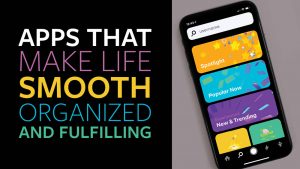 Remember the good old days when your desktop —the wooden kind, not the electronic kind! — was covered with all of your favorite tools of the trade? Your best pen, a calculator, a thesaurus, and a rotary phone to call your best colleagues and contacts? Well, now everything you need is truly at your fingertips… and inside your phone. New apps pop up all the time, but today, here are the best apps available to make your professional and personal life smooth, organized, and fulfilling:
Remember the good old days when your desktop —the wooden kind, not the electronic kind! — was covered with all of your favorite tools of the trade? Your best pen, a calculator, a thesaurus, and a rotary phone to call your best colleagues and contacts? Well, now everything you need is truly at your fingertips… and inside your phone. New apps pop up all the time, but today, here are the best apps available to make your professional and personal life smooth, organized, and fulfilling:
Vert – Traveling abroad and need to know how many Euros you can buy for 100 U.S. dollars? Not sure how many liquid ounces are in a liter? Download the Vert app and every measurement and literally every possible conversion will be at your fingertips.
Waze – GoogleMaps will get you there but Waze will get you there faster and help you avoid accidents and traffic jams. The directions are spot-on and updates happen in real time. Stay plugged in though; this app drains your battery in a hurry.
Kayak – Another great travel app, Kayak allows you to search for the best price on everything travel without having to hop from site to site. Great hotels, flights, and even vacation packages are compared side by side with just a few clicks or scrolls.
Venmo – Gone are the days when friends need to do math at the dinner table or hassle servers with multiple bills. Now, one person can pay the bill and everyone else can use the Venmo app to instantly contribute their share. Pay babysitters, contractors, or small business owners without either party paying a credit card fee or worrying about carrying cash.
LinkedIn – While traditional resumes are still the standard, more and more people find contacts, apply for jobs, and build their professional brands using LinkedIn. Post published articles and connect with peers and create a real-life network using this virtual tool.
Google Keep – Already use Gmail and Google Calendar and like the way they look and feel? Google Keep has the same vibe while providing a mechanism to capture voice memos, texts, and lists and display them in a familiar way. Share your documents and collaborate with friends and colleagues using Keep as well.
Wally – We’re all really good at spending money with our phones — online shopping, Apple Pay, automatic utility bill payments — but now there is a tool at your disposal to help you be more responsible with your money. Wally helps you set a budget, categorize expenses, save receipts, and even export data to Excel to manipulate further.
TED – When you’ve balanced your budget, booked your trip, and found the job of your dreams, sit back and relax and turn on a TED talk. More than 1,700 videos and audios are available to educate, entertain, enlighten and make you laugh. Log in and broaden your mind.
February 21, 2020
Celebrating Black History Month
 This Black History Month, let’s celebrate a few African Americans who had an incredible impact on science and technology, both yesterday and today! Mae Jemison, a doctor, was the first black woman in space. Mark Dean co-developed the IBM PC and was one of the pioneers of tablet design. Dubbed the black Thomas Edison, Granville T. Woods held over 50 patents including the multiplex railway telegraph that improved communication between stations and reduced accidents along the rails. And all the gamers out there have Jerry Lawson to thank for pioneering the video game cartridge that would serve as the precursor of Atari, Nintendo, Playstation, and other gaming systems.
This Black History Month, let’s celebrate a few African Americans who had an incredible impact on science and technology, both yesterday and today! Mae Jemison, a doctor, was the first black woman in space. Mark Dean co-developed the IBM PC and was one of the pioneers of tablet design. Dubbed the black Thomas Edison, Granville T. Woods held over 50 patents including the multiplex railway telegraph that improved communication between stations and reduced accidents along the rails. And all the gamers out there have Jerry Lawson to thank for pioneering the video game cartridge that would serve as the precursor of Atari, Nintendo, Playstation, and other gaming systems.
February 14, 2020
Valentine’s Day Tech to Fall in Love With
 Flowers fade, chocolate ruins resolutions so why not show your sweetie some love this Valentine’s Day with some to-die-for new tech? The right technology can keep you in touch with a partner who’s far from home or help you find a new love, so log in, switch on, or plug in for a tech-boosted Valentine’s to remember.
Flowers fade, chocolate ruins resolutions so why not show your sweetie some love this Valentine’s Day with some to-die-for new tech? The right technology can keep you in touch with a partner who’s far from home or help you find a new love, so log in, switch on, or plug in for a tech-boosted Valentine’s to remember.
Lovebox – This adorable wooden box looks like a simple jewelry box, but it has a mirrored top which displays messages sent by your honey. A bright red heart spins on the front when a new message has arrived. (https://en.lovebox.love/)
Kindle – If you want to share one book of sonnets, hit the local bookshop. If you want to share ALL the books of sonnets, get a Kindle. Throughout the year, you can recommend books, share delicious stanzas, and build your library together. (www.amazon.com)
Portal – Available in a wide array of sizes and functions, the Portal by Facebook is an Alexa-enabled screen that lets you video chat with friends and family, turn on some love songs, or even animate your children’s favorite bedtime stories when you can’t be there.
Smart Watches – Whether you choose an Apple Watch, a Samsung compatible watch, or the new Amazfit GTS, a smartwatch has all the makings of the perfect romantic gift. It says, “Now we can both be on time for our date,” it lets you text and chat all day, and you can even set fitness goals and keep each other on track with calorie and step counting as well as heart rate monitoring. Be still my beating heart!
Nintendo Switch – Yes, your kids will love this handheld gaming device, but your sweetheart will definitely appreciate the nostalgic vibe of games like Legend of Zelda and Super Mario. The system comes with a Joy-Con that provides a controller each for two players or you can use your wi-fi to connect two Switches for seamless fun.
But what if Valentine’s Day isn’t your cup of tea? If you’re not feeling all pink and red and prefer a few minutes to yourself this February 14th, look no further:
Fandango.com – Why not treat yourself to a movie this year? This site lets you book your seat in advance, find hard to get tickets, and get bonus points toward free tickets. Own this romantic holiday with a little sci fi fantasy or something with lots of unromantic explosions!
Skullcandy Crusher Wireless Headphones – When you just can’t take another question from your mother about how you’ll be spending your Valentine’s Day, don Skullcandy’s new noise isolating headphones that boast a full 40 hours of battery life. They come in deep red if you’re feeling festive—and blackest black if you’re not. (https://www.skullcandy.com/shop/headphones/bluetooth-headphones/crusher-wireless)
Spafinder.com – No one know what sets your heart aflutter more than you, right? Well, you and SpaFinder. Simply pick your location—local or somewhere exotic—and choose what sort of decadent service you’d like, and this site does the rest. From a mani/pedis down the road to a chakra balancing and mud bath at a spa in the Santa Catalina Mountains, this site will help you make this holiday special.
February 6, 2020
Different Types of TV and Video Services
 OTT, OTA, TV, what does it all mean? Do you know the difference between these different types of video services?
OTT, OTA, TV, what does it all mean? Do you know the difference between these different types of video services?
In today’s world of technology, video has become more of a personal preference than ever. More and more options are becoming available, and everyone has a different preferred way to watch TV. Let’s talk about the most common types of video service, and which might be right for you.
OTA (Over-the-Air): Think rabbit ears antenna television service – Local service that is delivered to your TV via antenna. While location and interference may affect reception quality, you can’t beat the price: it’s free!
Traditional Linear TV Service: Cable and satellite service has become synonymous with linear TV service. This is content that is delivered to your TV set, usually via a set top box, which gets you more channels than you would normally get through OTA service. You may also get the ability to stream shows on-demand and record live TV to watch later.
OTT (Over-the-Top): Over-the-Top service refers to any separate service that delivers content on-demand directly to your TV or other devices. This is a little different than Traditional Linear TV Service as you may have options to stream, store, and even download some shows and movies. Popular OTT services include Netflix, Hulu, Disney+, Amazon Prime, and HBO Go.
What is right for you? Well, that entirely depends on the kind of TV you like to watch. Do you want to keep up with the local news, sports, and weather? OTA or Linear Video may be right for you. Do you want to watch exclusive content, binge new shows as they release, and watch TV on your schedule? OTT is likely the best option for you.
At the end of the day, everyone has different wants and needs, and our TVs are advanced enough to provide us with exactly what we need to unwind at the end of a long day.
November 21, 2019
Cold Weather and Cell Service
 As a cold front crashes across the country, bringing with it unprecedented dips in temperature, you might be worried about how your cell service will hold up. Good news! While extreme heat distorts cell signals as well as reducing battery life, cold weather has almost no effect on cell service at all. In very cold environments, your phone may shut down or malfunction, but your service won’t be impacted at all.
As a cold front crashes across the country, bringing with it unprecedented dips in temperature, you might be worried about how your cell service will hold up. Good news! While extreme heat distorts cell signals as well as reducing battery life, cold weather has almost no effect on cell service at all. In very cold environments, your phone may shut down or malfunction, but your service won’t be impacted at all.
How about snow? Precipitation can disrupt signals. While rain is the worst culprit – because of the density of the water droplets – snow and even hail can still reflect or refract radio waves, compromising your cellular service.
If things get really rough, you can consider a booster that will increase your signal even in the most treacherous weather. That or move to San Diego where it’s dry, and not too hot and not too cold all year round!
In Hardy County, we’ve seen cell towers quit operating when the electric power is disrupted by fallen trees or ice, so it’s good to remember that your landline phone is equipped to continue operating even in the event of a power outage. Even OneNet customers, with fiber-optic connections, have a battery backup that is designed to continue phone service for at least eight hours if electrical power is lost.
October 31, 2019
Apps for Safe Trick or Treating
 Halloween is a great time for putting down the phones and just getting out into the neighborhood with friends and family. However, tons of apps are available this season that can make your holiday planning freakishly fun!
Halloween is a great time for putting down the phones and just getting out into the neighborhood with friends and family. However, tons of apps are available this season that can make your holiday planning freakishly fun!
– Nextdoor – Check your neighborhood Treat Map for street closures, events, and tips. Some neighborhoods even give residents the option to post if they are giving out candy or not.
– Life360, Glympse, Find My Friends – All these locators allow you to track your friends (or kids) if you get separated.
– YouTube – Your one-stop shop for DIY videos that walk you through making costumes, carving pumpkins, and creating killer decorations.
– Ghost Radar – For the real ghost hunters among us, use this app to detect paranormal activity. The results may be all you need to put your phone down for the night!
– The Red Cross – Moms rejoice! The Red Cross app addresses all your Halloween safety concerns: weather, first aid for kids and pets, and (to help your vampire friends) where to give blood.
Be safe and happy Halloween!
October 24, 2019
Facebook vs. Fake News
 This week, Facebook discovered that Russia (and now Iran) is back to its old tricks, working on a campaign whose mission is to disrupt the 2020 U.S. election. Facebook reported that 50 Instagram accounts and one Facebook account with almost 250,000 followers published 75,000 posts, all in an effort to perpetuate fake news stories with the hopes of influencing potential voters.
This week, Facebook discovered that Russia (and now Iran) is back to its old tricks, working on a campaign whose mission is to disrupt the 2020 U.S. election. Facebook reported that 50 Instagram accounts and one Facebook account with almost 250,000 followers published 75,000 posts, all in an effort to perpetuate fake news stories with the hopes of influencing potential voters.
Facebook disabled the accounts and has been flagging news from questionable sources since last year. But since many hold Facebook accountable for disseminating fake news, there has been a push for the tech giant to do more. They have answered the call by:
– Using a third-party fact-checking group to mark content as fake or misleading.
– Launching a program to secure state and federal officials’ accounts to ensure that only the designated user is posting on that account.
– Banning any political ad that suppresses voter turnout or that suggests people not vote or that their vote doesn’t count.
– Removing financial incentives for those directing people to fake news sites (a primary motivator by Russian trolls in 2016).
And you can take part in this crackdown! If you spot a story that just smells fishy, tap the V button at the top right of the post and select “Report this post” and then “It’s a fake news story.” If enough people do the same, the story will be verified and marked as “Disputed by Third Party Fact Checkers.”
October 17, 2019
Find the Perfect Job Using Just Your Phone!
 Yes, yes, we all know that Monster and CareerBuilder can help you find the perfect job and that these – and dozens of others – have easy-to-use apps that can help you search and apply for jobs. But how else can you use your phone to land the job meant for you?
Yes, yes, we all know that Monster and CareerBuilder can help you find the perfect job and that these – and dozens of others – have easy-to-use apps that can help you search and apply for jobs. But how else can you use your phone to land the job meant for you?
– Use social media: Update your profile to be a little more professional and reach out to contacts – even distant ones – in the industry you’re hoping to join.
– Keep a resume handy: Save your resume to Dropbox or your files so you can apply with one click. Write and upload a killer cover letter too, as resumes with cover letters tend to get more traction.
– Call someone. That’s right! Your cellphone actually makes phone calls too! Use it to reach out to your network, follow up on an application, or call a company cold. It’s so easy to get caught up in the process of applying online that we forget there really are people at the other end of the line just waiting to offer a job!
October 10, 2019
Apple iPhone 11 Boasts Major Camera Improvements
 The Apple iPhone 11 boasts some significant camera improvements over the X. One question to ask when deciding whether to upgrade is, “How much do you need an amazing camera?”
The Apple iPhone 11 boasts some significant camera improvements over the X. One question to ask when deciding whether to upgrade is, “How much do you need an amazing camera?”
If the answer is “a lot,” then the 11 might be for you. The 11 has three lenses instead of two (boasting wide, ultra-wide, and telephoto views) and all have been upgraded from 7 megapixels to 12. This means every photo is crisper and less grainy, even when blowing up a telephoto shot. AND, just on the horizon is Deep Fusion, a new image processing technique that Apple designers promise will improve detail in low and medium light.
(Hardy Telecommunications does not sell mobile phones or accessories, and the company does not officially endorse any particular brand of cellphone. For more information about the Apple iPhone 11, including technical specifications, click HERE.)
October 3, 2019
Other Cellphone Uses on Airplanes
 Mid-air cellular calls are being allowed on some international flights, but many flight attendants, pilots, and even middle-seat passengers would rather not deal with the distraction (confined space + loud talker = worst trip ever). So, what can you do with your phone besides talk on it once you turn Airplane Mode on?
Mid-air cellular calls are being allowed on some international flights, but many flight attendants, pilots, and even middle-seat passengers would rather not deal with the distraction (confined space + loud talker = worst trip ever). So, what can you do with your phone besides talk on it once you turn Airplane Mode on?
– Power up. Most flights have outlets built right into the seats. Take the opportunity to charge while you’re in your seat. It could be a long trip from the gate to your hotel!
– Text. Just remember not to use your cell network. Instead, use a messaging app like WhatsApp or Facebook Messenger that transmits using Wifi.
– Pay. Gone are the days of free peanuts and ginger ale. Keep your phone handy for when the beverage cart rolls by. Many airlines accept Apple Pay, Google Cash, and other mobile payment methods.
September 26, 2019
Cellphones at 30,000 Feet
 Just a few years ago, flight attendants forced us to stow our phones for our entire flight. Then came the advent of Airplane Mode and now we can do almost anything on our phones — except use cellular service to make voice calls or text — from takeoff to landing. But is it really safe?
Just a few years ago, flight attendants forced us to stow our phones for our entire flight. Then came the advent of Airplane Mode and now we can do almost anything on our phones — except use cellular service to make voice calls or text — from takeoff to landing. But is it really safe?
Yes! There has never been an instance of a signal from a cellphone on board a plane endangering a flight or interfering with a pilot’s instruments or communications.
So, why use Airplane Mode at all? Think of it as a courtesy for your non-flying friends on the ground. The higher a plane gets, the more towers and satellites the signal has the potential to bounce off. This can congest the network for other users. And, in addition to being gentle with your network, you may also save yourself a pile of cash because not turning on Airplane Mode can force your phone (or tablet) into Roaming Mode, which can incur hundreds of dollars by the time you reach your long distance destination!
September 20, 2019
Bring the Game To Go!
 Gimme a C! Gimme an Ellphone! What’s it Spell?
Gimme a C! Gimme an Ellphone! What’s it Spell?
Here we are in week two of both the NFL and college football seasons, and where once we were glued to our TVs for the next five months, we’re now glued to our cellphones as well. We use our cellphones to check scores, shuffle fantasy football rosters, make bets, watch instant replays, and connect with fellow fans (or hearty competitors). How has this changed our sports viewing experience?
So many ads! Every app, every sports news site, and certainly every betting site takes advantage of your fanhood to reach you when you are at your most captive.
Loyalty is rewarded. Lots of apps provide loyalty programs that provide access to discounted tickets and merchandise as well as premium content.
We stay connected. Sure, you can call your mom, the die-hard Packer fan, after the game, but it’s more fun to send her a video of an Aaron Rodgers’ touchdown on Instagram, moments after it happens.
The NFL gives us more. From instant replay following big plays, to digital (real-time) markup of screens, to delivering stats and scores directly to your phone, watching football today is a whole new ballgame.
August 29, 2019
Tools For Good
 Once upon a time, we waited all summer to be reunited with friends on the first day of school. Today, kids are able to stay in touch with friends through FaceTime, Messenger, SnapChat and a dozen other apps that make chatting, well, a snap. Now that school is starting though, parents may want to transform their kids’ phones into tools for good! Here are some apps that will help:
Once upon a time, we waited all summer to be reunited with friends on the first day of school. Today, kids are able to stay in touch with friends through FaceTime, Messenger, SnapChat and a dozen other apps that make chatting, well, a snap. Now that school is starting though, parents may want to transform their kids’ phones into tools for good! Here are some apps that will help:
1. StudyBlue – Helps create virtual flashcards
2. Cozi – Develops color-coded schedules families can use to stay on top of activities
3. Duolingo – Uses video game-style learning to teach foreign languages
4. Studious – Manages class schedules, tracks homework assignments, and alerts students when a deadline is approaching
August 22, 2019
Back to School Sleep Cheat Sheet
 Summer is a free for all when it comes to schedules, especially sleep schedules. But studies have shown that academic performance and overall health improve with regular, deep sleep, and that the blue light emitted by TVs, laptops, and cellphones slows the release of melatonin, disrupting peaceful sleep. A few tips for ensuring that sleep gets as much attention as studying this year:
Summer is a free for all when it comes to schedules, especially sleep schedules. But studies have shown that academic performance and overall health improve with regular, deep sleep, and that the blue light emitted by TVs, laptops, and cellphones slows the release of melatonin, disrupting peaceful sleep. A few tips for ensuring that sleep gets as much attention as studying this year:
1. Set a Do Not Disturb so no calls or texts can be received too late.
2. Use your Settings to schedule a change in screen light from blue to warmer hues at least two hours before bedtime.
3. Charge your phone in the kitchen and use an alarm clock in the bedroom instead. This ensures a physical break from messages and alerts and eliminates the chance that random bursts of light will disrupt sleep.
August 8, 2019
Staying Connected During Storm Season
 As we near the middle of hurricane, late summer storm, and even tornado season, it’s important to plan for the worst. While there’s not much we can do about power lines and cell towers, you CAN stay connected and powered up even during bad weather.
As we near the middle of hurricane, late summer storm, and even tornado season, it’s important to plan for the worst. While there’s not much we can do about power lines and cell towers, you CAN stay connected and powered up even during bad weather.
Stay charged up! Especially if you know extreme weather is coming, charge your phone whenever you drop below 50%. Charge your laptop and keep a phone charger handy so that when your phone dies, you can charge it on your laptop. Buy a power pack so that even when you’re cut off for hours at a time, you’ve got power!
Also, we rely so heavily on apps that make life easy but require a ton of power (think Maps or Waze) that we forget there are analog alternatives. If you think you’re going to have to evacuate, use Google Maps to plot your evacuation route and print your directions. If there’s a chance you’ll need a hotel out of town, don’t wait to book it. Find a few options, make sure you can cancel if you don’t need the room, and book. Print your confirmation numbers as well as contact numbers for the hotel so you can confirm or cancel on the road.
Stay connected! We don’t remember one another’s numbers these days, so make sure to jot down a few important numbers – including your boss’s and an emergency contact who lives outside your immediate area. Text a friend or family member before you evacuate and include your time of departure, anticipated time of arrival, and route. Even if you lose connectivity, loved ones will have a general idea of your whereabouts. And finally, if cell towers fail you but wifi lives on, reach out to emergency contacts (and friends) using apps like WhatsApp, Snapchat, or Messenger.
Stay safe and don’t let the weather get you down!
August 1, 2019
Know Before You Download
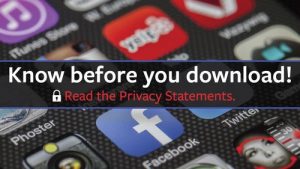 Be honest. Have you ever read a Privacy Statement start to finish before installing a new app? Most people will answer “no” and the result can range from the irritating to the devastating. Millions of people signed away permission to their photos by saying “Yes” to the FaceApp. Still more give their location to seemingly innocuous weather apps that go on to sell not just your location but your commuting and purchasing habits (based on your location). Even multi-player gaming apps log (with your permission) your location, age, Facebook ID, friends list, and any messages you exchange with fellow gamers.
Be honest. Have you ever read a Privacy Statement start to finish before installing a new app? Most people will answer “no” and the result can range from the irritating to the devastating. Millions of people signed away permission to their photos by saying “Yes” to the FaceApp. Still more give their location to seemingly innocuous weather apps that go on to sell not just your location but your commuting and purchasing habits (based on your location). Even multi-player gaming apps log (with your permission) your location, age, Facebook ID, friends list, and any messages you exchange with fellow gamers.
While privacy has certainly taken a backseat to entertainment and commerce, reviewing Privacy Statements more thoroughly may protect you from truly malicious intent. So next time you’re about to install the next best app, read the Privacy Statement thoroughly and then decide what is more important: the privacy of your location, contacts, and communications OR seeing what you’ll look like at 85.
July 18, 2019
When Cell Phones Take the Summer Off
 Noticed your cellphone slowing down? Don’t despair. Cleaning house by deleting the following will have your phone flying again:
Noticed your cellphone slowing down? Don’t despair. Cleaning house by deleting the following will have your phone flying again:
1. Old photos, videos, and text messages
2. Apps you rarely use (including pre-loaded apps or ones that run in the background)
3. Your cache
4. Internet cookies, history, and data
Remember to back up what’s important to you before deleting, and don’t delete any apps necessary to run vital functions on your phone!
If deleting stored items and apps doesn’t have a great effect on the speed of your cellphone, you might need to dig a little deeper. Most of these functions can be completed in the Settings menu:
1. Reduce the brightness of your screen.
2. Ensure software is up to date, but disable the “Automatic Updates” function.
3. Change your wallpaper from “live” to “static.”
4. Turn off Bluetooth or Wifi when you don’t need it.
5. Choose “Reduce Motion” in settings so that apps just pop on instead of using unnecessary effort and power to launch.
July 11, 2019
Protect Your Tech Devices From Summer Heat
 Summer is great for lots of things, but laptop health is not one of them. When outside temperatures approach 100 degrees, the inside of your car can reach up to 170 degrees, spelling absolute doom for your laptop. Avoid leaving laptops (or cellphones) in a hot car for more than a few minutes, and let them cool down before you turn them on.
Summer is great for lots of things, but laptop health is not one of them. When outside temperatures approach 100 degrees, the inside of your car can reach up to 170 degrees, spelling absolute doom for your laptop. Avoid leaving laptops (or cellphones) in a hot car for more than a few minutes, and let them cool down before you turn them on.
Try these tips to keep your machine cool all year long:
– Shut it down before putting it in a case. Even “sleep” mode creates heat.
– Always set up on a flat, hard surface. Soft surfaces like sofas or even your lap don’t allow for proper air flow.
– Check the vents on the bottom and blow out (or pull out with tweezers) dust or debris.
– Keep devices separate. They all put off heat, so ensure you have some space between them.
June 28, 2019
On This Day in Technology
 June 28, 1955 – Clarenville, Newfoundland – On this date, the world’s largest cable-laying ship, the HMTS Monarch, laid the very first foot of the TAT-1 telephone cable that would ultimately connect North America to Europe. By September 1956, two lines (one for each direction) ran from Clarenville to Oban, Scotland, and were able to relay a whopping 35 phone calls in either direction. This simple beginning would one day support the incredibly important “hot line” from the U.S. to the Soviet Union during the Cold War.
June 28, 1955 – Clarenville, Newfoundland – On this date, the world’s largest cable-laying ship, the HMTS Monarch, laid the very first foot of the TAT-1 telephone cable that would ultimately connect North America to Europe. By September 1956, two lines (one for each direction) ran from Clarenville to Oban, Scotland, and were able to relay a whopping 35 phone calls in either direction. This simple beginning would one day support the incredibly important “hot line” from the U.S. to the Soviet Union during the Cold War.
People were able to communicate with their European friends from as early as 1858 when a transatlantic telegraph cable was laid, and via a radio-based telephone service that launched in 1927, but calls were outrageously expensive (about $45 for a 3-minute call—over $550 in today’s dollars!). So this technology wasn’t feasible for the average American.
But, with the advent of the coaxial cable and polyethylene insulation in the 1940s, the prospect of burying cable on the ocean floor that would not degrade or lose signal became real.
The TAT-1 cables were over 1,500 nautical miles long and were laid with precision by several ships and submarines. The system continued to operate without incident until 1978 when it was replaced by a number of additional cables.
Ten years after this momentous project began, the very first signal bounced off a satellite, thereby launching global communications into a new era.
June 25, 2019
Spring Cleaning Your Tech
 You wash dishes every day. You do your laundry once a week. And every spring, you clean out the garage, get rid of old clothes, throw wide the windows and let in the breeze that blows the winter cobwebs away. But what’s the one place you spend most of your time that rarely gets this royal treatment? Your laptop! So this season, spring clean your machine like this:
You wash dishes every day. You do your laundry once a week. And every spring, you clean out the garage, get rid of old clothes, throw wide the windows and let in the breeze that blows the winter cobwebs away. But what’s the one place you spend most of your time that rarely gets this royal treatment? Your laptop! So this season, spring clean your machine like this:
1. Tidy your desktop. Just like a real desk, you’ll always feel more productive if you start with a clean slate, so delete any shortcuts or files you never use. Organize the files you do use into folders and back up everything in the cloud or on an external drive.
2. Purge the apps. In Settings>Apps and Features, remove any programs you no longer use. Anything you haven’t used in 6 months is probably safe for removal.
3. Update protection. This means installing or updating antivirus software and spyware to protect against malware and adware that can slow the speed of your machine (or worse).
4. Update applications. We often avoid taking the time to make regular or scheduled updates, but as part of your spring cleaning, click the UPDATES AVAILABLE banners on that pop up on your most often used applications.
5. Clear the cache. Your internet browser holds a lot of data you may only need once, so clear the cache of unnecessary files, cookies, history, and plug-ins that can slow progress. You may lose some passwords that typically autofill, but the benefits of a swifter browsing experience outweigh the frustration of creating a new password. You should also review your Downloads folder. Since many files open automatically from your browser, the Downloads folder may fill up without your even noticing.
6. Dump your trash. When you’ve finished purging files, shortcuts, downloads, and unused applications, right-click your Recycle Bin icon and select Empty Recycle Bin.
7. Dust it. Dust and other particles can get into the nooks and crannies of your machine, causing keys to stick. Regularly, give the keys a blast of compressed air and run a soft cloth over the screen. Never spray liquid directly onto the machine.
June 19, 2019
Wifi 101
Bandwidth – The more devices you have connected to the internet wirelessly through a router, the more your bandwidth is spread out over multiple connections, which can result in slower speeds for each individual device. To learn more about how your number of wireless devices can impact their internet connection speed, watch this new Hardy video: HardyNet Wifi 101: Bandwidth.
Wifi 101
Router Placement – Correct router placement plays a huge part in how well your wireless devices stay connected and their connection speed. To learn what factors to consider in placing a router, watch this new Hardy video: HardyNet Wifi 101: Router Placement.
Security 101
Phishing Awareness – Many hackers first gain access to your computer or device through phishing emails – that is, emails that trick you into clicking malicious links or visiting websites that contain malware. Once that malware is downloaded to your device, hackers will look for confidential information or even control your device. Learn the signs of a phishing email by watching this new Hardy video: HardyNet Security 101: Phishing Awareness.




